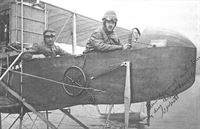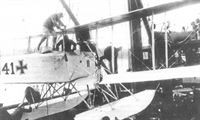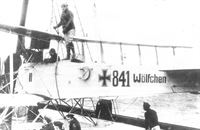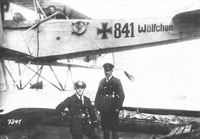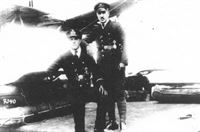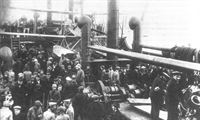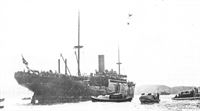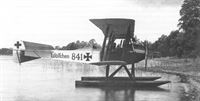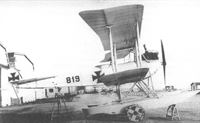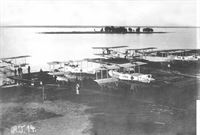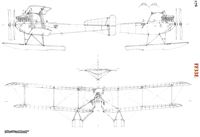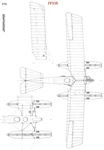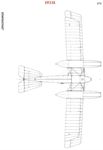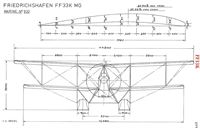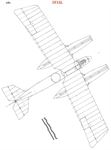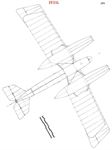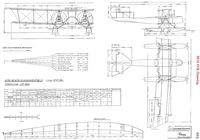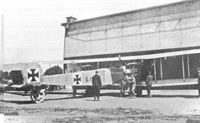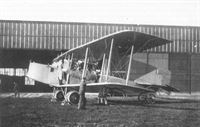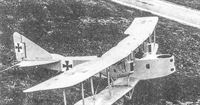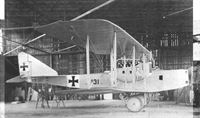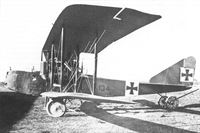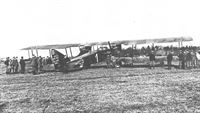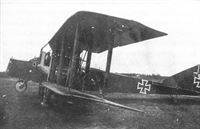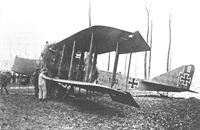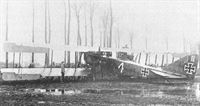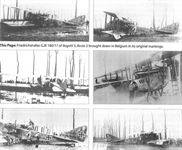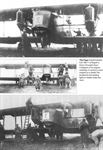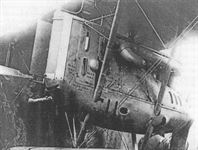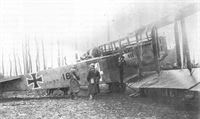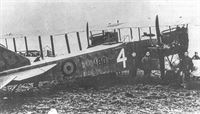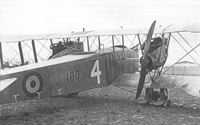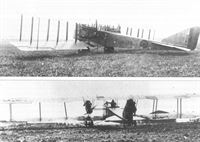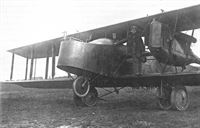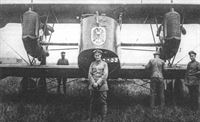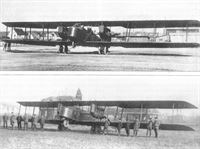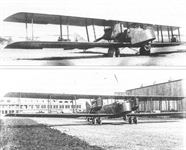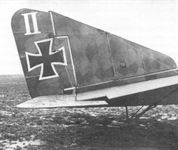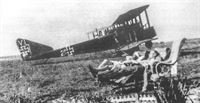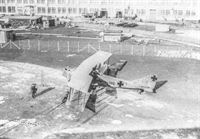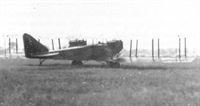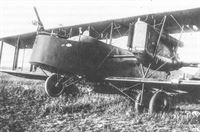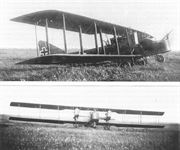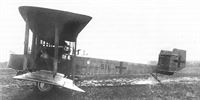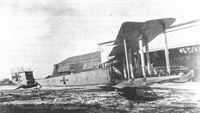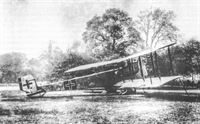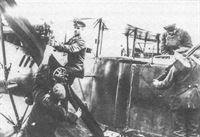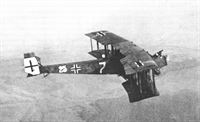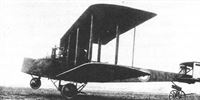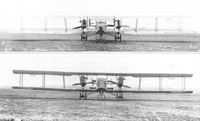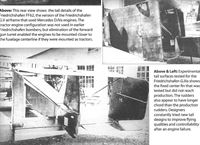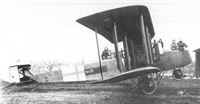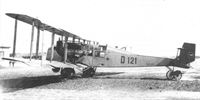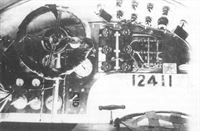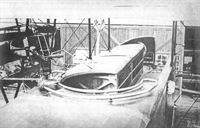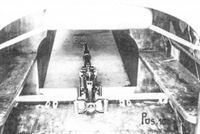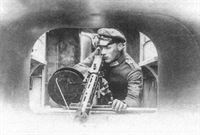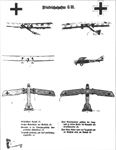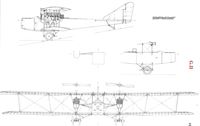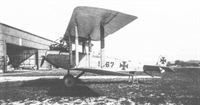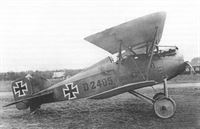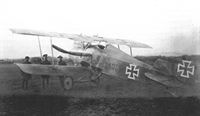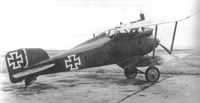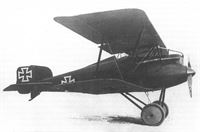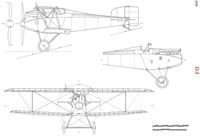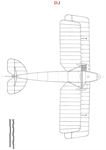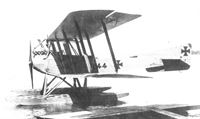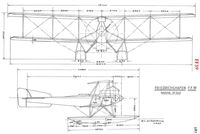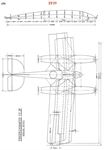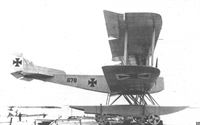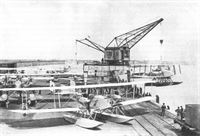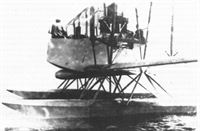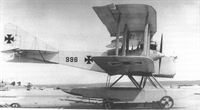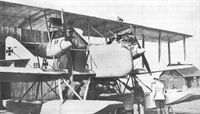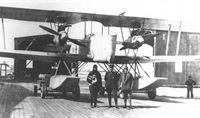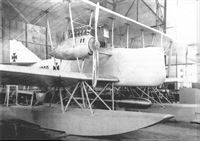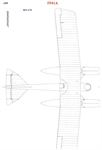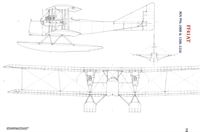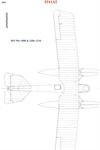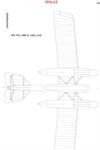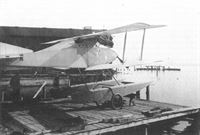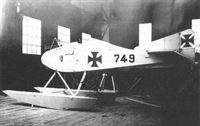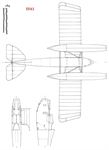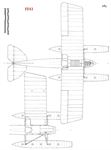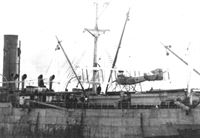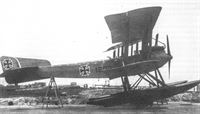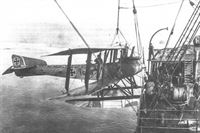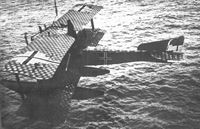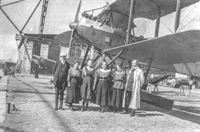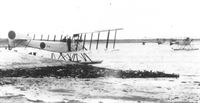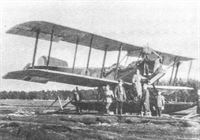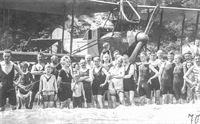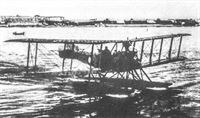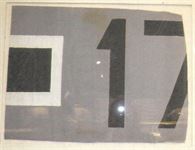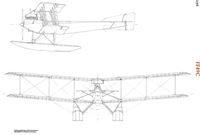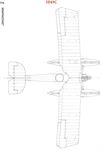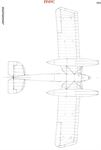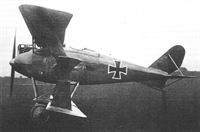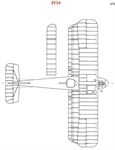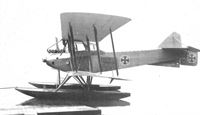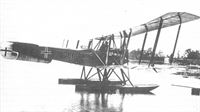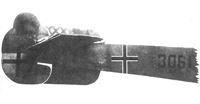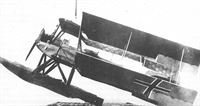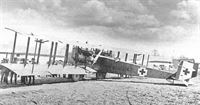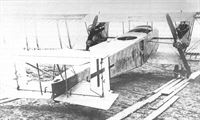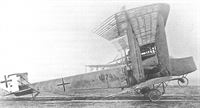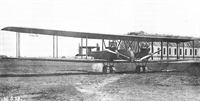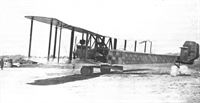Книги
Centennial Perspective
J.Herris
Friedrichshafen Aircraft of WWI
501
J.Herris - Friedrichshafen Aircraft of WWI /Centennial Perspective/ (21)
Seaplanes lined up at Windau in 1917 include at least seven Albatros W4 fighters, with Marine Numbers 911, 958, and 1107 visible on the original photo. Albatros W4 Marine #911 is the aircraft in the right background with the two circles on the fuselage. Marine #911 was the most successful Albatros W4 in the Baltic; Lt.z.S. Schulz downed three aircraft while flying it. Friedrichshafen FF33L Marine #1263, a category CHFT reconnaissance two-seater, is in the left foreground, and a similar machine is at right.
An early-production Friedrichshafen G.III - note the windows in the nose - shares the field with the Albatros D.V D1016/17 of Ltn. von der Marwitz of Jasta 30 in June 1917.
This view shows the early-production Friedrichshafen G.III is from Kampfstaffel 5. The tail of the Albatros D.V of Ltn. von der Marwitz is barely visible behind the bomber.
Friedrichshafen FF1
As indicated by its factory designation, the FF1 was the first Friedrichshafen aircraft to be built. First flight of this two-seat floatplane was in mid-November 1912. The FF1 was a biplane pusher powered by an 100 hp Argus engine, and wheels could be attached for ground handling. Initially the span of upper and lowers wings was 14.0 m and 10.0 m respectively, but later the span was enlarged to 16.8 m and 14.0 m respectively. On Feb. 14, 1913, pilot Gsell set a new flight endurance record with the FF1 by flying for 2 hours, 32 minutes, and 30 second. In February 1914 the sole FF1 built was destroyed in a crash.
Friedrichshafen FF1 Specifications
Engine: 100 hp Argus
Wing: Span Upper 14.00 m
Span Lower 11.00 m
Area 48.0 m2
General: Length 11.15 m
Height 3.35 m
Empty Weight 1,672 kg
Loaded Weight 1,972 kg
Maximum Speed: 85 km/h
Climb: 560 m 8 min
As indicated by its factory designation, the FF1 was the first Friedrichshafen aircraft to be built. First flight of this two-seat floatplane was in mid-November 1912. The FF1 was a biplane pusher powered by an 100 hp Argus engine, and wheels could be attached for ground handling. Initially the span of upper and lowers wings was 14.0 m and 10.0 m respectively, but later the span was enlarged to 16.8 m and 14.0 m respectively. On Feb. 14, 1913, pilot Gsell set a new flight endurance record with the FF1 by flying for 2 hours, 32 minutes, and 30 second. In February 1914 the sole FF1 built was destroyed in a crash.
Friedrichshafen FF1 Specifications
Engine: 100 hp Argus
Wing: Span Upper 14.00 m
Span Lower 11.00 m
Area 48.0 m2
General: Length 11.15 m
Height 3.35 m
Empty Weight 1,672 kg
Loaded Weight 1,972 kg
Maximum Speed: 85 km/h
Climb: 560 m 8 min
Friedrichshafen's first airplane design, the primitive FF1. Appropriately, it was a seaplane as were most Friedrichshafen designs. The FF1 first flew in mid-November 1912, the year that the company was founded.
Friedrichshafen FF1 with Dr. Koster handling the large pilot's control wheel.
Fdh FF1 (1912/13). In February 1913, the Imperial Navy contacted FF for the first time. Kober then designed a water biplane with a central float (mass 90 kg, volume 1250 liters). The ailerons were arranged between the wings in the Curtiss style. The FF1 was wrecked in February 1914 in front of the head of the aircraft maintenance department, Major Felix Wagenfuhr.
Fdh FF1 (1912/13). In February 1913, the Imperial Navy contacted FF for the first time. Kober then designed a water biplane with a central float (mass 90 kg, volume 1250 liters). The ailerons were arranged between the wings in the Curtiss style. The FF1 was wrecked in February 1914 in front of the head of the aircraft maintenance department, Major Felix Wagenfuhr.
The primitive Friedrichshafen's FF1 in flight. (The Peter M. Bowers Collection/The Museum of Flight)
The Friedrichshafen FF1 had a central main float that could be fitted with wheels to facilitate ground handling. Side-mounted radiators cooled the Argus engine and the ailerons were mounted between the wings.
Friedrichshafen FF2
In 1913 the second Friedrichshafen design, the FF2, made its first flight. It too was a floatplane, but had a totally different configuration than the FF1, being a tractor monoplane. A single-seater, it was smaller and less powerful than the FF1, having a 50 hp Orlikon engine. The FF2 was derived from a monoplane design by the Swiss designer Grandjean, who sold his patent to Friedrichshafen. The FF2 was built especially for the customer Ehrler from Unteruhldingen on Lake Constance. Only one FF2 was built.
Friedrichshafen FF2 Specifications
Engine: 50 hp Orlikon
Wing: Span 11.00 m
Area 48.0 m2
General: Length 9.80 m
Loaded Weight 972 kg
Friedrichshafen FF4
Apparently the FF3 design was not built, because the FF4 was the next aircraft from Friedrichshafen. The FF4 was a development of the FF2 and was built to train Ehrler, who did not compete in the 1914 Lake Competition. First flying in early February 1914, the FF4 was a more mature two-seat floatplane of tractor monoplane configuration that loosely followed the basic Taube (dove) configuration so popular in Germany at the time for its inherent stability. It was powered by a four-cylinder, 65 hp Argus. Little is known about its specifications, and the sole FF4 burned during a major fire in 1918 in the airship hangar.
Friedrichshafen FF4 Specifications
Engine: 65 hp Argus
In 1913 the second Friedrichshafen design, the FF2, made its first flight. It too was a floatplane, but had a totally different configuration than the FF1, being a tractor monoplane. A single-seater, it was smaller and less powerful than the FF1, having a 50 hp Orlikon engine. The FF2 was derived from a monoplane design by the Swiss designer Grandjean, who sold his patent to Friedrichshafen. The FF2 was built especially for the customer Ehrler from Unteruhldingen on Lake Constance. Only one FF2 was built.
Friedrichshafen FF2 Specifications
Engine: 50 hp Orlikon
Wing: Span 11.00 m
Area 48.0 m2
General: Length 9.80 m
Loaded Weight 972 kg
Friedrichshafen FF4
Apparently the FF3 design was not built, because the FF4 was the next aircraft from Friedrichshafen. The FF4 was a development of the FF2 and was built to train Ehrler, who did not compete in the 1914 Lake Competition. First flying in early February 1914, the FF4 was a more mature two-seat floatplane of tractor monoplane configuration that loosely followed the basic Taube (dove) configuration so popular in Germany at the time for its inherent stability. It was powered by a four-cylinder, 65 hp Argus. Little is known about its specifications, and the sole FF4 burned during a major fire in 1918 in the airship hangar.
Friedrichshafen FF4 Specifications
Engine: 65 hp Argus
Fdh FF2 (1913). This airplane, equipped with an Oerlikon engine, was developed from the monoplane of the Swiss Grandjean, who sold his patent for the float suspension to FF. The only airplane of this type was sold to the teacher Ehrler in Unteruhldingen. Note: Initially, the FF biplanes were given odd numbers and the monoplanes even numbers.
Built, this for a private customer, only one FF2, the second Friedrichshafen design, was constructed.
The Friedrichshafen FF2 was a small, single-seat monoplane with two floats that was built for a private customer.
Built, this for a private customer, only one FF2, the second Friedrichshafen design, was constructed.
The Friedrichshafen FF2 was a small, single-seat monoplane with two floats that was built for a private customer.
View of the Friedrichshafen FF4 training airplane built for a private customer. (The Peter M. Bowers Collection/The Museum of Flight)
Friedrichshafen FF6
The FF5 design was not built, making the next Friedrichshafen aircraft the FF6, the first Friedrichshafen land plane. The FF6 was a two-seat tractor biplane with a 2 1/2 bay wing cellule powered by an in-line, water-cooled engine, perhaps a 100 hp Argus. The FF6 was a conventional design with ailerons for roll control and one photo shows it with serial B203 on the rudder, indicating it may have been used for reconnaissance or training early in the war. As far as is known, only a single aircraft was built and no specifications have survived.
Friedrichshafen FF6 Specifications
Engine: 100 hp Argus?
The FF5 design was not built, making the next Friedrichshafen aircraft the FF6, the first Friedrichshafen land plane. The FF6 was a two-seat tractor biplane with a 2 1/2 bay wing cellule powered by an in-line, water-cooled engine, perhaps a 100 hp Argus. The FF6 was a conventional design with ailerons for roll control and one photo shows it with serial B203 on the rudder, indicating it may have been used for reconnaissance or training early in the war. As far as is known, only a single aircraft was built and no specifications have survived.
Friedrichshafen FF6 Specifications
Engine: 100 hp Argus?
View of the Friedrichshafen FF6 two-seat land plane. The tail markings (B203) below indicate the possibility it flew reconnaissance missions early in the war. (The Peter M. Bowers Collection/The Museum of Flight)
Friedrichshafen FF8
The FF7 design was not built and with their next design, the FF8, Friedrichshafen returned to a floatplane of tractor monoplane configuration. The first flight of the FF8 was in June 1913; like the earlier FF4 it used a 65 hp, four-cylinder Argus for power. Wing warping was used for roll control, but the wing did not use the Taube planform, which probably improved its performance compared to the FF4. Again only one aircraft was built.
Friedrichshafen FF8 Specifications
Engine: 65 hp Argus
Wing: Span 13.00 m
Area 22.00 m2
General: Length 11.00 m
Height 3.60 m
Loaded Weight 620 kg
Maximum Speed: 95 km/h
The FF7 design was not built and with their next design, the FF8, Friedrichshafen returned to a floatplane of tractor monoplane configuration. The first flight of the FF8 was in June 1913; like the earlier FF4 it used a 65 hp, four-cylinder Argus for power. Wing warping was used for roll control, but the wing did not use the Taube planform, which probably improved its performance compared to the FF4. Again only one aircraft was built.
Friedrichshafen FF8 Specifications
Engine: 65 hp Argus
Wing: Span 13.00 m
Area 22.00 m2
General: Length 11.00 m
Height 3.60 m
Loaded Weight 620 kg
Maximum Speed: 95 km/h
The Friedrichshafen FF8 floatplane before markings were applied. The FF8 reverted to wing-warping for roll control. One reference states the FF8 was a single-seater, although it clearly had room for a second seat in front of the pilot and it seems a passenger could have been carried. (The Peter M. Bowers Collection/The Museum of Flight)
The Friedrichshafen FF8 floatplane after markings were applied. The ground crew appear to be in the process of launching the aircraft.
Friedrichshafen FF9
With the FF9 that first flew in June 1913, Friedrichshafen returned to the pusher configuration. The FF9 strongly resembled the earlier FF1 but was larger and more powerful, using a 135 hp NAG six-cylinder engine. As with the FF1, wheels could be attached to simplify ground handling.
Pilot Dahms flew a long distance course from Manzell over Basel-Cologne-Amsterdam-Emden to Hamburg in the FF9 during the period 20-23 September 1913. However, in Blankensee the plane crashed and was badly damaged, Dahms and his passenger being injured. The FF9 was repaired and on 12 November was flown to a new world endurance record for biplanes, flying for 6 hours, 16 minutes, and 30 seconds. Like earlier Friedrichshafen aircraft, only a single example was built.
Friedrichshafen FF9 Specifications
Engine: 135 hp NAG
Wing: Span Upper 15.10 m
Span Lower 10.35 m
Area 42.0 m2
General: Length 12.00 m
Empty Weight 850 kg
Loaded Weight 1,250 kg
Maximum Speed: 115 km/h
Friedrichshafen FF15
The next Friedrichshafen aircraft design to be built was the FF15, an aircraft that owed much to the earlier FF1 and FF9. The FF15 was an improved FF9 and used the same 135 hp NAG as the FF9; other specifications were very similar.
Pilot Truckenbrodt flew the sole FF15 at the 1914 Bodensee Competition.
Friedrichshafen FF15 Specifications
Engine: 135 hp NAG
Wing: Span Upper 15.10 m
Area 42.0 m2
General: Length 12.00 m
Empty Weight 850 kg
Loaded Weight 1,270 kg
Maximum Speed: 115 km/h
With the FF9 that first flew in June 1913, Friedrichshafen returned to the pusher configuration. The FF9 strongly resembled the earlier FF1 but was larger and more powerful, using a 135 hp NAG six-cylinder engine. As with the FF1, wheels could be attached to simplify ground handling.
Pilot Dahms flew a long distance course from Manzell over Basel-Cologne-Amsterdam-Emden to Hamburg in the FF9 during the period 20-23 September 1913. However, in Blankensee the plane crashed and was badly damaged, Dahms and his passenger being injured. The FF9 was repaired and on 12 November was flown to a new world endurance record for biplanes, flying for 6 hours, 16 minutes, and 30 seconds. Like earlier Friedrichshafen aircraft, only a single example was built.
Friedrichshafen FF9 Specifications
Engine: 135 hp NAG
Wing: Span Upper 15.10 m
Span Lower 10.35 m
Area 42.0 m2
General: Length 12.00 m
Empty Weight 850 kg
Loaded Weight 1,250 kg
Maximum Speed: 115 km/h
Friedrichshafen FF15
The next Friedrichshafen aircraft design to be built was the FF15, an aircraft that owed much to the earlier FF1 and FF9. The FF15 was an improved FF9 and used the same 135 hp NAG as the FF9; other specifications were very similar.
Pilot Truckenbrodt flew the sole FF15 at the 1914 Bodensee Competition.
Friedrichshafen FF15 Specifications
Engine: 135 hp NAG
Wing: Span Upper 15.10 m
Area 42.0 m2
General: Length 12.00 m
Empty Weight 850 kg
Loaded Weight 1,270 kg
Maximum Speed: 115 km/h
The Friedrichshafen FF9 was a larger, more powerful aircraft than the FF1 it resembled. Here it uses the wheels that could be extended for land operations.The text on the rudder reads 'T.F. Flugzeugbau Friedrichshafen G.m.b.H.'
The Friedrichshafen FF9 reverted to the configuration of the earlier FF1 and greatly resembled it, but was a larger, more powerful aircraft.
The Friedrichshafen FF9 attracts attention in Dusseldorf. All its structural details are exposed for examination.
The Friedrichshafen FF15 followed the configuration of the earlier FF1 and FF9. The FF15 was basically an improved FF9 and had similar specifications and engine type.
Friedrichshafen FF11
The FF10 was another unbuilt design, and next Friedrichshafen aircraft to appear was the FF11, the first Friedrichshafen flying boat. Like the FF9 it was powered by a 135 hp NAG six-cylinder engine, but this was mounted in the hull and drove a pusher propeller via a long drive shaft, enabling the propeller to be raised above the spray thrown up by the hull during take-off and landing. The Oertz yacht works built the hull for the FF11 at Reiherstieg in Hamburg; subsequent Oertz designs benefited from this connection as can be seen by looking at the Oertz flying boat designs.
First flight of the FF11 was in February 1914 and it was tested until the end of May on the Bodensee, then shipped to the SVK on 4 June 1914, receiving Marine Number 41. Like most other pre-war Friedrichshafen aircraft, only one FF11 was built.
Friedrichshafen FF11 Specifications
Engine: 135 hp NAG
Wing: Area 53.0 m2
General: Length 11.15 m
Height 3.35 m
Empty Weight 1,180 kg
Loaded Weight 1,500 kg
Maximum Speed: 90 km/h
Climb: 500 m 15 min
Friedrichshafen FF21
The FF21 was an improved version of the Friedrichshafen FF11 developed by Jaray especially for the 1914 Baltic Seaplane Competition. The 150 hp Benz Bz.III engine was built into the flying boat hull and drove the propeller via an extension shaft and bevel gear to keep the four-blade propeller up out of the spray of the hull during landing and take-off.
The flying boat hull was built by the Oertz yacht works, which had also built the FF11 hull, and was clearly related to a motorboat. Again, like most prewar Friedrichshafen aircraft, only a single FF21 was built.
Friedrichshafen FF21 Specifications
Engine: 150 hp Benz Bz.III
Wing: Span Upper 16.90 m
Span Lower 13.70 m
General: Length 11.50 m
Height 2.90 m
The FF10 was another unbuilt design, and next Friedrichshafen aircraft to appear was the FF11, the first Friedrichshafen flying boat. Like the FF9 it was powered by a 135 hp NAG six-cylinder engine, but this was mounted in the hull and drove a pusher propeller via a long drive shaft, enabling the propeller to be raised above the spray thrown up by the hull during take-off and landing. The Oertz yacht works built the hull for the FF11 at Reiherstieg in Hamburg; subsequent Oertz designs benefited from this connection as can be seen by looking at the Oertz flying boat designs.
First flight of the FF11 was in February 1914 and it was tested until the end of May on the Bodensee, then shipped to the SVK on 4 June 1914, receiving Marine Number 41. Like most other pre-war Friedrichshafen aircraft, only one FF11 was built.
Friedrichshafen FF11 Specifications
Engine: 135 hp NAG
Wing: Area 53.0 m2
General: Length 11.15 m
Height 3.35 m
Empty Weight 1,180 kg
Loaded Weight 1,500 kg
Maximum Speed: 90 km/h
Climb: 500 m 15 min
Friedrichshafen FF21
The FF21 was an improved version of the Friedrichshafen FF11 developed by Jaray especially for the 1914 Baltic Seaplane Competition. The 150 hp Benz Bz.III engine was built into the flying boat hull and drove the propeller via an extension shaft and bevel gear to keep the four-blade propeller up out of the spray of the hull during landing and take-off.
The flying boat hull was built by the Oertz yacht works, which had also built the FF11 hull, and was clearly related to a motorboat. Again, like most prewar Friedrichshafen aircraft, only a single FF21 was built.
Friedrichshafen FF21 Specifications
Engine: 150 hp Benz Bz.III
Wing: Span Upper 16.90 m
Span Lower 13.70 m
General: Length 11.50 m
Height 2.90 m
The FF21 was developed from the Friedrichshafen FF11 and looks virtually identical in side view to the Oertz F.B.1, leading one to wonder if they were indeed the same design. Oertz built the hulls for both the FF11 and FF21, and there is a great resemblance between these designs.
Friedrichshafen FF17
The FF17 floatplane was the next Friedrichshafen design built. It was a tractor, two-seat biplane with 2 1/2 bay wing cellule. Powered by a 135 hp NAG six-cylinder engine, it was the first biplane with full fuselage built by Friedrichshafen, and its first flight was in May 1914. It was built for and flown at the 1914 Bodensee competition. At first it used a central float with wingtip floats for balance, but then was converted to a pair of floats. The intention was to fly the modified aircraft in the 1914 Baltic flight competition. Like the earlier Friedrichshafen aircraft, only one was built, but it had the potential to be a reconnaissance floatplane.
Friedrichshafen FF17 Specifications
Engine: 135 hp NAG
Wing: Span Upper 15.20 m
Span Lower 10.20 m
General: Length 10.00 m
The FF17 floatplane was the next Friedrichshafen design built. It was a tractor, two-seat biplane with 2 1/2 bay wing cellule. Powered by a 135 hp NAG six-cylinder engine, it was the first biplane with full fuselage built by Friedrichshafen, and its first flight was in May 1914. It was built for and flown at the 1914 Bodensee competition. At first it used a central float with wingtip floats for balance, but then was converted to a pair of floats. The intention was to fly the modified aircraft in the 1914 Baltic flight competition. Like the earlier Friedrichshafen aircraft, only one was built, but it had the potential to be a reconnaissance floatplane.
Friedrichshafen FF17 Specifications
Engine: 135 hp NAG
Wing: Span Upper 15.20 m
Span Lower 10.20 m
General: Length 10.00 m
The Friedrichshafen FF15 followed the configuration of the earlier FF1 and FF9. The FF15 was basically an improved FF9 and had similar specifications and engine type.
The FF17 was later tested with dual main floats as the FF17B. This configuration resembled the Friedrichshafen seaplanes used during the war. (The Peter M. Bowers Collection/The Museum of Flight)
Friedrichshafen FF19
Although a later design, the FF19 actually flew in April 1914 before the FF17. It featured a three-bay biplane wing cellule that was simpler than the FF17, perhaps one reason it was flown earlier. A tractor floatplane powered by a 100 hp Mercedes D.I, it was the first Friedrichshafen pre-war design to go into limited production, a total of 16 being built.
The first FF19 order for five aircraft, Marine Numbers 25-29, was built in the period 17 May to 18 June 1914 in Kiel. The second order was for 10 aircraft, Marine Numbers 76-85, immediately after the outbreak of war. The FF19s, together with 3 Agos ordered at the same time, were then the only naval maritime aircraft capable of fulfilling a combat role. The 16th airframe was used for static load testing.
The FF19 was historically significant as the first German aircraft from which successful wireless tests were carried out.
Friedrichshafen FF19 Specifications
Engine: 100 hp Mercedes D.I
Wing: Span Upper 15.30 m
Span Lower 13.80 m
Area 48.0 m2
General: Length 10.40 m
Empty Weight 860 kg
Loaded Weight 1,160 kg
Maximum Speed: 95 km/h
Climb: 500 m 8 min
Although a later design, the FF19 actually flew in April 1914 before the FF17. It featured a three-bay biplane wing cellule that was simpler than the FF17, perhaps one reason it was flown earlier. A tractor floatplane powered by a 100 hp Mercedes D.I, it was the first Friedrichshafen pre-war design to go into limited production, a total of 16 being built.
The first FF19 order for five aircraft, Marine Numbers 25-29, was built in the period 17 May to 18 June 1914 in Kiel. The second order was for 10 aircraft, Marine Numbers 76-85, immediately after the outbreak of war. The FF19s, together with 3 Agos ordered at the same time, were then the only naval maritime aircraft capable of fulfilling a combat role. The 16th airframe was used for static load testing.
The FF19 was historically significant as the first German aircraft from which successful wireless tests were carried out.
Friedrichshafen FF19 Specifications
Engine: 100 hp Mercedes D.I
Wing: Span Upper 15.30 m
Span Lower 13.80 m
Area 48.0 m2
General: Length 10.40 m
Empty Weight 860 kg
Loaded Weight 1,160 kg
Maximum Speed: 95 km/h
Climb: 500 m 8 min
The FF19 was the first Friedrichshafen design to be produced in quantity. A total of 16 airframes were built; 15 were delivered to the Navy and one airframe was used for structural testing.
Friedrichshafen FF19 Marine Number 25 at Borkum wearing late-style insignia. Research by Frits Gerdessen reveals that, on 14 August 1914, Friedrichshafen FF19 seaplane #28 beached at Schiermonnikoog. The plane was later acquired for the Netherlands Navy and the crew, Oberleutnant zur See Hubert Waldemar Klein and Fahnrich zur See Carl Georg Philipp, was interned at Bergen. This was the first of many naval aircraft interned by the Netherlands during the war.
The first production Friedrichshafen FF19, Marine Number 25, trails a red wingtip identification streamer.
Fdh FF19 (1914). At the request of the Kaiserliche Marine, the FF.19 was developed based on the Avro biplane. The first orders (navy numbers 25-29) were placed by Kiel at the beginning of June 1914. Navy number 62 was subjected to a load test in Friedrichshafen on May 2, 1914.After a 7.02-fold safety was attested, further orders followed (navy numbers 76-85). Note: At the beginning of the war, navy numbers 25-29 were the only navy aircraft capable of front-line use apart from 3 Ago aircraft. (95 hp Mercedes engine).
Fdh FF19 (1914). At the request of the Kaiserliche Marine, the FF.19 was developed based on the Avro biplane. The first orders (navy numbers 25-29) were placed by Kiel at the beginning of June 1914. Navy number 62 was subjected to a load test in Friedrichshafen on May 2, 1914.After a 7.02-fold safety was attested, further orders followed (navy numbers 76-85). Note: At the beginning of the war, navy numbers 25-29 were the only navy aircraft capable of front-line use apart from 3 Ago aircraft. (95 hp Mercedes engine).
Friedrichshafen FF19 seaplanes 25 and 26 enjoying unusually calm sea conditions in the Heligoland Bight. They were part of a five-aircraft order placed in February 1914, harbingers of the three-bay Friedrichshafen seaplane layout that became the FF33 when powered by the 150hp Benz and the FF49 when the 200hp Benz was used. This basic design, developed over the following two years, had not been improved upon for general workaday duties by the time of the Armistice, and the later models were the most widely used reconnaissance seaplanes in service.
Friedrichshafen FF27
The final pre-war Friedrichshafen design was the FF27. The FF27 combined some characteristics of earlier Friedrichshafen designs, being a two-seat pusher biplane floatplane with a three-bay wing cellule that could have wheels attached for improved ground handling. Like several preceding Friedrichshafen aircraft, a 135 hp NAG six-cylinder engine provided the power. Although designed for the 1914 Baltic Seaplane Competition, the sole FF27 built was accepted by the SVK and assigned Marine Number 62.
Friedrichshafen FF27 Specifications
Engine: 135 hp NAG
Wing: Span Upper 14.40 m
Span Lower 13.40 m
Area 45.0 m2
General: Empty Weight 900 kg
Loaded Weight 1,100 kg
Maximum Speed: 100 km/h
Climb: 500 m 8 min
The final pre-war Friedrichshafen design was the FF27. The FF27 combined some characteristics of earlier Friedrichshafen designs, being a two-seat pusher biplane floatplane with a three-bay wing cellule that could have wheels attached for improved ground handling. Like several preceding Friedrichshafen aircraft, a 135 hp NAG six-cylinder engine provided the power. Although designed for the 1914 Baltic Seaplane Competition, the sole FF27 built was accepted by the SVK and assigned Marine Number 62.
Friedrichshafen FF27 Specifications
Engine: 135 hp NAG
Wing: Span Upper 14.40 m
Span Lower 13.40 m
Area 45.0 m2
General: Empty Weight 900 kg
Loaded Weight 1,100 kg
Maximum Speed: 100 km/h
Climb: 500 m 8 min
Friedrichshafen FF29 & FF29A
Friedrichshafen's first wartime design was the FF29, which was basically an enlarged FF19, the first Friedrichshafen aircraft that had been successful enough to be built in any quantity. The FF29 and FF29A were built as unarmed, two-seat reconnaissance floatplanes.
Production orders for the 44 aircraft actually built are somewhat complex and are summarized in the adjacent table. The first batch of 20 FF29 aircraft were ordered at the start of the war in August 1914. All subsequent batches were ordered in November 1914 and the final aircraft from this orders was delivered in September 1915. One batch of FF29 aircraft, Marine Numbers 290-296, were ordered with the 120 hp Argus.
The FF29A was the designation for aircraft built under license by the Kaiserliche Werft Wilhelmshaven. These were powered by the 100 hp Mercedes D.I and had slightly modified floats and tail.
Friedrichshafen FF29 Specifications
Engine: 120 hp Mercedes D.II
Wing: Span Upper 16.30 m
Area 57.5 m2
General: Length 10.40 m
Empty Weight 928 kg
Loaded Weight 1,400 kg
Friedrichshafen FF29 & FF29A Production
Type Marine Numbers Quantity Date Ordered Naval Class & Notes
FF29A 91-100 10 November 1914 B, 100 hp Mercedes D.I
FF29 201-220 20 August 1914 B, 120 hp Mercedes D.II
FF29 290-296 7 November 1914 B, 120 hp Argus
FF29 406-410 5 November 1914 B, 120 hp Mercedes D.II
FF29A 411-415 5 November 1914 B, 100 hp Mercedes, 3 aircraft not delivered
Friedrichshafen's first wartime design was the FF29, which was basically an enlarged FF19, the first Friedrichshafen aircraft that had been successful enough to be built in any quantity. The FF29 and FF29A were built as unarmed, two-seat reconnaissance floatplanes.
Production orders for the 44 aircraft actually built are somewhat complex and are summarized in the adjacent table. The first batch of 20 FF29 aircraft were ordered at the start of the war in August 1914. All subsequent batches were ordered in November 1914 and the final aircraft from this orders was delivered in September 1915. One batch of FF29 aircraft, Marine Numbers 290-296, were ordered with the 120 hp Argus.
The FF29A was the designation for aircraft built under license by the Kaiserliche Werft Wilhelmshaven. These were powered by the 100 hp Mercedes D.I and had slightly modified floats and tail.
Friedrichshafen FF29 Specifications
Engine: 120 hp Mercedes D.II
Wing: Span Upper 16.30 m
Area 57.5 m2
General: Length 10.40 m
Empty Weight 928 kg
Loaded Weight 1,400 kg
Friedrichshafen FF29 & FF29A Production
Type Marine Numbers Quantity Date Ordered Naval Class & Notes
FF29A 91-100 10 November 1914 B, 100 hp Mercedes D.I
FF29 201-220 20 August 1914 B, 120 hp Mercedes D.II
FF29 290-296 7 November 1914 B, 120 hp Argus
FF29 406-410 5 November 1914 B, 120 hp Mercedes D.II
FF29A 411-415 5 November 1914 B, 100 hp Mercedes, 3 aircraft not delivered
Friedrichshafen FF29 Marine Number 211 was an FF29 powered by a 120 hp Mercedes D.II.
This type, equipped with a 120 hp Mercedes D.II engine, was an enlarged version of the FF.19. Series 1 comprised 20 aircraft, series 27 (with Argus engine), series 3-5 a total of 17 aircraft. The FF29 was replaced by the FF35 from March 1915.
This type, equipped with a 120 hp Mercedes D.II engine, was an enlarged version of the FF.19. Series 1 comprised 20 aircraft, series 27 (with Argus engine), series 3-5 a total of 17 aircraft. The FF29 was replaced by the FF35 from March 1915.
Friedrichshafen FF29 Marine Number 2?3 JUNGDEUTSCHLAND displays a different tail design than the other FF29 aircraft shown here.
Marine Number 419 was a Friedrichshafen FF33A, while Marine Number 294 was an FF29. The early FF33 and FF33A were virtually FF29 aircraft; later FF33 variants used more powerful engines, mostly the 150 hp Benz Bz.III.
Built in early 1914, the Oertz F.B.3 was purchased by the Navy and assigned Marine Number 46. Here it is shown at Zeebrugge in early 1915, after national markings and Marine Number have been applied between Friedrichshafen FF29 floatplanes #208 and #204. Marine Number 407 in the background is another Friedrichshafen FF29.
Early on 6 January 1915 an FF29a was lashed to the deck of the U-Boat U-12 as an experiment to see if the submarine could take the aircraft out into the North Sea where it could perform reconnaissance duties for the submarine. The machine had to be lashed with the wings parallel to the submarine's length. Despite a fairly heavy sea the FF29a was launched successfully about 30 miles out from Zeebrugge. Unfortunately, the conditions deteriorated such that the pilot of the seaplane did not try to make the rendezvous with the submarine but flew back to base. While the idea had worked it was apparent that much more work would be required to develop a true integration of the submarine and an aircraft. This photo may have been related to that experiment.
Friedrichshafen FF29 Marine Number 410 was delivered in March 1915. Powered by a 120 hp Mercedes D.II, it was the last aircraft of the last batch of FF29 aircraft ordered.
Friedrichshafen FF29A Marine Number 413. Powered by a 100 hp Mercedes D.I, it was from the last batch of FF29A aircraft ordered.
Friedrichshafen FF29A Marine Number 412 at Borkum. In the center is Flugmaat Elsasser, who provided these Borkum photos.
Friedrichshafen FF31
The outbreak of war made arming aircraft imperative, and in the absence of a reliable synchronizing gear at the time, an obvious solution was the pusher configuration. This provided a gunner with a flexible machine gun in the front cockpit an unexcelled field of fire forward without the problem of safely firing the gun through the propeller arc. Moreover, at this time, before any experience with air-to-air combat, the precedent for aerial combat was naval combat between ships with rotating gun mounts, so lack of a synchronizer was not considered a serious drawback if it was considered at all.
Friedrichshafen's approach to this problem for seaplanes was the FF31, two prototypes of which were ordered in August 1914. Their naval class designation was CB, indicating a two-seat reconnaissance airplane with machine gun armament; later this would be simplified to class C. These two aircraft, Marine Numbers 274 and 275, were delivered in May and August 1915.
The FF31 built on the experience of the earlier FF27 design. To expedite these aircraft, the wings and floats of the FF29 were used. Pushers had more drag than equivalent tractor designs with conventional fuselages, and the FF31 was fitted with a 160 hp Maybach, which had notably more power then the 120 hp engines used by the FF29 then in production.
The two FF31 prototypes were thoroughly evaluated. Performance was thought satisfactory for a reconnaissance type, but the speed and climb were certainly not adequate for an interceptor. In addition, the pusher configuration was not favored due to its vulnerability to attack from the rear, and no further FF31 aircraft were ordered.
Friedrichshafen FF31 Specifications
Engine: 160 hp Maybach Mb.III
Wing: Span Upper 16.85 m
Span Lower 15.80 m
Area 60.0 m2
General: Length 10.15 m
Height 3.70 m
Empty Weight 1,063 kg
Loaded Weight 1,535 kg
Maximum Speed: 98 km/h
Climb: 500 m 9.5 min
800 m 16 min
Range: 500 km
The outbreak of war made arming aircraft imperative, and in the absence of a reliable synchronizing gear at the time, an obvious solution was the pusher configuration. This provided a gunner with a flexible machine gun in the front cockpit an unexcelled field of fire forward without the problem of safely firing the gun through the propeller arc. Moreover, at this time, before any experience with air-to-air combat, the precedent for aerial combat was naval combat between ships with rotating gun mounts, so lack of a synchronizer was not considered a serious drawback if it was considered at all.
Friedrichshafen's approach to this problem for seaplanes was the FF31, two prototypes of which were ordered in August 1914. Their naval class designation was CB, indicating a two-seat reconnaissance airplane with machine gun armament; later this would be simplified to class C. These two aircraft, Marine Numbers 274 and 275, were delivered in May and August 1915.
The FF31 built on the experience of the earlier FF27 design. To expedite these aircraft, the wings and floats of the FF29 were used. Pushers had more drag than equivalent tractor designs with conventional fuselages, and the FF31 was fitted with a 160 hp Maybach, which had notably more power then the 120 hp engines used by the FF29 then in production.
The two FF31 prototypes were thoroughly evaluated. Performance was thought satisfactory for a reconnaissance type, but the speed and climb were certainly not adequate for an interceptor. In addition, the pusher configuration was not favored due to its vulnerability to attack from the rear, and no further FF31 aircraft were ordered.
Friedrichshafen FF31 Specifications
Engine: 160 hp Maybach Mb.III
Wing: Span Upper 16.85 m
Span Lower 15.80 m
Area 60.0 m2
General: Length 10.15 m
Height 3.70 m
Empty Weight 1,063 kg
Loaded Weight 1,535 kg
Maximum Speed: 98 km/h
Climb: 500 m 9.5 min
800 m 16 min
Range: 500 km
Friedrichshafen FF31 Marine Number 274 was one of only two FF31 aircraft built, the other being MN 275.
Friedrichshafen FF33 Series
Of the 854 seaplanes Friedrichshafen provided to the Navy, 427, or half, were from the FF33 family. Friedrichshafen's seaplanes were consistently more robust and reliable than those from competing manufacturers and had good flying and seakeeping qualities, the key reasons Friedrichshafen aircraft dominated the Navy's production orders. While combat aviators greatly appreciate sparkling performance, reliability is even more important, and that is especially true of seaplanes. Survival time in cold northern waters is often measured in minutes if the seaplane lets the crew down, so reliability is a seaplane's most important quality. Friedrichshafen's seaplanes did not have the exceptional high-altitude performance of Rumpler reconnaissance planes nor the remarkable maneuverability of the Fokker Triplane, but they excelled in reliability. That gained them leadership in the competition to provide reconnaissance seaplanes to the German Navy. And Friedrichshafen's FF33 family built that leadership.
The first orders for Friedrichshafen's FF33 were placed in December 1914, with the first aircraft delivered in April 1915. The final FF33 orders were placed in March 1918, with deliveries completed in November 1918. Given the pace of aircraft development during the war, this longevity of one design was remarkable and a testament to its flying qualities and robust structure.
Reconnaissance & Fighter Variants
The FF33 series included both 3-bay aircraft designed for reconnaissance or training (FF33, FF33B, FF33E, FF33J, and FF33S) and armed two-bay aircraft intended for fighting (FF33F, FF33H, and FF33L). It is still uncertain why all these designs were called variants of the basic FF33 and what the common design elements were throughout the entire series. Certainly Army aircraft types with smaller differences between them were given different type designations.
On the other hand, Army aircraft were generally ordered in large batches compared to Navy aircraft, for which a typical production batch was five or ten aircraft. This resulted in significant variations between production batches of naval aircraft of the same type.
FF33 & FF33A
The initial FF33 order was placed in December 1914 for the variant known as the FF33A. These six aircraft, MN 416-421, were all powered by the 100 hp Mercedes D.I. The FF33 variant, MN 426 and 451-455, were powered by the 120 hp Mercedes D.II. Actually, they were under-powered and subsequent aircraft in the FF33 series had more power.
FF33B & FF33D
The next members of the FF33 family were the FF33B and FF33D. In an endeavor to provide enough power, these aircraft were powered by the 160 hp Maybach. The FF33B were MN 456-458, class BFT, and the FF33D were MN 459-460, class CB; at this time class CB meant an armed two-seat reconnaissance type. At this early stage of the war Maybach engines were primarily intended for airships and production capacity was insufficient to support naval aircraft requirements in addition; no more FF33 aircraft received Maybach engines.
FF33C
The next production order for FF33 series aircraft was for the FF33C, MN 471-473. These aircraft were class BFT and received 160 hp Mercedes D.III engines, the first FF33 series aircraft to receive the more powerful Mercedes and also the last until the Roland-built FF33S trainers were ordered in November 1917. Despite their Mercedes engines, these aircraft were the production prototypes for the FF33E aircraft that was powered by the 150 hp Benz Bz.III. In fact, the official Atlas deutscher und auslander Seeflugzeuge designated MN 471-473 as FF33E aircraft (see the SVK table on page 6), but SVK war diary records them as being delivered as FF33C aircraft. MN 471 was delivered to the SVK on April 6, 1915 and was accepted on April 10 pending successful sea-keeping based on the tests to come. Subsequently, FF33C MN 472 arrived at SVK on May 11 and was accepted on May 18, and FF33C MN 473 was delivered on May 22 and accepted on June 19.
The three FF33C aircraft were intensively tested by the SVK and did so well all three were sent to operational units. MN471 went to Borkum, MN472 went to Zeebrugge, and MN473 flew to Putzig.
FF33E
With the success of the FF33C aircraft during testing at the SVK, the first FF33E production order soon followed. The main difference between the types was the 150 hp Benz used in the FF33E aircraft, further Mercedes engines being assigned to Army aircraft until late in the war. MN 479 was the first FF33E to reach operational service, arriving at Libau naval air station on August 18, 1915.
The FF33E was ordered to fulfill a number of duties. Those class B could carry a few light bombs and were used for operations and training. Those class BFT could carry light bombs and a wireless transmitter, and were used for armed reconnaissance. Those class HFT could carry light bombs and a wireless transmitter and receiver, and like their class B siblings were used for armed reconnaissance. Only one FF33E, MN 510, was class C, an armed two-seater.
FF33F
Essentially, the FF33F was the armed version of the FF33E; the FF33F was class C, an armed two-seater with one flexible gun. Only one small batch of FF33F aircraft, MN 534-538, were built.
FF33H
The next member of the FF33 series was the FF33H, the FF33G designation apparently not being used for an aircraft actually built. The FF33H aircraft were class C, armed two-seaters with one flexible gun. However, they differed from previous variants in that they were more compact, two-bay aircraft instead of three-bay aircraft. The intention of this design change was to improve their maneuverability and speed during combat, for which they were armed, but without a fixed gun for the pilot. The FF33H was built in a series of small batches interspersed with batches of the FF33E; see the tables for details.
FF33J
The FF33J was the next production variant of the series. It was a three-bay aircraft, class HFT, and designed for the same roles as the FF33E. Small batches (MN 922-931, MN 1095-1104, MN 1289-1298, and MN 3031-3060) totalling 60 aircraft were built. The FF33J had a more streamlined nose than the FF33E with a propeller spinner the FF33E lacked and also had a streamlined headrest for the observer.
FF33K
The FF33K was a step toward the FF33L. It was a two-bay, class C2MG aircraft. Only one aircraft, Marine Number 932, was built as the first aircraft of the first FF33L production batch. The FF33K had a larger wingspan than the definitive FF33L and its tail surfaces were similar to the older FF33 series aircraft instead of the more refined surfaces of the FF33L.
FF33L
The final and best FF33 variant was the FF33L, a two-bay floatplane with a more streamlined nose for better performance. The first order was placed in September 1916, and ordered continued into February 1917. A total of 125 FF33L aircraft were
built, 40 in class C2MG and 85 class CHFT. The FF33L was fairly agile for its size and the class C2MG aircraft, with their fixed gun for the pilot, were particularly suited for escort and offensive use. The FF33L did not possess the maneuverability or speed of the later Brandenburg W.12, but the FF33L was more robust and could operate in higher sea states than the W.12.
Like many naval aircraft, the FF33L underwent modifications between its relatively small production batches, the most noticeable of which were changes in the vertical tail surfaces. The first change started with batch 1158-1177, which featured a new tail design that eliminated the fin. FF33L #3144 was also tested with new tail surfaces, although these was not adopted for production.
FF33S
The dual-control FF33S was the dedicated training version of the FF33E. One batch, MN3001-3030 was ordered from Friedrichshafen and two from Roland (789-790 and 6501-6520) for a total of 52 aircraft.
Friedrichshafen FF33 Series Production
Type Marine Numbers Quantity Date Ordered Naval Class & Notes
FF33A 416-420 5 December 1914 100 hp Mercedes D.I
FF33A 421 1 December 1914 B, 100 hp Mercedes D.I
FF33 426 1 November 1914 B, 120 hp Mercedes D.II
FF33 451-455 5 January 1915 B, 120 hp Mercedes D.II
FF33B 456-460 5 January 1915 CB, MN 459-460 were the FF33D
FF33C 471-473 3 March 1915 BFT, 160 hp Mercedes D.III
FF33E 478-483 6 June 1915 BFT
FF33E 491-496 6 June 1915 BFT
FF33E 497-508 12 August 1915 BFT
FF33E 510 1 August 1915 C
FF33E 529-533 5 October 1915 B
FF33F 534-538 5 October 1915 C
FF33E 541-550 10 November 1915 BFT
FF33E 553-562 10 November 1915 BFT
FF33E 591-595 5 January 1916 BFT
FF33H 596-600 5 January 1916 C
FF33E 633-637 5 January 1916 BFT
FF33H 638-642 5 January 1916 C
FF33E 659-663 5 March 1916 BFT
FF33H 664-668 5 March 1916 C
FF33E 680-684 5 April 1916 BFT
FF33H 685-689 5 April 1916 C
FF33E 690-694 5 April 1916 BFT
FF33H 695-699 5 April 1916 C
FF33E 715-724 10 May 1916 BFT
FF33E 725-729 5 May 1916 HFT
FF33H 730-734 5 May 1916 C
FF33E 736-740 5 May 1916 HFT
FF33H 741-745 5 May 1916 C
FF33S 789-790 2 November 1917 S, Roland built, Mercedes D.III
FF33E 802-811 10 May 1916 HFT
FF33H 812-821 10 May 1916 C
FF33E 822-841 20 June 1916 HFT
FF33E 850-859 10 July 1916 HFT
FF33E 860-869 10 July 1916 B
FF33E 870-881 12 August 1916 HFT
FF33E 882-884 3 September 1916 HFT
FF33E 885-889 5 August 1916 B
FF33J 922-929 8 September 1916 HFT
FF33J 930-931 2 September 1916 HFT
Friedrichshafen FF33 Series Production
Type Marine Numbers Quantity Date Ordered Naval Class &, Notes
FF33L 932-941 10 September 1916 C2MG; 932 was the sole FF33K
FF33L 1001-1010 10 November 1916 CHFT
FF33L 1085-1094 10 October 1916 CHFT
FF33J 1095-1104 10 October 1916 HFT
FF33L 1117-1126 10 December 1916 C2MG
FF33L 1158-1177 20 January 1917 CHFT, revised tail
FF33L 1234-1278 45 February 1917 CHFT
FF33L 1279-1288 10 February 1917 C2MG
FF33J 1289-1298 10 February 1917 HFT
FF33E 1577-1596 20 June 1917 C2MG
FF33E 1980-1999 20 September 1917 S
FF33S 3001-3030 30 December 1917 S
FF33J 3031-3060 30 March 1918 HFT
FF33L 3144-3153 10 Late 1918 C2MG
FF33L 3154-3193 40 Late 1918 C2MG,- order cancelled December 1918
FF33S 6501-6520 20 November 1917 S, Roland built, Mercedes D.III
Note: Unless noted otherwise in the tables, all FF33 series aircraft had the 150 hp Benz Bz.III. Some early FF33 aircraft had Mercedes or Maybach engines prior to an agreement between the Army St Navy that reserved Mercedes engines for Army aircraft and allocated some Benz engines to the Navy. Later, when Mercedes production caught up to demand somewhat, a few naval aircraft like the FF33S aircraft built by Roland were given Mercedes engines.
Friedrichshafen FF33 Subtype Specifications
Specification FF33 FF33A FF33B & D FF33E & F
Engine 120 hp Mercedes D.II 100 hp Mercedes D.I 160 hp Maybach Mb.HI 150 hp Benz Bz.III
Span, Upper 16.75 m 16.75 m 16.80 m 16.80 m
Span, Lower - - - 15.15 m
Wing Area - - 60.00 m2 52.70 m2
Length - - 10.20 m 10.27 m
Height - - 3.73 m 3.73 m
Empty Weight 1,000 kg 1,000 kg 1,010 kg 984-1,010 kg
Loaded Weight 1,600 kg 1,600 kg 1,655 kg 1,635-1,675 kg
Max Speed 110 km/h - 100 km/h 119-128 km/h
Cruise Speed - - - 110 km/h
Range - - - 600-700 km
Climb to 500 m - - - 5-7 minutes
Climb to 1,000 m - - - 9.9-15.5 minutes
Climb to 1,500 m - - - 16-28 minutes
Note: FF33E/F weight and performance specifications vary depending on production batches.
Friedrichshafen FF33 Subtype Specifications
Specification FF33H FF33J FF33K FF33L
Engine 150 hp Benz Bz.III 150 hp Benz Bz.III 150 hp Benz Bz.III 150 hp Benz Bz.III
Span, Upper 14.20 m 16.70 m 14.20 m 13.20 m
Span, Lower 12.66 m 15.00 m 12.66 m 11.70 m
Wing Area 43.40 m2 52.50 m2 43.40 m2 40.54 m2
Length 9.60 m 10.30 m 9.60 m 8.95 m
Height 3.75 m 3.72 m - 4.00 m
Empty Weight 948 kg 1,045 kg 948 kg 917 kg
Loaded Weight 1,477 kg 1,585 kg 1,477 kg 1,388 kg
Max Speed 123 km/h 125 km/h 135 km/h 139 km/h
Cruise Speed - 115 km/h - -
Range 615 km 550 km 675 km 450 km
Climb to 500 m 4.5 minutes - 7 minutes -
Climb to 800 m - - 12.5 minutes 6 minutes
Climb to 1,000 m 11 minutes - 16.5 minutes 8 minutes
Climb to 1,500 m 18.5 minutes - - 13.5 minutes
German Naval Aircraft Classes
Class Meaning
B Two-seat aircraft with bombing equipment
BFT Two-seat aircraft with bombing equipment and wireless transmitter
Bu U-boat aircraft (U-Boot Flugzeug]
C Two-seat aircraft with one flexible machine gun
C2MG Two-seat aircraft with one flexible and one fixed machine gun
C3MG Two-seat aircraft with one flexible and two fixed machine guns
CHFT Two-seat aircraft with one flexible machine gun and wireless transmitter and receiver
CK Two-seat aircraft with one flexible cannon and one or two fixed machine guns
E Single-seat flying boat (Einsitzerboot]
ED Single-seat aircraft with twin floats [Einsitzer mit Doppelschwimmer)
ED2MG Single-seat aircraft with twin floats and two machine guns
FL Aircraft for control of wire-guided attack boats (Fernienkflugzeug)
G Twin-engine aircraft [Grossflugzeug)
HFT Two-seat aircraft with bombing equipment and wireless transmitter and receiver.
R Aircraft with three or more engines [Riesenflugzeug)
S Two-seat training aircraft with dual controls [Schulflugzeug)
T Torpedo aircraft [Torpedoflugzeug)
U Practice aircraft (Uebungsflugzeug fur Alleinflieger)
V Test aircraft (Versuchsflugzeug zur Erprobung von Motoren, Propellern, Instruments, usw.)
Of the 854 seaplanes Friedrichshafen provided to the Navy, 427, or half, were from the FF33 family. Friedrichshafen's seaplanes were consistently more robust and reliable than those from competing manufacturers and had good flying and seakeeping qualities, the key reasons Friedrichshafen aircraft dominated the Navy's production orders. While combat aviators greatly appreciate sparkling performance, reliability is even more important, and that is especially true of seaplanes. Survival time in cold northern waters is often measured in minutes if the seaplane lets the crew down, so reliability is a seaplane's most important quality. Friedrichshafen's seaplanes did not have the exceptional high-altitude performance of Rumpler reconnaissance planes nor the remarkable maneuverability of the Fokker Triplane, but they excelled in reliability. That gained them leadership in the competition to provide reconnaissance seaplanes to the German Navy. And Friedrichshafen's FF33 family built that leadership.
The first orders for Friedrichshafen's FF33 were placed in December 1914, with the first aircraft delivered in April 1915. The final FF33 orders were placed in March 1918, with deliveries completed in November 1918. Given the pace of aircraft development during the war, this longevity of one design was remarkable and a testament to its flying qualities and robust structure.
Reconnaissance & Fighter Variants
The FF33 series included both 3-bay aircraft designed for reconnaissance or training (FF33, FF33B, FF33E, FF33J, and FF33S) and armed two-bay aircraft intended for fighting (FF33F, FF33H, and FF33L). It is still uncertain why all these designs were called variants of the basic FF33 and what the common design elements were throughout the entire series. Certainly Army aircraft types with smaller differences between them were given different type designations.
On the other hand, Army aircraft were generally ordered in large batches compared to Navy aircraft, for which a typical production batch was five or ten aircraft. This resulted in significant variations between production batches of naval aircraft of the same type.
FF33 & FF33A
The initial FF33 order was placed in December 1914 for the variant known as the FF33A. These six aircraft, MN 416-421, were all powered by the 100 hp Mercedes D.I. The FF33 variant, MN 426 and 451-455, were powered by the 120 hp Mercedes D.II. Actually, they were under-powered and subsequent aircraft in the FF33 series had more power.
FF33B & FF33D
The next members of the FF33 family were the FF33B and FF33D. In an endeavor to provide enough power, these aircraft were powered by the 160 hp Maybach. The FF33B were MN 456-458, class BFT, and the FF33D were MN 459-460, class CB; at this time class CB meant an armed two-seat reconnaissance type. At this early stage of the war Maybach engines were primarily intended for airships and production capacity was insufficient to support naval aircraft requirements in addition; no more FF33 aircraft received Maybach engines.
FF33C
The next production order for FF33 series aircraft was for the FF33C, MN 471-473. These aircraft were class BFT and received 160 hp Mercedes D.III engines, the first FF33 series aircraft to receive the more powerful Mercedes and also the last until the Roland-built FF33S trainers were ordered in November 1917. Despite their Mercedes engines, these aircraft were the production prototypes for the FF33E aircraft that was powered by the 150 hp Benz Bz.III. In fact, the official Atlas deutscher und auslander Seeflugzeuge designated MN 471-473 as FF33E aircraft (see the SVK table on page 6), but SVK war diary records them as being delivered as FF33C aircraft. MN 471 was delivered to the SVK on April 6, 1915 and was accepted on April 10 pending successful sea-keeping based on the tests to come. Subsequently, FF33C MN 472 arrived at SVK on May 11 and was accepted on May 18, and FF33C MN 473 was delivered on May 22 and accepted on June 19.
The three FF33C aircraft were intensively tested by the SVK and did so well all three were sent to operational units. MN471 went to Borkum, MN472 went to Zeebrugge, and MN473 flew to Putzig.
FF33E
With the success of the FF33C aircraft during testing at the SVK, the first FF33E production order soon followed. The main difference between the types was the 150 hp Benz used in the FF33E aircraft, further Mercedes engines being assigned to Army aircraft until late in the war. MN 479 was the first FF33E to reach operational service, arriving at Libau naval air station on August 18, 1915.
The FF33E was ordered to fulfill a number of duties. Those class B could carry a few light bombs and were used for operations and training. Those class BFT could carry light bombs and a wireless transmitter, and were used for armed reconnaissance. Those class HFT could carry light bombs and a wireless transmitter and receiver, and like their class B siblings were used for armed reconnaissance. Only one FF33E, MN 510, was class C, an armed two-seater.
FF33F
Essentially, the FF33F was the armed version of the FF33E; the FF33F was class C, an armed two-seater with one flexible gun. Only one small batch of FF33F aircraft, MN 534-538, were built.
FF33H
The next member of the FF33 series was the FF33H, the FF33G designation apparently not being used for an aircraft actually built. The FF33H aircraft were class C, armed two-seaters with one flexible gun. However, they differed from previous variants in that they were more compact, two-bay aircraft instead of three-bay aircraft. The intention of this design change was to improve their maneuverability and speed during combat, for which they were armed, but without a fixed gun for the pilot. The FF33H was built in a series of small batches interspersed with batches of the FF33E; see the tables for details.
FF33J
The FF33J was the next production variant of the series. It was a three-bay aircraft, class HFT, and designed for the same roles as the FF33E. Small batches (MN 922-931, MN 1095-1104, MN 1289-1298, and MN 3031-3060) totalling 60 aircraft were built. The FF33J had a more streamlined nose than the FF33E with a propeller spinner the FF33E lacked and also had a streamlined headrest for the observer.
FF33K
The FF33K was a step toward the FF33L. It was a two-bay, class C2MG aircraft. Only one aircraft, Marine Number 932, was built as the first aircraft of the first FF33L production batch. The FF33K had a larger wingspan than the definitive FF33L and its tail surfaces were similar to the older FF33 series aircraft instead of the more refined surfaces of the FF33L.
FF33L
The final and best FF33 variant was the FF33L, a two-bay floatplane with a more streamlined nose for better performance. The first order was placed in September 1916, and ordered continued into February 1917. A total of 125 FF33L aircraft were
built, 40 in class C2MG and 85 class CHFT. The FF33L was fairly agile for its size and the class C2MG aircraft, with their fixed gun for the pilot, were particularly suited for escort and offensive use. The FF33L did not possess the maneuverability or speed of the later Brandenburg W.12, but the FF33L was more robust and could operate in higher sea states than the W.12.
Like many naval aircraft, the FF33L underwent modifications between its relatively small production batches, the most noticeable of which were changes in the vertical tail surfaces. The first change started with batch 1158-1177, which featured a new tail design that eliminated the fin. FF33L #3144 was also tested with new tail surfaces, although these was not adopted for production.
FF33S
The dual-control FF33S was the dedicated training version of the FF33E. One batch, MN3001-3030 was ordered from Friedrichshafen and two from Roland (789-790 and 6501-6520) for a total of 52 aircraft.
Friedrichshafen FF33 Series Production
Type Marine Numbers Quantity Date Ordered Naval Class & Notes
FF33A 416-420 5 December 1914 100 hp Mercedes D.I
FF33A 421 1 December 1914 B, 100 hp Mercedes D.I
FF33 426 1 November 1914 B, 120 hp Mercedes D.II
FF33 451-455 5 January 1915 B, 120 hp Mercedes D.II
FF33B 456-460 5 January 1915 CB, MN 459-460 were the FF33D
FF33C 471-473 3 March 1915 BFT, 160 hp Mercedes D.III
FF33E 478-483 6 June 1915 BFT
FF33E 491-496 6 June 1915 BFT
FF33E 497-508 12 August 1915 BFT
FF33E 510 1 August 1915 C
FF33E 529-533 5 October 1915 B
FF33F 534-538 5 October 1915 C
FF33E 541-550 10 November 1915 BFT
FF33E 553-562 10 November 1915 BFT
FF33E 591-595 5 January 1916 BFT
FF33H 596-600 5 January 1916 C
FF33E 633-637 5 January 1916 BFT
FF33H 638-642 5 January 1916 C
FF33E 659-663 5 March 1916 BFT
FF33H 664-668 5 March 1916 C
FF33E 680-684 5 April 1916 BFT
FF33H 685-689 5 April 1916 C
FF33E 690-694 5 April 1916 BFT
FF33H 695-699 5 April 1916 C
FF33E 715-724 10 May 1916 BFT
FF33E 725-729 5 May 1916 HFT
FF33H 730-734 5 May 1916 C
FF33E 736-740 5 May 1916 HFT
FF33H 741-745 5 May 1916 C
FF33S 789-790 2 November 1917 S, Roland built, Mercedes D.III
FF33E 802-811 10 May 1916 HFT
FF33H 812-821 10 May 1916 C
FF33E 822-841 20 June 1916 HFT
FF33E 850-859 10 July 1916 HFT
FF33E 860-869 10 July 1916 B
FF33E 870-881 12 August 1916 HFT
FF33E 882-884 3 September 1916 HFT
FF33E 885-889 5 August 1916 B
FF33J 922-929 8 September 1916 HFT
FF33J 930-931 2 September 1916 HFT
Friedrichshafen FF33 Series Production
Type Marine Numbers Quantity Date Ordered Naval Class &, Notes
FF33L 932-941 10 September 1916 C2MG; 932 was the sole FF33K
FF33L 1001-1010 10 November 1916 CHFT
FF33L 1085-1094 10 October 1916 CHFT
FF33J 1095-1104 10 October 1916 HFT
FF33L 1117-1126 10 December 1916 C2MG
FF33L 1158-1177 20 January 1917 CHFT, revised tail
FF33L 1234-1278 45 February 1917 CHFT
FF33L 1279-1288 10 February 1917 C2MG
FF33J 1289-1298 10 February 1917 HFT
FF33E 1577-1596 20 June 1917 C2MG
FF33E 1980-1999 20 September 1917 S
FF33S 3001-3030 30 December 1917 S
FF33J 3031-3060 30 March 1918 HFT
FF33L 3144-3153 10 Late 1918 C2MG
FF33L 3154-3193 40 Late 1918 C2MG,- order cancelled December 1918
FF33S 6501-6520 20 November 1917 S, Roland built, Mercedes D.III
Note: Unless noted otherwise in the tables, all FF33 series aircraft had the 150 hp Benz Bz.III. Some early FF33 aircraft had Mercedes or Maybach engines prior to an agreement between the Army St Navy that reserved Mercedes engines for Army aircraft and allocated some Benz engines to the Navy. Later, when Mercedes production caught up to demand somewhat, a few naval aircraft like the FF33S aircraft built by Roland were given Mercedes engines.
Friedrichshafen FF33 Subtype Specifications
Specification FF33 FF33A FF33B & D FF33E & F
Engine 120 hp Mercedes D.II 100 hp Mercedes D.I 160 hp Maybach Mb.HI 150 hp Benz Bz.III
Span, Upper 16.75 m 16.75 m 16.80 m 16.80 m
Span, Lower - - - 15.15 m
Wing Area - - 60.00 m2 52.70 m2
Length - - 10.20 m 10.27 m
Height - - 3.73 m 3.73 m
Empty Weight 1,000 kg 1,000 kg 1,010 kg 984-1,010 kg
Loaded Weight 1,600 kg 1,600 kg 1,655 kg 1,635-1,675 kg
Max Speed 110 km/h - 100 km/h 119-128 km/h
Cruise Speed - - - 110 km/h
Range - - - 600-700 km
Climb to 500 m - - - 5-7 minutes
Climb to 1,000 m - - - 9.9-15.5 minutes
Climb to 1,500 m - - - 16-28 minutes
Note: FF33E/F weight and performance specifications vary depending on production batches.
Friedrichshafen FF33 Subtype Specifications
Specification FF33H FF33J FF33K FF33L
Engine 150 hp Benz Bz.III 150 hp Benz Bz.III 150 hp Benz Bz.III 150 hp Benz Bz.III
Span, Upper 14.20 m 16.70 m 14.20 m 13.20 m
Span, Lower 12.66 m 15.00 m 12.66 m 11.70 m
Wing Area 43.40 m2 52.50 m2 43.40 m2 40.54 m2
Length 9.60 m 10.30 m 9.60 m 8.95 m
Height 3.75 m 3.72 m - 4.00 m
Empty Weight 948 kg 1,045 kg 948 kg 917 kg
Loaded Weight 1,477 kg 1,585 kg 1,477 kg 1,388 kg
Max Speed 123 km/h 125 km/h 135 km/h 139 km/h
Cruise Speed - 115 km/h - -
Range 615 km 550 km 675 km 450 km
Climb to 500 m 4.5 minutes - 7 minutes -
Climb to 800 m - - 12.5 minutes 6 minutes
Climb to 1,000 m 11 minutes - 16.5 minutes 8 minutes
Climb to 1,500 m 18.5 minutes - - 13.5 minutes
German Naval Aircraft Classes
Class Meaning
B Two-seat aircraft with bombing equipment
BFT Two-seat aircraft with bombing equipment and wireless transmitter
Bu U-boat aircraft (U-Boot Flugzeug]
C Two-seat aircraft with one flexible machine gun
C2MG Two-seat aircraft with one flexible and one fixed machine gun
C3MG Two-seat aircraft with one flexible and two fixed machine guns
CHFT Two-seat aircraft with one flexible machine gun and wireless transmitter and receiver
CK Two-seat aircraft with one flexible cannon and one or two fixed machine guns
E Single-seat flying boat (Einsitzerboot]
ED Single-seat aircraft with twin floats [Einsitzer mit Doppelschwimmer)
ED2MG Single-seat aircraft with twin floats and two machine guns
FL Aircraft for control of wire-guided attack boats (Fernienkflugzeug)
G Twin-engine aircraft [Grossflugzeug)
HFT Two-seat aircraft with bombing equipment and wireless transmitter and receiver.
R Aircraft with three or more engines [Riesenflugzeug)
S Two-seat training aircraft with dual controls [Schulflugzeug)
T Torpedo aircraft [Torpedoflugzeug)
U Practice aircraft (Uebungsflugzeug fur Alleinflieger)
V Test aircraft (Versuchsflugzeug zur Erprobung von Motoren, Propellern, Instruments, usw.)
Early production FF33E floatplanes had a tail float and a rudder of larger chord than later production FF33E aircraft. In addition, MN 501 uses the early side-mounted radiator.
MN 559 represents a transition between early and later production FF33E floatplanes; it had the early large-chord rudder but the tail float was replaced by a small fin. The fuselage cross had a thin black outline but the tail and wing crosses are on white backgrounds.
MN 744 was an FF33H based at Angersee in the Baltic. It featured a personal or unit marking of two diagonal stripes; in contrast, most of these aircraft did not feature any distinctive markings. It was delivered in August or September 1916.
FF33E MN 841 Wolfchen in one of the color schemes used during the voyage of Wolf; the markings were added after its return to Germany. Ltn.z.S. M.A. Stein and Oberflugmeister Paul Fabeck, SMS Wolf, March 1918.
FF33E MN 841 (ersatz) Wolfchen replacement airframe for propaganda after Wolf’s successful return to Germany. This aircraft may have been an FF33J based on its headrest and nose that looks to have been designed for a spinner.
MN 933 was the first FF33L. The finish appears to be plain fabric with varnished plywood and its metal cowling either clear coated or painted light gray.
MN 938 was an FF33L class C2MG based at Zeebrugge. As indicated by his personal markings, it was flown in the Summer of 1917 by Friedrich Christiansen, OC of Zeebrugge, before the arrival of the faster Brandenburg W.12.
MN 1162 was an FF33L class CHFT. It featured a white triangular pennant as a personal or unit marking although the unit and location are unknown. Standard late-war camouflage was applied.
MN 1257 was an FF33L class CHFT with modified tail surfaces. It wore the standard late-war naval camouflage.
MN 3144 was an FF33L class C2MG with experimental tail surfaces. It was finished in late-war naval camouflage with the engine cowling painted darker than standard.
Marine Number 453 was a Friedrichshafen FF33 powered by a 120 hp Mercedes D.II.
Fdh FF33(A) (1914/15). The FF33 was a successful model from Friedrichshafen. By 1918, 470 aircraft of this type had been built in various versions: FF33A 100 hp Mercedes D.I; FF33B 1st series FF33 6 airplanes with 120 hp Mercedes D.II; 2nd series FF33A 6 airplanes with 100 hp Mercedes D.I; 3rd series FF33B 5 airplanes 160 hp Maybach Mb.III. This was followed by the FF33C, E, D, F, H, J, L, S series.
Fdh FF33(A) (1914/15). The FF33 was a successful model from Friedrichshafen. By 1918, 470 aircraft of this type had been built in various versions: FF33A 100 hp Mercedes D.I; FF33B 1st series FF33 6 airplanes with 120 hp Mercedes D.II; 2nd series FF33A 6 airplanes with 100 hp Mercedes D.I; 3rd series FF33B 5 airplanes 160 hp Maybach Mb.III. This was followed by the FF33C, E, D, F, H, J, L, S series.
Marine Number 419 was a Friedrichshafen FF33A, while Marine Number 294 was an FF29. The early FF33 and FF33A were virtually FF29 aircraft; later FF33 variants used more powerful engines, mostly the 150 hp Benz Bz.III.
Friedrichshafen FF33B Marine Number 458 was a powered by a 160 hp Maybach Mb.III. Only three FF33B aircraft, MN 456-458, were built; they were class BFT. The FF33 was underpowered with only 100-120 hp, and installation of the 160 hp Maybach was an attempt to give the aircraft adequate power.
Friedrichshafen FF33D Marine Number 459 in a lineup of FF33 floatplanes outside the factory. The distinctive side radiator for its 160 hp Maybach Mb.III is clearly visible. The five FF33B and FF33D floatplanes built were the only FF33 variants powered by the Maybach, which did not have sufficient production capacity at the time to support greater production quantities of aircraft.
Friedrichshafen FF33D Marine Number 460 was a powered by a 160 hp Maybach Mb.III. Only two FF33D aircraft, MN 459-460, were built; they were class CB, meaning an armed two-seater. Later the class designation for an armed two-seater was shortened to class C. The FF33D was the first FF33 variant to be armed with a machine gun as shown. While assigned to Zeebrugge, on the night of 22/23 Jan. 1916, this aircraft attacked Dover with 10 bombs.
Friedrichshafen FF33E Marine Number 501 on patrol. This early FF33E retains the tail float featured by earlier designs, but later production batches of the FF33E would eliminate the tail float for reduced weight and drag.
An early model Friedrichshafen FF33E covered with ice. The early FF33 floatplanes like this one had a tail float like the preceding FF29 aircraft.
Friedrichshafen FF33E Marine Number 557 on the beach at Warnemunde; it was ordered in November 1915.
Friedrichshafen FF33E Marine Number 560 was a class BFT ordered in November 1915. By this production batch the FF33E had lost the tail float used on early FF33E aircraft.
Friedrichshafen FF33E Marine Number 633 was the first of a batch of five aircraft ordered in January 1916 and was class BFT. This aircraft has the tail surface design characteristic of the main FF33E production aircraft, with the rudder and fin below the fuselage larger than those of Marine Number 560.
An FF33E in flight. Unfortunately, the Marine Number is not legible, but the vertical tail surfaces resemble those of Marine Number 633. The FF33E was the iconic mid-war German floatplane.
Friedrichshafen FF33E Marine Number 634 on its beaching at Warnemunde; it was ordered in January 1916.
Friedrichshafen FF33E Marine Number 661 on its beaching dolly at Warnemunde.This aircraft was part of a batch of five ordered in March 1916. On 8 June 1916, sister aircraft FF33H #639, flown by Flugmeister Ponater and Ltn.z.S. Boenisch, shot down a French flying boat. The two crewmen were rescued by a U-boat and brought to Zeebrugge. On 20 August #639 caught fire in flight and force-landed near Ostend; the observer was slightly burned.
Friedrichshafen FF33E Marine Number 717 was a class BFT ordered in May 1916 and features the larger vertical tail without tail float.
Friedrichshafen FF33E Marine Number 729 was a class HFT ordered in May 1916 and has the larger vertical tail.
Much of the 150 hp Benz Bz III engine production was alloted to the Navy, where it powered the ubiquitous Friedrichshafen FF33 seaplanes and other seaplane types.
The Friedrichshafen FF33 series was the most common early observation floatplane; here FF33E it 738 rendezvouses with a U-boat. The FF33 was noted for its robust construction and good sea keeping, a reputation upheld by subsequent Friedrichshafen designs.
The Friedrichshafen FF33 series was the most common early observation floatplane; here FF33E it 738 rendezvouses with a U-boat. The FF33 was noted for its robust construction and good sea keeping, a reputation upheld by subsequent Friedrichshafen designs.
The crew preparing to put FF33E Wolfchen over the side to fly to Kiel on 6 March 1918. Fabeck is in the pilot's cockpit and Stein is checking the hoisting rig. Wolfchen is painted on the engine cowling as well as the aft fuselage.
Friedrichshafen FF33E Wolfchen and her crew photographed for propaganda purposes on 6 March 1918 on the raider Wolf. Ltn. zur See d.R. M.A. Stein (left) and Oberflugmeister der See Paul Fabeck (right) were the crew and each could handle both positions. Fabeck had just completed his pilot's exam when he joined Wolf's crew on 9 November 1916. From July 1918 Farber served in Flandern II, Ostende. The wireless reel is clearly visible forward of the fuselage cross.
Wolfchen and her crew photographed 6 March 1918 for commemorative purposes on the raider Wolf. Stein and Fabeck shared piloting duties in Wolfchen.
Friedrichshafen FF33E Wolfchen on the raider Wolf. At this time Wolfchen had been tidied up and national insignia repainted on her fuselage and wing surfaces. Most of her voyage, she flew without markings of any kind. The deck is crowded with prisoners and internees taken from the merchant ships that Wolf had sunk or captured. This photo gives some idea of the very limited space available for deck handling and storage of Wolfchen.
The raider Wolf arriving at Kiel after successfully completing her 15-month raiding voyage.The starboard wings of Wolfchen are just visible amid ship and another seaplane flies overhead (above 'x').
The ersatz FF33E Wolfchen. The aircraft's original fabric quickly rotted in the severe maritime operating environment and it had to be recovered several times during its voyage. Captured silk was the only available material that was even remotely suitable, and for much of its voyage Wolfchen was covered with silk and painted light deck gray.
Friedrichshafen FF33E Wolfchen beached. This is the aircraft used for propaganda purposes after Wolf returned to Germany, and differs in many details from Wolfchen as used during the voyage, including smaller insignia, outward-tilted exhaust, blunt-ended struts, etc. This is thought to be a different aircraft entirely but may have been a rebuilt Wolfchen. (Peter M. Bowers Collection, Museum of Flight)
A striking view of a Friedrichshafen FF33F. Unfortunately, the Marine Number to verify that is not fully visible, but there appears to be a gun mounting for the observer. The FF33F was the armed version of the FF33E.
The observer of a Friedrichshafen FF33F passes a message to a U-boat. Again there appears to be a gun-ring and gun mounted for the observer.
Fdh FF33H (1916). In May 1916, Flugzeugbau Friedrichshafen received an order to build 45 FF.33H aircraft. The FF.33H followed the FF.33E in August 1916 (first flight). Like its predecessor, it was equipped with a 150 hp Bz.III engine. The floats had a length of 5.64 m and a width of 90 cm (mass: 80.5 kg). The endurance was 5 hours.
Friedrichshafen FF33H Marine Number 596 was the first production FF33H. A class C, it was ordered in January 1916. The FF33H was a more compact design than the FF33E, having two bays of struts compared to the three bays of struts used in previous FF33 variants.
Friedrichshafen FF33H Marine Number 596 was the first production FF33H. A class C, it was ordered in January 1916. The FF33H was a more compact design than the FF33E, having two bays of struts compared to the three bays of struts used in previous FF33 variants.
Friedrichshafen FF33H Marine Number 600 was the last aircraft in the first production batch of FF33H floatplanes. A class C, it was ordered in January 1916 along with #596 above. The intention of the reduced span of the FF33H was to improve maneuverability of this armed sub-type to make it more effective during air-to-air combat.
True or false? If the original caption to this photograph is to be believed, the crew of this Friedrichshafen FF 33H are busy rescuing the crew of a downed enemy floatplane. There are, however, a number of anomalies if that is the case. First, there is a suspicious total lack of wing debris from the 'enemy' craft; and the distinct similarity of the two machines' floats indicates that the whole event was staged at some publicist's behest. An armed version of the FF 33E, some 40 FF 33Hs were built, the variant entering service in January 1916. Using the same 150hp Benz Bz III as that of the FF 33E, the FF 33H had a top level speed of 73 mph at sea level, along with a typical patrol endurance of around 5.5 hours.
This rear view of Friedrichshafen FF33H Marine Number 699 shows the older tail surfaces to advantage. These were from the earlier FF33 variants and were replaced with more streamlined surfaces in the FF33L. Friedrichshafen seaplanes were robust, reliable craft that could withstand the rigors of maritime service and had good seakeeping.
Friedrichshafen FF33H Marine Number 699 was the last aircraft in the production batch of FF33H floatplanes ordered in April 1916 that included #695 and was also an armed class C.
Friedrichshafen FF33H #699 was assigned to the fighter aircraft group at Angernsee.
Friedrichshafen FF33H Marine Number 699 was the last aircraft in the production batch of FF33H floatplanes ordered in April 1916 that included #695 and was also an armed class C.
Friedrichshafen FF33H #699 was assigned to the fighter aircraft group at Angernsee.
Friedrichshafen FF33H Marine Number 731 in flight (left) and taxiing (right) was ordered in May 1916.
FF33H used the Benz Bz.III. MN 744 lead torpedo bombing missions on the Russian Front.
Friedrichshafen FF33H Marine Number 744 serving at Angersee illustrates the aircraft from which the FF33L was derived. The FF33H was already smaller and more streamlined than earlier FF33 models and mounted a flexible gun for the observer. The FF33L featured a spinner and more streamlined nose than the FF33H and a more streamlined tail as well, improving its performance. Addition of a fixed pilot's gun in its C2MG version made the FF33L the transitional design to a real naval fighter.
The observer's gun is clearly visible, and view illustrate additional markings that were rare for these mostly anonymous floatplanes.
Friedrichshafen FF33H Marine Number 744 serving at Angersee illustrates the aircraft from which the FF33L was derived. The FF33H was already smaller and more streamlined than earlier FF33 models and mounted a flexible gun for the observer. The FF33L featured a spinner and more streamlined nose than the FF33H and a more streamlined tail as well, improving its performance. Addition of a fixed pilot's gun in its C2MG version made the FF33L the transitional design to a real naval fighter.
The observer's gun is clearly visible, and view illustrate additional markings that were rare for these mostly anonymous floatplanes.
Friedrichshafen FF33H Marine Number 819 was from another production batch also ordered in May 1916. Like other FF33H aircraft it was an armed class C floatplane.
Friedrichshafen FF33H; the Marine Number is not visible but the observer's gun ring is clearly shown.
Fdh FF33F (1915). The FF33F was designed as a naval combat two-seater and was equipped with a movable machine gun. In principle, it was similar to the FF33E, but armed. The engine was a 150 hp Benz Bz III. Five aircraft of this type were delivered. Later versions from the FF33F onwards were smaller in size and were delivered with twin-flexible guns. Later, a fixed, forward-firing machine gun was added for the pilot.
Fdh FF33F (1915). The FF33F was designed as a naval combat two-seater and was equipped with a movable machine gun. In principle, it was similar to the FF33E, but armed. The engine was a 150 hp Benz Bz III. Five aircraft of this type were delivered. Later versions from the FF33F onwards were smaller in size and were delivered with twin-flexible guns. Later, a fixed, forward-firing machine gun was added for the pilot.
Front view of a Friedrichshafen FF33H emphasizes its design heritage from earlier FF33 variants despite its two-bay wings.
Two views of Friedrichshafen FF33J Marine Number 930, the first FF33J built, on hoists. A three-bay design to class HFT, the FF33J was basically an FF33E with a more streamlined nose.The streamlining improved cruise speed by 5 km/h. Only four small production batches totalling 30 FF33J aircraft were built.
A rear quarter view of Friedrichshafen FF33J Marine Number 1099 being launched using a hoist. The FF33J was an unarmed class HFT and the observer had a streamlined headrest.
Friedrichshafen FF33L Marine Number 1174 (class CHFT) is at far left and FF33J Marine Number 1103 (class HFT) is in the center.
Friedrichshafen FF33J Marine Number 3033 was a class HFT ordered in March 1918, a remarkable achievement for a basic design that originated in 1914. Unusually for a slow floatplane, the observer has a streamlined headrest. Late-war national insignia are prominent along with the streamlined nose with propeller spinner.
Marine Number 932 was the only Friedrichshafen FF33K built. A class C2MG, it was an intermediate step to the definitive FF33L and was built as the first aircraft of the first FF33L production batch ordered in September 1916. The FF33L was a smaller, lighter, more refined design than the FF33K and offered better performance and maneuverability, so was the variant produced in quantity for the more aggressive C2MG role.
Marine Number 933 was the first Friedrichshafen FF33L built. A class C2MG, it was a smaller, lighter aircraft than the FF33K that was slightly faster and had double the rate of climb. It was also more maneuverable, all qualities that enhanced its effectiveness for its designed role as the Navy's first two-seat floatplane for the C2MG fighting role. Shown here at the Friedrichshafen facility on Lake Constance, it escorted Gotha WD11 torpedo planes in Flanders.
As the first Friedrichshafen FF33L built, Marine Number 933 was the subject of a number of photos. These show the type's more compact, streamlined form and fixed pilot's gun to advantage.
Fdh FF33L (1916). Of 125 aircraft of this type built, 40 had a fixed gun for the pilot. The maiden flight of the first FF33L (MN 933) took place on October 1, 1916.
The Friedrichshafen FF33L was a smaller, faster variant of the FF33 series and 40 of the 125 built were configured with a fixed pilot's gun in addition to the flexible observer's gun as shown here.The limited top speed of the FF33L, 86 mph, made intercepting the Large America flying boats very difficult.
Friedrichshafen FF33L 933 was the first of the type built and served as the production prototype. Note that the plywood fairings alongside the nose are unpainted varnished plywood and that the fabric covered areas are clear doped linen. Prototypes were often prepared in this fashion for inspection purposes. Also note the synchronized LMG 08 machine gun for the pilot.
The Friedrichshafen FF33L was a smaller, faster variant of the FF33 series and 40 of the 125 built were configured with a fixed pilot's gun in addition to the flexible observer's gun as shown here.The limited top speed of the FF33L, 86 mph, made intercepting the Large America flying boats very difficult.
Friedrichshafen FF33L 933 was the first of the type built and served as the production prototype. Note that the plywood fairings alongside the nose are unpainted varnished plywood and that the fabric covered areas are clear doped linen. Prototypes were often prepared in this fashion for inspection purposes. Also note the synchronized LMG 08 machine gun for the pilot.
FF33L with the markings of Friedrich Christiansen on the crane at Zeebrugge. Christiansen flew FF33L Marine Number 938 frequently until October, 1917, when he switched to the faster, more maneuverable Brandenburg W.12. Although the Marine Number on this aircraft is somewhat obscured, it is thought to be #938, a class C2MG from the first FF33L production batch delivered in February 1917. Christiansen's personal markings were applied to his aircraft after he became Commanding Officer of Zeebrugge. (Peter M. Bowers Collection/Museum of Flight)
Marine Number 1001 was the first Friedrichshafen FF33L of the second production batch. This batch was built as class CHFT. The weight of the wireless transmitter and receiver meant something else had to be eliminated, and that was the pilot's fixed gun, which could not be fitted. Of the 125 FF33L aircraft built, 85 were class CHFT. (Lower photo Peter M. Bowers Collection/Museum of Flight)
This head-on view of a Friedrichshafen FF33L shows its small frontal area for a floatplane, contributing to low drag.
The C2MG version of the Friedrichshafen FF33L was the first German naval aircraft with a fixed gun for the pilot and was the forerunner of the seaplane fighter. Here it is shown at the SVK at Warnemunde.
The C2MG version of the Friedrichshafen FF33L was the first German naval aircraft with a fixed gun for the pilot and was the forerunner of the seaplane fighter. Here it is shown at the SVK at Warnemunde.
This lineup of floatplanes at Windau in the Baltic includes Friedrichshafen FF33L Marine Number 1009 at far right and 1239 second from right; both are class CHFT.
This lineup of Seeflugstaffel 1 at Angersee in the Baltic includes Friedrichshafen FF33L Marine Number 1123 (class C2MG) in the center foreground, FF33L #1094 (class CHFT) at far right, FF33L #1236 (class CHFT) second from right, FF33L #1091 (class CHFT) second from left, and FF33L #1175 (class CHFT) at far left. The aircraft in center background is FF33E Marine Number 805 (class HFT), the only aircraft in the photo that is not an FF33L.
Friedrichshafen FF33L #1162 was a class CHFT; the antenna mechanism can be seen alongside the observer's cockpit. FF33L #1163 was used as an armed escort for long-range bombing aircraft. (Peter M. Bowers Collection/Museum of Flight)
Friedrichshafen FF33l; this was the final version of the excellent FF series of seaplanes. With its Benz BzIII engine it had an endurance of almost six hours.
FF33L #1257, class CHFT, being recovered. This aircraft had the modified tail without fixed fin. From the clothing worn by the civilian onlookers the location was Turkey.
FF33L #1262, class CHFT, with standard vertical tail surfaces. (The Peter M. Bowers Collection/The Museum of Flight)
Seaplanes lined up at Windau in 1917 include at least seven Albatros W4 fighters, with Marine Numbers 911, 958, and 1107 visible on the original photo. Albatros W4 Marine #911 is the aircraft in the right background with the two circles on the fuselage. Marine #911 was the most successful Albatros W4 in the Baltic; Lt.z.S. Schulz downed three aircraft while flying it. Friedrichshafen FF33L Marine #1263, a category CHFT reconnaissance two-seater, is in the left foreground, and a similar machine is at right.
FF33L #3144, class C2MG, had an experimental enlarged rudder; this photo shows it without a spinner. (The Peter M. Bowers CollectionfThe Museum of Flight)
A Friedrichshafen FF33L being launched by crane. If it was being recovered, the engine would be stopped; the fact it is running shows the aircraft was being launched. Along with its two-bay wings and smaller size, the FF33L had a refined tail design for greater agility compared to previous models of the FF33 series. (The Peter M. Bowers Collection/The Museum of Flight)
At Zeebrugge the floatplanes were stored on land for maintenance access and some protection from the weather. For missions the floatplanes were then transported by train from their storage location to the end of the Mole, where they were launched into the water for take-off. Use of the train enabled many aircraft to be launched quickly, and the locomotive was kept under steam at all times in case of emergency. The images of this train on this page are a series of video captures from a movie of the process. FF33L floatplanes Marine Numbers 1162, class CHFT, and 1281, class C2MG can be identified.
Once the floatplanes reached the end of the Mole, the engines were started by the ground crew and the flight crew boarded the aircraft as shown on this page. The engines were started manually by the ground crew by swinging the propeller because the aircraft did not have starters. When afloat the observer could start the engine by swinging the propeller as he stood on one of the floats. However, it was much safer and more convenient for the ground crew to swing the propeller when the aircraft was on land.
The photos on this page show the completion of crew boarding. Once the crew was in the aircraft, the ground crew handed up a cage of carrier pigeons (Brieftauben) to the observer. In these early days of radio, when radio reliability and performance were poor and indeed many aircraft had no radio, carrier pigeons were an essential backup method for long-range communication.
Once the crew had boarded the aircraft with engine already running and the observer had the carrier pigeons and other gear, the floatplane was lifted by crane and placed in the water. As shown on this page, the observer handled the hook, disengaging it after the plane was on the water. The aircraft then taxiied away from the Mole for take-off. This FF33L has striped camouflage on the wings.
The sequence on this page shows the FF33L taxiing away from the Mole for take-off, then lining up into the wind and taking off. The images on the preceding page are too dark to show details of the markings or Marine Number except for diagonal fuselage stripes. The upper photos on this page appear to show the markings of Christiansen's FF33L Marine Number 938.
Once in flight the crew climbed to their patrol altitude while flying to their patrol area. Upon arrival in the patrol area the operational part of the mission started. This sequence shows the observer performing some of his most important functions, visual reconnaissance and in-flight photography.
For filming purposes the aircraft was fastened in place so it could be filmed with the engine running. Interestingly, this aircraft has been fitted with a semi-circular radiator as used in Rumplers instead of the standard rectangular radiator normally fitted. Was this for extra cooling during filming?
For filming purposes the aircraft was fastened in place so it could be filmed with the engine running. Interestingly, this aircraft has been fitted with a semi-circular radiator as used in Rumplers instead of the standard rectangular radiator normally fitted. Was this for extra cooling during filming?
The observer had other duties in addition to photography, including navigation and communication if the aircraft was equipped with a radio. Furthermore, as shown on this page, bomb dropping (upper left), attacking targets with the machine gun (upper right), and communicating via carrier pigeon (other photos) were also part of the observer's repertoire.
Another duty for the patrolling FF33L floatplanes was intercepting and engaging enemy aircraft. In these frames from a propaganda film the FF33L (at left) is chasing a Rumpler 6B1 (at right) with cockades painted over its German crosses to represent an Allied aircraft.
The images on this page record the FF33L floatplanes landing near the merchant vessel and stopping her to inspect her cargo for contraband.
These images, taken from another FF33L floatplane on the surface, show FF33L Marine Number 1118 maneuvering to enable the observer to board the ship for inspection. The ship has heaved-to and lowered a small boat to help the observer board the ship.
These are more images showing FF33L Marine Number 1118 maneuvering to enable the observer to board the ship for inspection. The ship has heaved-to and lowered a small boat to help the observer board. This was hazardous, especially during heavy seas.
More images showing FF33L Marine Number 1118 maneuvering to enable the observer to board the ship for inspection. One can imagine how hazardous this process was during heavy seas.
These aircraft operated as flights to provide mutual protection during boarding operations and to rescue comrades in event of being forced down at sea due to combat or mechanical problems.
These aircraft operated as flights to provide mutual protection during boarding operations and to rescue comrades in event of being forced down at sea due to combat or mechanical problems.
To save fuel and thereby extend the duration of their patrol, the German floatplanes would often land and wait on the water until another patrolling floatplane found a target and returned to summon them. The observers would then need to 'prop' the engine to start it while standing on a float. Shown on this page are frames from a video of an FF33L waiting; note the propeller is not rotating.
FF33L V.22 in postwar Netherlands service with the original Dutch national insignia. A Macchi is at the right.
FF33L V23 in postwar Netherlands service carrying the original national markings of an orange disk on the rudder.
Friedrichshafen FF33E Marine Number 1981 was a class S, or training aircraft with dual controls, ordered in September 1917. It was part of batch 1980-1999. Subsequent FF33 series aircraft ordered as dual-control trainers were given the designation FF33S and were essentially the same as the dual-control FF33E.
The success of Wolf was a huge morale booster at a time when German civilians were starving and German industry was very short of vital raw materials. This poster advertises a "German Air War Booty Exhibition" in Munich. At the top of the poster is a stylized image of the Wolfchen, and at the bottom a representation of some of the native peoples supposably seeing an airplane for the first time. This was artistic license because Wolfchen flew her missions over water out of the sight of land. However, the composition does make a more striking image than Wolfchen flying over an empty sea. Although Hollywood has a bad reputation for this kind of over-dramatization, it was hardly the first to do so.
The poster text reads: "German Airwar Spoils Exhibition, Munich 1918, Hall 3 in the Arena at the Exhibition Park on the Thereshien Heights every Saturday in any weather. Great Military concert. In poor weather Streichkonzert in the Hall of Honor. In good weather Regimental Music in the tribunal area of the Arena. Price of admission 60 Pfennigs. Children and Military half price.
The poster text reads: "German Airwar Spoils Exhibition, Munich 1918, Hall 3 in the Arena at the Exhibition Park on the Thereshien Heights every Saturday in any weather. Great Military concert. In poor weather Streichkonzert in the Hall of Honor. In good weather Regimental Music in the tribunal area of the Arena. Price of admission 60 Pfennigs. Children and Military half price.
Friedrichshafen FF34
The Friedrichshafen FF34 was another pusher design to further evaluate the potential of this configuration for the Navy's reconnaissance floatplanes. Built to class CHFT, it was a large aircraft powered by a 240 hp Maybach. To further improve performance compared to the earlier FF31, the FF34 had streamlined booms attaching the tail instead of the complex, drag-producing struts and bracing wires of the FF31.
Delivered to the SVK on 24 January 1916, the FF34 proved unsatisfactory. When the SVK evaluated the FF34, it determined that the new, streamlined booms were not strong enough and on 22 April the aircraft was returned to Friedrichshafen for rework. Delivered a second time on 4 May 1917, the FF34 was still determined to be insufficiently robust and it was rebuilt with conventional fuselage and tractor engine to become the prototype FF44. The FF34 was Marine Number 117, and the rebuilt FF44 retained the same Marine Number.
Although the pusher configuration offered an unobstructed field of view and field of fire forward, pushers were too vulnerable to attack from the rear. Between its obsolete configuration and structural limitations, the FF34 remained a single prototype.
Friedrichshafen FF34 Specifications
Engine: 240 hp Maybach Mb.IV
Wing: Span Upper 18.40 m
General: Length 10.85 m
Height 4.10 m
The Friedrichshafen FF34 was another pusher design to further evaluate the potential of this configuration for the Navy's reconnaissance floatplanes. Built to class CHFT, it was a large aircraft powered by a 240 hp Maybach. To further improve performance compared to the earlier FF31, the FF34 had streamlined booms attaching the tail instead of the complex, drag-producing struts and bracing wires of the FF31.
Delivered to the SVK on 24 January 1916, the FF34 proved unsatisfactory. When the SVK evaluated the FF34, it determined that the new, streamlined booms were not strong enough and on 22 April the aircraft was returned to Friedrichshafen for rework. Delivered a second time on 4 May 1917, the FF34 was still determined to be insufficiently robust and it was rebuilt with conventional fuselage and tractor engine to become the prototype FF44. The FF34 was Marine Number 117, and the rebuilt FF44 retained the same Marine Number.
Although the pusher configuration offered an unobstructed field of view and field of fire forward, pushers were too vulnerable to attack from the rear. Between its obsolete configuration and structural limitations, the FF34 remained a single prototype.
Friedrichshafen FF34 Specifications
Engine: 240 hp Maybach Mb.IV
Wing: Span Upper 18.40 m
General: Length 10.85 m
Height 4.10 m
The sole prototype Friedrichshafen FF34 was built to explore the pusher configuration for reconnaissance floatplanes.
Fdh FF34 (1915). MN 117 was an experimental model (design: Kober) with the designation FF.34. Work on this project, inspired by the Ago S.I, had already begun in 1914. The only aircraft of this type had a 240 hp Maybach Mb.IV engine. After two unsuccessful attempts to deliver the aircraft, the project was abandoned on March 31, 1918.
Fdh FF34 (1915). MN 117 was an experimental model (design: Kober) with the designation FF.34. Work on this project, inspired by the Ago S.I, had already begun in 1914. The only aircraft of this type had a 240 hp Maybach Mb.IV engine. After two unsuccessful attempts to deliver the aircraft, the project was abandoned on March 31, 1918.
This view of the Friedrichshafen FF34 shows the careful attention given to minimize the frontal area to keep drag low despite the pusher configuration.
The prototype Friedrichshafen FF34 first flew in early January 1916 and was delivered on 24 January 1916. Like most pusher designs the observer sat in the forward cockpit where he had an excellent field of view and field of fire for his flexible machine gun. Designed as class CHFT, the FF34 also carried a wireless transmitter and receiver.
Above: This view of the Friedrichshafen FF34 shows the careful attention given to minimize the frontal area to keep drag low despite the pusher configuration.
The Friedrichshafen FF34 afloat on Lake Constance. Like all Friedrichshafen aircraft, the FF34 was carefully designed and built using the conventional wire-braced, fabric-covered wood structure of the time. Friedrichshafen's structures were robust but not innovative. Unfortunately, the tail booms were not robust enough for operational use.
Friedrichshafen Torpedo Bombers
Before WW1, relatively unsuccessful attempts to drop anti-ship torpedoes from aircraft were carried out in Italy, Great Britain, and the USA. No torpedo bombers were available in Germany, and a quick solution had to be found. The result was land airplanes were converted to carry torpedoes. Both LVG and Albatros built prototypes but tests soon revealed a distinct lack of success.
By the end of 1914 the German Navy defined the requirements for a new torpedo bomber. The crew should be two men and the aircraft should be able to carry a heavy, 700 kg torpedo. Flight endurance must be three to four hours. The German Navy sent development orders to several companies, including Albatros, Brandenburg, Gotha, and Friedrichshafen. As builder of the greatest number of floatplanes for the German Navy, Friedrichshafen was obviously interested in responding to the torpedo floatplane requirement.
Friedrichshafen FF35
Friedrichshafen's initial torpedo bomber design was the FF35 that was ordered in February 1915 handed over to the SVK more than a year later, on May 24, 1916, after a maiden flight earlier in 1916. This prolonged development time was due to the factory being fully employed in projects. Powered by a pair of 160 hp Mercedes D.III engines mounted as pushers, the FF35 was a conventional biplane floatplane. The engines were mounted in boxy nacelles with radiators at the front. The aft section was plywood for greater strength and the elevator was raised to protect it from sea spray. The main fittings were forged from steel. The aircraft was designed for a crew of three, a pilot and two gunners, one of whom was also the torpedo aimer. One aircraft, Marine Number 300, was built. Some records indicate a second FF35, Marine Number 310, was built, but official SVK records show only the first aircraft being ordered and delivered, with the block of Marine Numbers from 301-400 being left open.
Friedrichshafen Torpedo Bomber Specifications
Specification FF35 FF41a FF41at FF53
Engines 2x160 hp Mercedes D.III 2x150 hp Benz Bz.III 2x150 hp Benz Bz.III 2x260 hp Mercedes D.IVa
Span (Upper), m 23.74 22.00 22.00 -
Span (Lower), m 21.02 20.97 20.97 -
Length, m 13.50 13.70 13.70 -
Height, m 4.50 4.65 4.65 -
Wing Area, m2 100.00 112.50 112.50 -
Empty Wt., kg 2,292 2,300 2,288 -
Loaded Wt., kg 3,543 3,670 3,701 -
Max. Speed, km/h 114 125 121 -
Cruise Speed, km/h - 115 - -
Climb to 500 m - - 9 minutes -
Climb to 800 m - - 16-18 minutes -
Climb to 1,000 m - - 20-25 minutes -
Range, km 770 575 605 -
Crew 3 3 2 3
Armament 726 kg torpedo & 1-2 Parabellum guns 726 kg torpedo & 1 Parabellum gun 726 kg torpedo & 1 Parabellum gun -
Friedrichshafen Torpedo Bomber Production
Type FF35 FF41a Unknown* FF41at FF53
Quantity 1 1 1 8 3
Marine Numbers 300 678 735 996-1000 & 1208-1210 1663-1665
*This aircraft was powered by two 220 hp Benz Bz.IV engines. It was ordered in May 1916 and the order was cancelled on 18 November 1917.
Before WW1, relatively unsuccessful attempts to drop anti-ship torpedoes from aircraft were carried out in Italy, Great Britain, and the USA. No torpedo bombers were available in Germany, and a quick solution had to be found. The result was land airplanes were converted to carry torpedoes. Both LVG and Albatros built prototypes but tests soon revealed a distinct lack of success.
By the end of 1914 the German Navy defined the requirements for a new torpedo bomber. The crew should be two men and the aircraft should be able to carry a heavy, 700 kg torpedo. Flight endurance must be three to four hours. The German Navy sent development orders to several companies, including Albatros, Brandenburg, Gotha, and Friedrichshafen. As builder of the greatest number of floatplanes for the German Navy, Friedrichshafen was obviously interested in responding to the torpedo floatplane requirement.
Friedrichshafen FF35
Friedrichshafen's initial torpedo bomber design was the FF35 that was ordered in February 1915 handed over to the SVK more than a year later, on May 24, 1916, after a maiden flight earlier in 1916. This prolonged development time was due to the factory being fully employed in projects. Powered by a pair of 160 hp Mercedes D.III engines mounted as pushers, the FF35 was a conventional biplane floatplane. The engines were mounted in boxy nacelles with radiators at the front. The aft section was plywood for greater strength and the elevator was raised to protect it from sea spray. The main fittings were forged from steel. The aircraft was designed for a crew of three, a pilot and two gunners, one of whom was also the torpedo aimer. One aircraft, Marine Number 300, was built. Some records indicate a second FF35, Marine Number 310, was built, but official SVK records show only the first aircraft being ordered and delivered, with the block of Marine Numbers from 301-400 being left open.
Friedrichshafen Torpedo Bomber Specifications
Specification FF35 FF41a FF41at FF53
Engines 2x160 hp Mercedes D.III 2x150 hp Benz Bz.III 2x150 hp Benz Bz.III 2x260 hp Mercedes D.IVa
Span (Upper), m 23.74 22.00 22.00 -
Span (Lower), m 21.02 20.97 20.97 -
Length, m 13.50 13.70 13.70 -
Height, m 4.50 4.65 4.65 -
Wing Area, m2 100.00 112.50 112.50 -
Empty Wt., kg 2,292 2,300 2,288 -
Loaded Wt., kg 3,543 3,670 3,701 -
Max. Speed, km/h 114 125 121 -
Cruise Speed, km/h - 115 - -
Climb to 500 m - - 9 minutes -
Climb to 800 m - - 16-18 minutes -
Climb to 1,000 m - - 20-25 minutes -
Range, km 770 575 605 -
Crew 3 3 2 3
Armament 726 kg torpedo & 1-2 Parabellum guns 726 kg torpedo & 1 Parabellum gun 726 kg torpedo & 1 Parabellum gun -
Friedrichshafen Torpedo Bomber Production
Type FF35 FF41a Unknown* FF41at FF53
Quantity 1 1 1 8 3
Marine Numbers 300 678 735 996-1000 & 1208-1210 1663-1665
*This aircraft was powered by two 220 hp Benz Bz.IV engines. It was ordered in May 1916 and the order was cancelled on 18 November 1917.
Front quarter view of FF35 Marine Number 300 shows its basic configuration as a twin-engine floatplane. The 160 hp Mercedes D.III engines are mounted as pushers in primitive nacelles with large, frontal radiators.The horizontal tail was mounted well above the fuselage to keep it out of the water spray from the floats. This was the first Friedrichshafen torpedo plane built; it remained a single prototype.
Front view of the FF35 prototype shows the window in the front of the fuselage for the observer/torpedo aimer.
Friedrichshafen G.I
Only a single Friedrichshafen G.I, 118/15, was built in 1915. This prototype was powered by two 150 hp Benz Bz.III engines mounted as pushers, and it featured three-bay wing bracing and a biplane tail assembly. Built to the original Kampfflugzeug (battle plane) specifications that Idflieg issued in 1914, the Kampfflugzeug concept was basically an 'aerial cruiser' armed with machine guns and bombs. The aircraft was to have 200 hp, carry a crew of three, and have an endurance of six hours. Unfortunately, the battleplane was a flawed concept.
The Friedrichshafen G.I, factory designation FF36, had a crew of three and a single flexible machine gun in the front gunner's cockpit. Construction of the G.I was the conventional wood frame with wire bracing and fabric covering common for the time. Testing was sufficiently promising that Idflieg ordered an improved follow-on design, the G.II.
Friedrichshafen G.II
After evaluating the Friedrichshafen G.I, Idflieg ordered six examples of an improved, more powerful derivative, the Friedrichshafen G.II, factory designation FF38. Following the basic configuration and construction of the G.I, the G.II differed by having two 200 hp Benz Bz.IV engines, more compact two-bay wing bracing, and a conventional monoplane tail, although the first prototype was also tested with a 'box' tail for comparison. The specified bomb load was 150 kg, an indication the Kampfflugzeug was evolving into a bomber. Another indication was that a second flexible machine gun was installed for a rear gunner.
These first aircraft had serial numbers G.131-136/15, indicating they were ordered in late 1915. A second batch of a dozen G.II bombers, serials G.100-111/16, was ordered in February 1916. Unfortunately, the prototype was damaged in a crash during testing. Details are not known, but the result was the fuselage and lower wing structure had to be revised before the G.II was approved for production and operational service. The changes were made in May and the type testing was done in July and August, after which the modified prototype was approved for operational service.
However, the first six G.II bombers were apparently retained for a variety of test and experimental programs. For some reason additional modifications to the wings were required, and these were load-tested on October 14. On November 24 a revised tail structure was load tested. Aircraft G.105/16 was accepted on December 1, 1916, an indication that G.II production was completed early in 1917. In addition to the 18 G.II bombers ordered from Friedrichshafen, a like number were ordered from Daimler as the Friedrichshafen G.II(Daim). Only 35 G.II bombers were delivered as G.104/16 became the G.III prototype.
Friedrichshafen G.III / G.IIIa
The Friedrichshafen G.III, factory designation FF45, was an enlarged, more powerful development of the Friedrichshafen G.II. Following the basic configuration and construction of the G.II, the G.III differed by having two 260 hp Mercedes D.IVa engines and larger three-bay wings to enable it to carry a heavier bomb load. The G.III also added a nose wheel under the forward gunner's cockpit to prevent nose-overs on landing. This was important because most German bomber losses were due to bad landings, especially at night. The G.III was under development as early as July 1916, well before the G.II reached the front or was even approved for operational service. As noted above, airframe G.104/16 became the G.III prototype.
In November 1916 Idflieg ordered 24 production G.III bombers, serials G.1030-1053/16, with the first becoming the type aircraft, the production standard. This aircraft was flying by March 18, but was not sent to Adlershof for the type test until the designer, Kober, was satisfied with its performance and flying qualities. To improve maneuverability, ailerons were added to the lower wings. G.III 1030/16 was approved for operational service on April 17 providing it successfully performed the three-hour flight, passed the static load tests, and some minor installation and structural defects were fixed. These were easily corrected and the G.III was at the front by June 1917.
The G.III was also produced under license by Daimler as the G.III(Daim), Daimler already having produced the Friedrichshafen G.II under license. Idflieg ordered the first Friedrichshafen G.III(Daim) bombers in May 1917. On August 10 Daimler-built bomber G.240/17 passed the three-hour acceptance flight and bomber G.241/17 completed the Typenprufung (Type Test) at Adlershof on August 22. Daimler was required to correct more than 30 minor installation defects and the G.III(Daim) was then approved for operational use. In addition to Daimler, the Friedrichshafen G.III was also ordered from the Caspar Hanseatische Flugzeugwerke, a total of 35 aircraft being produced as the Friedrichshafen G.III(Hansa). The Type Test of this license-built G.III was not completed until July 1918.
Although the Gotha bombers became far more famous due to bombing London by day and later by night, the Friedrichshafen G.III was a better aircraft. Used for tactical bombing, the Friedrichshafen G.III had better flying characteristics than the Gotha, which became dangerously tail-heavy after dropping its bombs. In addition to being more stable in flight, the Friedrichshafen G.III also had a more robust landing gear. Both characteristics became more important as bombers transitioned to night bombing due to improved Allied defenses.
Different engines were tested to improve high- altitude performance. Maybach Mb.IVa engines of 260 hp were tried in one G.III, which improved its climb rate to 5,000 m in 42 minutes, a welcome improvement over the standard aircraft. Another G.III(Daim), 245/17, was tested with the overcompressed 260 hp Mercedes D.IVau engine in January 1918. However, a combination of limited availability of the altitude engines and the switch to night bombing, which was done at lower altitudes, meant the altitude engines were reserved for the high-altitude reconnaissance aircraft that needed them. High reliability was far more important to night bombers than high-altitude performance.
In fact, for night bombing the first priority was reliability of the airframe and engines, followed by increased bomb load. By January 1918 Kogenluft wanted the payload increased to 1,000-1,200 kg. Next in priority were good take-off and landing qualities, good flying qualities, maneuverability, and the ability to maintain controlled flight despite an engine failure.
Friedrichshafen addressed these needs with modifications to the basic G.III airframe. A version of the G.III with biplane tail created the G.IIIa. Another derivative with increased wing area became the G.IV, and yet another derivative with tractor propellers became the G.V. Flettner assisted controls were used on the G.IIIa and G.IV, and another G.III was tested with mid-wing ailerons; but these did not go into production.
G.IIIa & G.IIIb
Interestingly, the biplane or 'box' tail had been used on the first Friedrichshafen bomber, the sole G.I prototype. Now a similar tail was tested on the G.III in two versions, with and without a central fin supporting the upper stabilizer. The purpose was to improve directional control after an engine failure. The box tail (Kastensteuer) without fixed fin was chosen for production after comparative flight trials were completed in late March 1918. With box tail and a number of additional modifications to improve operational effectiveness, the bomber was designated Friedrichshafen G.IIIa.
At Idflieg’s urging during a bomber conference that started April 3, 1918, both Friedrichshafen and Daimler agreed to install the box tail on G.III bombers already in production. The additional changes were made when the G.IIIa entered production, the first being delivered by Friedrichshafen in June 1918, from which time the G.IIIa began to replace the G.III. At this same bomber conference it was decided to modify the bomber to enable crewmen to easily move between the forward and aft gun positions. This change resulted in the G.IIIb designation, which essentially included all the G.IIIa modifications together with a passageway on the starboard side. The drawings were completed in July and an unknown number of bombers were completed as the G.IIIb.
The G.IIIa proper embodied a number of modifications in addition to the box tail. A new fuel system with increased fuel capacity enabled flight durations up to six hours. A Flettner servo-tab (Hilfsruder - assisted rudder) system was fitted to the upper ailerons to reduce the pilot's control forces for easier flight and improved maneuverability. For greater bomb load the standard useful load was increased to 1,500 kg, and the maximum permissible load was increased to 2,100 kg. The landing gear was modified to increase clearance to mount larger bombs under the fuselage. Finally, a Gotha-style gun tunnel was installed in the fuselage to improve the rear gunner's downward field of fire, a change necessitated by increased British night fighter activity. Daimler also changed to G.IIIa(Daim) production as did the Caspar Hanseatische Flugzeugwerke, a total of 40 aircraft being ordered as the Friedrichshafen G.IIIa(Hansa) on July 13, 1918.
Austro-Hungarian Involvement
The Austro-Hungarian Luftfahrtruppe (LFT} also wanted the Friedrichshafen G.III, but their initial request in November 1917 was refused. In place of the Friedrichshafen G.III the LFT was offered the Gotha G.IV and purchased a batch of 40. However, Germany did release one Friedrichshafen G.III airframe to the LFT in April or May 1918 for the LFT to explore the possibility of license production. Meanwhile the Gotha G.IV(LVG) bombers in LTF service were experiencing severe problems that rendered them virtually useless, and the LFT again requested 50 Friedrichshafen G.III bombers. This time the request was approved, but a large fire at the Friedrichshafen factory on the night of April 13/14, 1918 precluded fulfilling the order. Due to increased license production by Daimler and Hansa, Idflieg finally approved the sale of 20 Friedrichshafen G.IIIa(Daim) bombers to the LFT on August 1, but none were delivered. On May 18, 1918 the Austro-Hungarian Fliegerarsenal awarded a contract for 100 bombers to the Oesterreichishe Flugzeugfabrik AG (Oeffag), 50 of which were to be the Friedrichshafen G.IIIa, which the LFT regarded as the most effective German two-engine bomber at that time. Two Friedrichshafen G.IIIa aircraft with Austro-Hungarian engines installed were sent as pattern aircraft. These aircraft, G.IIIa 789/17 and 790/17, with 250 hp Benz Bz.IV(Mar) engines, were shipped by train and arrived at the Oeffag factory in August. The German drawings had to be revised to Oeffag standards and final assembly of the prototype, Friedrichshafen G.IIIa(Oef) 54.01 began in September. However, with the Austro-Hungarian Empire crumbling, none of these bombers were completed before the Armistice.
Friedrichshafen Bomber Orders
Date Type Qty Serials Notes
1915 G.I 1 G.118/15
Late 1915 G.II 6 G.131-136/16
Feb. 1916 G.II 11 G.100-113/16 G. 104/16 was the G.III prototype
Oct. 1916 G.II 12 G.625-636/16 Daimler built. G.637-648/16 not built.
Feb. 1917 G.II 6 G.150-155/17 Daimler built
Nov. 1916 G.III 24 G.1030-1053/16
May 1917 G.III 25 G.156-180/17
May 1917 G.III 30 G.240-269/17 Daimler built
June 1917 G.III 100 G.270-369/17
July 1917 G.III 60 G.373-432/17 Daimler built
Sep. 1917 G.III 6 G.554-559/17 Daimler built
Dec. 1917 G.III / IIIa 60 G.784-843/17
Dec. 1917 G.III 4 2 Daimler built; serials in range G.433-442/17?
Feb. 1918 G.III 100 G.355-414/18 G.505-544/18
Feb. 1918 G.III 35 G.150-184/18 Hanseatische built; serials unconfirmed
April 1918 G.III 100 G.645-744/18
April 1918 G.III 50 G.1400-1449/18
April 1918 G.III 50 G.1793-1827/18 Ordered from Gotha; not built
April 1918 G.III / IIIa 30 G.750-779/18 Daimler built
June 1918 G.IIIa 50 G.780-829/18
June 1918 G.IIIa 30 G.880-909/18 Daimler built
July 1918 G.IIIa 150 G.830-879/18 G.1160-1209/18
July 1918 G.IIIa 45 G.1000-1044/18 Daimler built
July 1918 G.IIIa 40 G.1120-1159/18 Hanseatische built
Sep. 1918 G.IIIb / G.IV 100 G.1465-1564/18
Oct. 1918 G.IIIa / G.IV 75 G.1045-1119/18 Daimler built
1918 G.V 3 G.900-902/17? FF62 used the G.V airframe, Mercedes engines
Friedrichshafen Bomber Specifications
G.I G.II G.III G.IIIa G.IIIa(Daim) G.IV G.V
Engines 2x150 hp Benz Bz.III 2x200 hp Benz Bz.IV 2x260 hp Mercedes D.IVa 2x260 hp Mercedes D.IVa 2x260 hp Mercedes D.IVa 2x260 hp Mercedes D.IVa 2x245 hp Maybach Mb.IVa
Span - 19.75 m 24.0 m 24.0 m 24.05 m 22.60 m 19.20 m
Wing Area - 75.5 m2 94.26 m2 94.86 m2 - 87.00 m2 76.00 m2
Gap - 2.10 m 2.11 m - - - -
Length - 11.05 m 12.78 m 12.24 m 12.65 m 12.00 m 10.00 m
Height - 3.41 m 3.54 m - 3.40 m - -
Empty Wt. - 2,180 kg 2,560 kg 2,700 kg 3,000 kg 2,880 kg 2,410 kg
Loaded Wt. - 3,180 kg 3,795 kg 4,200 kg 4,500 kg 4,980 kg 4,214 kg
Useful Load - 1,000 kg 1,235 kg 1,500 kg 1,500 kg 2,100 kg 1,804 kg
Max Speed - 150 km/h 150 km/h 140 km/h 140 km/h 142 km/h -
Climb: 1,000 m - - 3.5 min. - - - -
2,000 m - - 10.5 min. - - - -
3,000 m - - 20 min. - - - -
4,000 m - - 36 min. - - - -
5,000 m - - 74.5 min. - - - -
Notes: 1. The G.I &. G.V were fitted with one flexible machine gun; the other types had two flexible machine guns. 2. The G.V airframe was also tested with 260 hp Mercedes D.IVa engines.
Only a single Friedrichshafen G.I, 118/15, was built in 1915. This prototype was powered by two 150 hp Benz Bz.III engines mounted as pushers, and it featured three-bay wing bracing and a biplane tail assembly. Built to the original Kampfflugzeug (battle plane) specifications that Idflieg issued in 1914, the Kampfflugzeug concept was basically an 'aerial cruiser' armed with machine guns and bombs. The aircraft was to have 200 hp, carry a crew of three, and have an endurance of six hours. Unfortunately, the battleplane was a flawed concept.
The Friedrichshafen G.I, factory designation FF36, had a crew of three and a single flexible machine gun in the front gunner's cockpit. Construction of the G.I was the conventional wood frame with wire bracing and fabric covering common for the time. Testing was sufficiently promising that Idflieg ordered an improved follow-on design, the G.II.
Friedrichshafen G.II
After evaluating the Friedrichshafen G.I, Idflieg ordered six examples of an improved, more powerful derivative, the Friedrichshafen G.II, factory designation FF38. Following the basic configuration and construction of the G.I, the G.II differed by having two 200 hp Benz Bz.IV engines, more compact two-bay wing bracing, and a conventional monoplane tail, although the first prototype was also tested with a 'box' tail for comparison. The specified bomb load was 150 kg, an indication the Kampfflugzeug was evolving into a bomber. Another indication was that a second flexible machine gun was installed for a rear gunner.
These first aircraft had serial numbers G.131-136/15, indicating they were ordered in late 1915. A second batch of a dozen G.II bombers, serials G.100-111/16, was ordered in February 1916. Unfortunately, the prototype was damaged in a crash during testing. Details are not known, but the result was the fuselage and lower wing structure had to be revised before the G.II was approved for production and operational service. The changes were made in May and the type testing was done in July and August, after which the modified prototype was approved for operational service.
However, the first six G.II bombers were apparently retained for a variety of test and experimental programs. For some reason additional modifications to the wings were required, and these were load-tested on October 14. On November 24 a revised tail structure was load tested. Aircraft G.105/16 was accepted on December 1, 1916, an indication that G.II production was completed early in 1917. In addition to the 18 G.II bombers ordered from Friedrichshafen, a like number were ordered from Daimler as the Friedrichshafen G.II(Daim). Only 35 G.II bombers were delivered as G.104/16 became the G.III prototype.
Friedrichshafen G.III / G.IIIa
The Friedrichshafen G.III, factory designation FF45, was an enlarged, more powerful development of the Friedrichshafen G.II. Following the basic configuration and construction of the G.II, the G.III differed by having two 260 hp Mercedes D.IVa engines and larger three-bay wings to enable it to carry a heavier bomb load. The G.III also added a nose wheel under the forward gunner's cockpit to prevent nose-overs on landing. This was important because most German bomber losses were due to bad landings, especially at night. The G.III was under development as early as July 1916, well before the G.II reached the front or was even approved for operational service. As noted above, airframe G.104/16 became the G.III prototype.
In November 1916 Idflieg ordered 24 production G.III bombers, serials G.1030-1053/16, with the first becoming the type aircraft, the production standard. This aircraft was flying by March 18, but was not sent to Adlershof for the type test until the designer, Kober, was satisfied with its performance and flying qualities. To improve maneuverability, ailerons were added to the lower wings. G.III 1030/16 was approved for operational service on April 17 providing it successfully performed the three-hour flight, passed the static load tests, and some minor installation and structural defects were fixed. These were easily corrected and the G.III was at the front by June 1917.
The G.III was also produced under license by Daimler as the G.III(Daim), Daimler already having produced the Friedrichshafen G.II under license. Idflieg ordered the first Friedrichshafen G.III(Daim) bombers in May 1917. On August 10 Daimler-built bomber G.240/17 passed the three-hour acceptance flight and bomber G.241/17 completed the Typenprufung (Type Test) at Adlershof on August 22. Daimler was required to correct more than 30 minor installation defects and the G.III(Daim) was then approved for operational use. In addition to Daimler, the Friedrichshafen G.III was also ordered from the Caspar Hanseatische Flugzeugwerke, a total of 35 aircraft being produced as the Friedrichshafen G.III(Hansa). The Type Test of this license-built G.III was not completed until July 1918.
Although the Gotha bombers became far more famous due to bombing London by day and later by night, the Friedrichshafen G.III was a better aircraft. Used for tactical bombing, the Friedrichshafen G.III had better flying characteristics than the Gotha, which became dangerously tail-heavy after dropping its bombs. In addition to being more stable in flight, the Friedrichshafen G.III also had a more robust landing gear. Both characteristics became more important as bombers transitioned to night bombing due to improved Allied defenses.
Different engines were tested to improve high- altitude performance. Maybach Mb.IVa engines of 260 hp were tried in one G.III, which improved its climb rate to 5,000 m in 42 minutes, a welcome improvement over the standard aircraft. Another G.III(Daim), 245/17, was tested with the overcompressed 260 hp Mercedes D.IVau engine in January 1918. However, a combination of limited availability of the altitude engines and the switch to night bombing, which was done at lower altitudes, meant the altitude engines were reserved for the high-altitude reconnaissance aircraft that needed them. High reliability was far more important to night bombers than high-altitude performance.
In fact, for night bombing the first priority was reliability of the airframe and engines, followed by increased bomb load. By January 1918 Kogenluft wanted the payload increased to 1,000-1,200 kg. Next in priority were good take-off and landing qualities, good flying qualities, maneuverability, and the ability to maintain controlled flight despite an engine failure.
Friedrichshafen addressed these needs with modifications to the basic G.III airframe. A version of the G.III with biplane tail created the G.IIIa. Another derivative with increased wing area became the G.IV, and yet another derivative with tractor propellers became the G.V. Flettner assisted controls were used on the G.IIIa and G.IV, and another G.III was tested with mid-wing ailerons; but these did not go into production.
G.IIIa & G.IIIb
Interestingly, the biplane or 'box' tail had been used on the first Friedrichshafen bomber, the sole G.I prototype. Now a similar tail was tested on the G.III in two versions, with and without a central fin supporting the upper stabilizer. The purpose was to improve directional control after an engine failure. The box tail (Kastensteuer) without fixed fin was chosen for production after comparative flight trials were completed in late March 1918. With box tail and a number of additional modifications to improve operational effectiveness, the bomber was designated Friedrichshafen G.IIIa.
At Idflieg’s urging during a bomber conference that started April 3, 1918, both Friedrichshafen and Daimler agreed to install the box tail on G.III bombers already in production. The additional changes were made when the G.IIIa entered production, the first being delivered by Friedrichshafen in June 1918, from which time the G.IIIa began to replace the G.III. At this same bomber conference it was decided to modify the bomber to enable crewmen to easily move between the forward and aft gun positions. This change resulted in the G.IIIb designation, which essentially included all the G.IIIa modifications together with a passageway on the starboard side. The drawings were completed in July and an unknown number of bombers were completed as the G.IIIb.
The G.IIIa proper embodied a number of modifications in addition to the box tail. A new fuel system with increased fuel capacity enabled flight durations up to six hours. A Flettner servo-tab (Hilfsruder - assisted rudder) system was fitted to the upper ailerons to reduce the pilot's control forces for easier flight and improved maneuverability. For greater bomb load the standard useful load was increased to 1,500 kg, and the maximum permissible load was increased to 2,100 kg. The landing gear was modified to increase clearance to mount larger bombs under the fuselage. Finally, a Gotha-style gun tunnel was installed in the fuselage to improve the rear gunner's downward field of fire, a change necessitated by increased British night fighter activity. Daimler also changed to G.IIIa(Daim) production as did the Caspar Hanseatische Flugzeugwerke, a total of 40 aircraft being ordered as the Friedrichshafen G.IIIa(Hansa) on July 13, 1918.
Austro-Hungarian Involvement
The Austro-Hungarian Luftfahrtruppe (LFT} also wanted the Friedrichshafen G.III, but their initial request in November 1917 was refused. In place of the Friedrichshafen G.III the LFT was offered the Gotha G.IV and purchased a batch of 40. However, Germany did release one Friedrichshafen G.III airframe to the LFT in April or May 1918 for the LFT to explore the possibility of license production. Meanwhile the Gotha G.IV(LVG) bombers in LTF service were experiencing severe problems that rendered them virtually useless, and the LFT again requested 50 Friedrichshafen G.III bombers. This time the request was approved, but a large fire at the Friedrichshafen factory on the night of April 13/14, 1918 precluded fulfilling the order. Due to increased license production by Daimler and Hansa, Idflieg finally approved the sale of 20 Friedrichshafen G.IIIa(Daim) bombers to the LFT on August 1, but none were delivered. On May 18, 1918 the Austro-Hungarian Fliegerarsenal awarded a contract for 100 bombers to the Oesterreichishe Flugzeugfabrik AG (Oeffag), 50 of which were to be the Friedrichshafen G.IIIa, which the LFT regarded as the most effective German two-engine bomber at that time. Two Friedrichshafen G.IIIa aircraft with Austro-Hungarian engines installed were sent as pattern aircraft. These aircraft, G.IIIa 789/17 and 790/17, with 250 hp Benz Bz.IV(Mar) engines, were shipped by train and arrived at the Oeffag factory in August. The German drawings had to be revised to Oeffag standards and final assembly of the prototype, Friedrichshafen G.IIIa(Oef) 54.01 began in September. However, with the Austro-Hungarian Empire crumbling, none of these bombers were completed before the Armistice.
Friedrichshafen Bomber Orders
Date Type Qty Serials Notes
1915 G.I 1 G.118/15
Late 1915 G.II 6 G.131-136/16
Feb. 1916 G.II 11 G.100-113/16 G. 104/16 was the G.III prototype
Oct. 1916 G.II 12 G.625-636/16 Daimler built. G.637-648/16 not built.
Feb. 1917 G.II 6 G.150-155/17 Daimler built
Nov. 1916 G.III 24 G.1030-1053/16
May 1917 G.III 25 G.156-180/17
May 1917 G.III 30 G.240-269/17 Daimler built
June 1917 G.III 100 G.270-369/17
July 1917 G.III 60 G.373-432/17 Daimler built
Sep. 1917 G.III 6 G.554-559/17 Daimler built
Dec. 1917 G.III / IIIa 60 G.784-843/17
Dec. 1917 G.III 4 2 Daimler built; serials in range G.433-442/17?
Feb. 1918 G.III 100 G.355-414/18 G.505-544/18
Feb. 1918 G.III 35 G.150-184/18 Hanseatische built; serials unconfirmed
April 1918 G.III 100 G.645-744/18
April 1918 G.III 50 G.1400-1449/18
April 1918 G.III 50 G.1793-1827/18 Ordered from Gotha; not built
April 1918 G.III / IIIa 30 G.750-779/18 Daimler built
June 1918 G.IIIa 50 G.780-829/18
June 1918 G.IIIa 30 G.880-909/18 Daimler built
July 1918 G.IIIa 150 G.830-879/18 G.1160-1209/18
July 1918 G.IIIa 45 G.1000-1044/18 Daimler built
July 1918 G.IIIa 40 G.1120-1159/18 Hanseatische built
Sep. 1918 G.IIIb / G.IV 100 G.1465-1564/18
Oct. 1918 G.IIIa / G.IV 75 G.1045-1119/18 Daimler built
1918 G.V 3 G.900-902/17? FF62 used the G.V airframe, Mercedes engines
Friedrichshafen Bomber Specifications
G.I G.II G.III G.IIIa G.IIIa(Daim) G.IV G.V
Engines 2x150 hp Benz Bz.III 2x200 hp Benz Bz.IV 2x260 hp Mercedes D.IVa 2x260 hp Mercedes D.IVa 2x260 hp Mercedes D.IVa 2x260 hp Mercedes D.IVa 2x245 hp Maybach Mb.IVa
Span - 19.75 m 24.0 m 24.0 m 24.05 m 22.60 m 19.20 m
Wing Area - 75.5 m2 94.26 m2 94.86 m2 - 87.00 m2 76.00 m2
Gap - 2.10 m 2.11 m - - - -
Length - 11.05 m 12.78 m 12.24 m 12.65 m 12.00 m 10.00 m
Height - 3.41 m 3.54 m - 3.40 m - -
Empty Wt. - 2,180 kg 2,560 kg 2,700 kg 3,000 kg 2,880 kg 2,410 kg
Loaded Wt. - 3,180 kg 3,795 kg 4,200 kg 4,500 kg 4,980 kg 4,214 kg
Useful Load - 1,000 kg 1,235 kg 1,500 kg 1,500 kg 2,100 kg 1,804 kg
Max Speed - 150 km/h 150 km/h 140 km/h 140 km/h 142 km/h -
Climb: 1,000 m - - 3.5 min. - - - -
2,000 m - - 10.5 min. - - - -
3,000 m - - 20 min. - - - -
4,000 m - - 36 min. - - - -
5,000 m - - 74.5 min. - - - -
Notes: 1. The G.I &. G.V were fitted with one flexible machine gun; the other types had two flexible machine guns. 2. The G.V airframe was also tested with 260 hp Mercedes D.IVa engines.
Friedrichshafen G.III 180/17 aircraft '4' of Bogohl I, Bosta 2, downed in Belgian lines in February 1918. It was later painted in Belgian markings, including the Belgian royal coat of arms on the nose. It wears typical night camouflage fabric with two-tone blue mottle on ply and metal surfaces. All crosses were outlined.
Friedrichshafen G.III 367/17 aircraft '3' of Bogohl 8, Staffel 25, crewed by Oblt. von Gailsheim, Rittmeister von Beckmann, Lt. von Polnitz, and Uffz. Dorr at Maria Alter Aerodrome, summer 1918. The over-painted "26" on the fin may indicate the aircraft was transferred from Staffel 26.
Friedrichshafen G.III 369/17 aircraft ‘5’ of Bogohl 8, Bosta 25, crewed by Lt. Reinlein, Lt. Wetzlar, and Vzfw. Christi at Maria Alter Aerodrome, May 1918.
Friedrichshafen G.III G.1031/16 of Bogohl I, Bosta 3, flown by Oblt. Kupinger and Vzfw. Tillmanns during summer 1917. Finish is the original two-tone blue with CDL (clear-doped linen) undersurfaces, here made darker with black squiggles.
Friedrichshafen G.IIIa of Bogohl V, Staffel 6, possibly flown by the Staffel commander Oblt, von Doerstlingen.
Friedrichshafen G.IIIa of Bogohl I, Bosta 2. The manner in which the crosses were over-painted indicates around June 1918.
Friedrichshafen G.IIIa 1429/18. When being flown into captivity some German aircraft were ordered to wear a red fuselage band as seen here. This aircraft was photographed on display in Hyde Park, London in May 1919 without engines.
Fdh FF30 (G.I) (1915). The first bomber designed by engineer Karl Gehlen at Flugzeugbau Friedrichshafen was the Friedrichshafen G.I, a biplane that was constructed at the end of 1914 and flew for the first time in 1915. The G.I bomber was produced in the usual design as a biplane, with a box tail unit and three seats, engine nacelles with pressure propellers. Only one aircraft was built (G.118/15). It is doubtful whether the G.I was used with its inadequate bomb load.
The Friedrichshafen G.I set the basic configuration for all following Friedrichshafen bombers. Only one prototype was built and evaluated before Idflieg ordered an improved, more powerful derivative, the Friedrichshafen G.II. (Peter M. Bowers Collection, Museum of Flight)
The Friedrichshafen G.I set the basic configuration for all following Friedrichshafen bombers. Only one prototype was built and evaluated before Idflieg ordered an improved, more powerful derivative, the Friedrichshafen G.II. (Peter M. Bowers Collection, Museum of Flight)
A rare image of what is believed to be the sole Friedrichshafen G I of 1915, sire to an illustrious, if largely unsung series of bombers, that largely preceded the Gothas, were easier to fly and were built in comparable numbers. Little has survived concerning the G I other than that it used two 150hp Benz Bz IIIs and pre-dates the debut of the rival Gotha G II by the best part of a year.
Fdh FF36 (G.I). The FF.36 was FF's first attempt to build a twin-engine G-aircraft for the army. The prototype (serial number 100) underwent a type test on October 27, 1915 and was declared "approved" on November 19, 1915. No further orders were placed for this prototype. Extensive tests with the tail unit were necessary with this aircraft: first with a simple tail unit, then as a box and finally as an enlarged single tail unit in standard design.
Fdh FF36 (G.I). The FF.36 was FF's first attempt to build a twin-engine G-aircraft for the army. The prototype (serial number 100) underwent a type test on October 27, 1915 and was declared "approved" on November 19, 1915. No further orders were placed for this prototype. Extensive tests with the tail unit were necessary with this aircraft: first with a simple tail unit, then as a box and finally as an enlarged single tail unit in standard design.
The Friedrichshafen G.I under construction. When more powerful engines were added to later Friedrichshafen designs, larger, taller rudders were required. (Peter M. Bowers Collection, Museum of Flight)
The Friedrichshafen G.I during construction; the G.I was designed without a rear gunner's position, a feature added to all operational Friedrichshafen bombers. Other than that, the subsequent Friedrichshafen bombers designs generally followed the basic configuration and structure of the G.I. (Peter M. Bowers Collection, Museum of Flight)
The Friedrichshafen G.I during flight evaluation, which revealed the need for more power. (Peter M. Bowers Collection, Museum of Flight)
A Friedrichshafen G.II in flight shows its two-bay wing bracing and typical Friedrichshafen configuration. The horizontal struts between the engine and fuselage below the upper longeron indicate either a prototype or a Daimler-built aircraft. (Peter M. Bowers Collection, Museum of Flight)
Apparently the Friedrichshafen G.II prototype with early vertical tail surfaces. (Peter M. Bowers Collection, Museum of Flight)
Friedrichshafen G.II 131/15, the G.II prototype, in the factory. Here it has been modified from its original configuration by a taller fin and balanced rudder. (Peter M. Bowers Collection, Museum of Flight)
Friedrichshafen G II, 131/15, seen here, was powered by two 215hp pusher-mounted Benz Bz IVs and carried a three man crew. The G II became operational in early 1916, but was only built in small numbers, being succeeded by the much larger Friedrichshafen G III, of which nearly 350 were built.
Friedrichshafen G II, 131/15, seen here, was powered by two 215hp pusher-mounted Benz Bz IVs and carried a three man crew. The G II became operational in early 1916, but was only built in small numbers, being succeeded by the much larger Friedrichshafen G III, of which nearly 350 were built.
The prototype Friedrichshafen G.II, G.131/15, at the factory. This photo shows the aircraft before modifications to the fuselage structure because the horizontal struts between the engine and fuselage are attached below the upper fuselage longeron.This feature was shared by Daimler-built aircraft but production Friedrichshafen-built aircraft had the struts attached to the upper longerons. (Peter M. Bowers Collection, Museum of Flight)
Another view of Friedrichshafen G.II G.134/15 showing the dramatic nose art that was applied. The horizontal engine struts attached to the upper fuselage longeron characterized production Friedrichshafen-built aircraft after structural modifications were applied to the fuselage. Only prototype Friedrichshafen-built aircraft had these struts mounted lower as seen on G.131/15. (Peter M. Bowers Collection, Museum of Flight)
A Friedrichshafen G.II(Daim), characterized by the horizontal struts between the engine and fuselage attaching below the upper longeron. This may be Daimler test pilot Irrek after the successful acceptance flight of the first G.II(Daim) 625.17 on March 3, 1917.
A Friedrichshafen G.II(Daim) in the drainage ditch on the Daimler airfield at Sindelfingen. The ditch was the source of many complaints from Daimler test pilots. (Peter M. Bowers Collection, Museum of Flight)
Friedrichshafen G.III 167/17 in night bomber camouflage. (Peter M. Bowers Collection/Museum of Flight)
Friedrichshafen G.III 179/17 was covered with the typical dark, night bomber printed camouflage fabric.
Friedrichshafen G.III 180/17 of Bogohl I, Bosta 2 was brought down near Ghent, Belgium in February 1918.
Friedrichshafen G.III 180/17 of Bogohl 3, Bosta 2 brought down in Belgium in its original markings. It carried a crown insignia on a shield. The bracket for the landing lights is visible under the nose.
Friedrichshafen G.III 180/17 of Bogohl 3, Bosta 2 brought down in Belgium. The image shows details of the engine, propeller, and rear gunner's cockpit.
Friedrichshafen G.III 180/17 of Bogohl 3, Bosta 2 brought down in Belgium. The image shows details of the engine cowling and radiator. The aircraft type and serial are clearly visible on the engine cowling.
Friedrichshafen G.III 180/17 of Bogohl 3 brought down in Belgium February 18, 1918, in its original markings.
Friedrichshafen G.III 180/17 of Bogohl I brought down in Belgium after conversion to Belgian markings.
Friedrichshafen G.III 180/17 of Bogohl 1, Bosta 2 after capture in February 1918 with Belgian insignia applied.
This Friedrichshafen G.III has a test probe fitted on the nose and has rudder stripes indicating an aircraft captured by the Allies. It is likely G.III 180/17.
Friedrichshafen G.III 180/17 under evaluation at the French test center at Villacoublay. Like the Gotha G.V which it resembled, the Friedrichshafen G.III used 260 hp Mercedes D.IVa engines mounted in nacelles above the wing. The nosewheel helped prevent nose-overs during landing, one factor that made it safer to fly than Gothas. Another factor in flight safety was the center of gravity was in the right place, not aft like the Gotha bombers.
This Friedrichshafen G.III of Staffel 3/Bogohl I, stationed at Tupigny, France, 1918, displays an elaborate coat of arms on the nacelle. Landing lights are also prominently placed under the nose to provide sufficient light for landing in dark or foggy conditions. Vzfw. Sturm was the aircraft commander. (Peter M. Bowers Collection/Museum of Flight)
Tail details of a Friedrichshafen G.III. The pattern of the night-bomber camouflage fabric shows up well; often it is too dark to show up clearly.
An early-production Friedrichshafen G.III - note the windows in the nose - shares the field with the Albatros D.V D1016/17 of Ltn. von der Marwitz of Jasta 30 in June 1917.
This view shows the early-production Friedrichshafen G.III is from Kampfstaffel 5. The tail of the Albatros D.V of Ltn. von der Marwitz is barely visible behind the bomber.
Another view of the early-production Friedrichshafen G.III from Kampfstaffel 5. Fighter pilots from Jasta 30 relax between sorties during the day while a Friedrichshafen G.III night bomber appears in the background. Fighter crews flew primarily from dawn till dusk while the Friedrichshafen bomber crews often flew under the cover of darkness. Ltn. von der Marwitz Albatros has been moved. In the foreground Jasta 30 pilots prepare for their next combat.
Friedrichshafen G.III(Daim) 241/17 was the second G.III built by Daimler under license. In an attempt to maximize its performance by minimizing drag the pusher propeller even has a spinner fitted.
Friedrichshafen G.III(Daim) 356/17 was one of a batch of 100 ordered in June 1917 and wears a personal marking on the side of its nose. It has no rudder cross and the fuselage cross does not have a white outline.
The Friedrichshafen G.III, which followed the basic configuration of all Friedrichshafen bombers, was the main production type. Its configuration was very similar to the Gotha series but the Friedrichshafen had much better handling qualities that made it a safer airplane to fly, especially during landing. This bomber is G.III 360/17.
Friedrichshafen G.III(Daim) 392/17 prepares for a flight from the Daimler factory at Sindelfingern. The rudder cross is located at the top of the rudder, a hallmark of Daimler-built G.III bombers. Interestingly, there are no crosses on the upper wing surfaces.
This image lend scale and substance to Friedrichshafen's G IIIa. Operationally deployed for the first time during the spring of 1918, the G IIIa used the same engines as the G III, differing only in the adoption of a biplane tail unit. Production of the 345 G III and G IIIa aircraft was shared between the parent company, Hanseatische and Daimler.
Friedrichshafen 511/18 was a transition aircraft; it was ordered as a G.III but was given the box tail and Flettnertabs of a G.IIIa during production at the factory.
Friedrichshafen G IIIa (Daim.) 779/18. This view of a sub-contract machine built by Daimler shows the Flettner balances mounted ahead of the aileron hinges on outriggers (Flettner tabs, Hilfsruder) and details of the box tail (Kastensteuer). Not only were twin-engined aircraft of the time unable to maintain height on one engine, but full power on the good engine caused the loss of directional control. During 1918 much experimental work resulted in the 'box tail unit' being adopted by AEG, Friedrichshafen and Gotha. The main asset was the placing of the rudder in the propeller slipstream where it benefitted from increased airflow, allowing straight ahead flight at full power on one engine, the rate of descent being considerably reduced. The biplane configuration of the tail unit was merely the best way to produce a braced structure strong enough to support the vertical tail surfaces.
Engine details of Friedrichshafen G.III(Daim) 779/18, the last aircraft of a batch of 30. Some of these aircraft, like 779/18, were transition aircraft with the G.IIIa box tail (Kastensteuer) and Flettner tabs (Hilfsruder).
Friedrichshafen G.IIIa G.789/18 (789/17 ???) at Oeffag in August 1918; this aircraft had 250 hp Benz Bz.IV(Mar) engines built in Austria instead of the usual 260 hp Mercedes. The G.IIIa featured a number of improvements over the G.III. The most obvious was the 'box' tail to improve directional control with one engine inoperative. Other improvements included a 'Gotha tunnel' to improve the rear gunner's downward field of fire, greater fuel capacity for longer range, greater bombload, and Flettner servo-tabs on the ailerons to reduce the control forces and thus the pilot's workload.
The Friedrichshafen G.IIIa(Daim) series 07 bomber ordered from Daimler would have been similar to this G.IIIa(Daim) 1056/18, shown in French hands after the war. The top ailerons are fitted with Flettner servo tabs originally developed for guided missiles.
Friedrichshafen G.IIIa(Daim) 1056/18 was turned over to the French according to the terms of the Armistice. Ordered in October 1918 and in pristine condition, it was probably delivered straight from the factory.
Friedrichshafen G.IIIa(Daim) 1056/18 was turned over to the French according to the terms of the Armistice. Ordered in October 1918 and in pristine condition, it was probably delivered straight from the factory.
Friedrichshafen 1425/18 in derelict condition postwar. It was ordered as a G.III but completed with the G.IIIa tail. The fuselage insignia have been cut out for souvenirs. An LVG C.VI missing its rudder rests at left.
Friedrichshafen G.III with aircrew and ground-crew members during bomb loading demonstrating a 300 kg P.u.W. bomb.
Friedrichshafen G.III being loaded with 50 kg bombs. The radiator details and forward gunner's position are nicely shown. A pintle mount for a second flexible forward-firing machine gun is mounted between the cockpits.
The Friedrichshafen G.III was capable of carrying a 1,000 kg PuW (Prufanstalt und Werff) bomb as shown here. This bomb was first used in combat in January 1918.
The circumstances of this photo are unknown, but the robust Friedrichshafen G.IIIa dwarfs the fragile Bieriot.
Friedrichshafen G.IIIa photographed postwar. The box tail and Flettnertabs gave the pilot better control, especially in asymmetric thrust conditions after an engine failed.
Experimental tail surfaces tested for the Friedrichshafen G.IIIa shows the fixed center fin that was tested but did not reach production. The rudders also appear to have longer chord than the production rudders. Designers constantly tried new tail designs to improve flying qualities and controllability after an engine failure.
Photographed in 1920, Friedrichshafen G.IIIa "20" was in Swedish markings at Sweden's Thulin flying school at Ljungbyhed. It had been delivered from Hamburg on 15 January 1920 and here has gained the attention of a group of four men and two women.
The Friedrichshafen G.IIIa competed with the AEG for the best German night bomber. Both the Friedrichshafen and AEG bombers had better, safer handling qualities than the more famous Gotha bombers. Gotha was never able to solve the center of gravity problems of the Gotha bombers that made them difficult to fly and land. Gotha twin-engine floatplanes suffered from similar issues.
The Friedrichshafen G.IIIa competed with the AEG for the best German night bomber. Both the Friedrichshafen and AEG bombers had better, safer handling qualities than the more famous Gotha bombers. Gotha was never able to solve the center of gravity problems of the Gotha bombers that made them difficult to fly and land. Gotha twin-engine floatplanes suffered from similar issues.
This appears to be the group of four men and two women photographed in Friedrichshafen G.IIIa "20" at Sweden's Thulin flying school at Ljungbyhed with the aircraft in the background.
Friedrichshafen G.IIIa(Daim) 1037/18 was modified to a passenger transport after the war and registered D 121, is shown here serving with the Deutsche Luftreederei. The Treaty of Versailles put an end to this service.
The cockpit of a Friedrichshafen G.III. There was only one control wheel; there was a pilot but no copilot. The 12 controls on the center and upper right enable the pilot to manage the flow from the fuel tanks.
The passage allowing movement between the rear cockpit and the pilot's cockpit was introduced on the Friedrichshafen G.IIIb. The forward fuselage of this aircraft has not yet been completed.
This crashed Friedrichshafen G.III shows the hatch in the bottom of the fuselage to enable the rear gunner to fire downward to the rear to defend against fighters.
Friedrichshafen C.I
The Friedrichshafen C.I was a land-plane conversion of FF33L seaplane Marine Number 1267. Apparently it was intended as a reconnaissance plane for a Marine unit in Flanders. As would be expected, the observer had a flexible machine gun. The pilot likely did not have a fixed gun in the first version of the aircraft as #1267 was from a batch of FF33L aircraft that lacked a fixed gun for the pilot. The photo is not definitive because a fixed gun, if present, would be on the starboard side of the engine and not visible in any case. Interestingly, a second variant of the Friedrichshafen C.I featured a Mercedes engine without spinner and a fixed gun for the pilot. It is not known if this was modified from #1267 or a second airframe was built.
Friedrichshafen C.I Specifications
Engine: 150 hp Benz Bz.III
Wing: Span, Upper 13.20 m
Span, Lower 11.70 m
General: Length 8.0 m
Height 3.70 m
The Friedrichshafen C.I was a land-plane conversion of FF33L seaplane Marine Number 1267. Apparently it was intended as a reconnaissance plane for a Marine unit in Flanders. As would be expected, the observer had a flexible machine gun. The pilot likely did not have a fixed gun in the first version of the aircraft as #1267 was from a batch of FF33L aircraft that lacked a fixed gun for the pilot. The photo is not definitive because a fixed gun, if present, would be on the starboard side of the engine and not visible in any case. Interestingly, a second variant of the Friedrichshafen C.I featured a Mercedes engine without spinner and a fixed gun for the pilot. It is not known if this was modified from #1267 or a second airframe was built.
Friedrichshafen C.I Specifications
Engine: 150 hp Benz Bz.III
Wing: Span, Upper 13.20 m
Span, Lower 11.70 m
General: Length 8.0 m
Height 3.70 m
The prototype Friedrichshafen C.I was converted to a land plane from FF33L Marine Number 1267 and still carries that designation.
This FF33L was converted to a land plane (FF C.I) to participate in the bidding for a C Army plane. No concrete orders were received from the Army Administration or Navy.
This FF33L was converted to a land plane (FF C.I) to participate in the bidding for a C Army plane. No concrete orders were received from the Army Administration or Navy.
A second variant of the Friedrichshafen C.I was powered by a Mercedes engine without spinner and had a fixed gun for the pilot. It is not known if it was modified from Marine Number 1267 or was a second airframe.
Friedrichshafen FF46 (D.I)
In September 1916 Friedrichshafen presented a proposal for a single-seat land fighter to Idflieg. Developed from the FF43 floatplane fighter, but with no common assemblies, Idflieg ordered three prototypes. Power was from the 160 hp Mercedes D.III, the same engine powering the Albatros fighters then arriving at the front, and armament was the two synchronized guns carried by the Albatros, then becoming standard on German fighters. At least two of the three prototypes ordered were built; these differed in their cabane strut design.
Idflieg testing of the Friedrichshafen D.I was prolonged, lasting until April 28, 1917. Idflieg’s conclusion was that the aircraft's performance and flight characteristics were inferior to the Albatros and series production was not undertaken. Unfortunately, the performance figures that Idflieg considered uncompetitive are not available.
Friedrichshafen FF46 (D.I) Specifications
Engine: 160 hp Mercedes D.III
Wing: Span 9.00 m
Area 25.80 m:
General: Length 7.10 m
Height 2.70 m
Empty Weight 686 kg
Loaded Weight 901 kg
In September 1916 Friedrichshafen presented a proposal for a single-seat land fighter to Idflieg. Developed from the FF43 floatplane fighter, but with no common assemblies, Idflieg ordered three prototypes. Power was from the 160 hp Mercedes D.III, the same engine powering the Albatros fighters then arriving at the front, and armament was the two synchronized guns carried by the Albatros, then becoming standard on German fighters. At least two of the three prototypes ordered were built; these differed in their cabane strut design.
Idflieg testing of the Friedrichshafen D.I was prolonged, lasting until April 28, 1917. Idflieg’s conclusion was that the aircraft's performance and flight characteristics were inferior to the Albatros and series production was not undertaken. Unfortunately, the performance figures that Idflieg considered uncompetitive are not available.
Friedrichshafen FF46 (D.I) Specifications
Engine: 160 hp Mercedes D.III
Wing: Span 9.00 m
Area 25.80 m:
General: Length 7.10 m
Height 2.70 m
Empty Weight 686 kg
Loaded Weight 901 kg
Based on the FF43, the FF46 nevertheless possessed no commonality with its predecessor. Only prototypes were built.
The Friedrichshafen FF46, given the military designation D.I, is shown here illustrating a Sanke card. It was a cleanly designed fighter with two machine guns that was developed from the earlier FF43 floatplane fighter.
Friedrichshafen FF46 D2405/16 was apparently the first prototype D.I, identified by its vertical cabane struts. It appears to have been inspired by the Albatros D.I & D.II fighters. Careful attention was given to streamlining for maximum speed, which unfortunately is not known.
This Friedrichshafen FF46 differs slightly from the photos on the previous pages and may be the second prototype D.I, identified by its splayed cabane struts for better field of view for the pilot.
Friedrichshafen FF37
The Friedrichshafen FF37 was a land-plane version of the earlier FF31 seaplane. Like the earlier FF31, this pusher biplane was a two-seat reconnaissance airplane with the observer in the front cockpit armed with a flexible machine gun.
Unlike the Allies, who persisted with the pusher configuration long after it was obsolete, few German pusher aircraft were built and fewer served operationally. Pushers had unsurpassed forward field of view for their crews, but this did not compensate for their limited performance and vulnerability to fighters. The FF37 was limited to a single prototype by its obsolete configuration and, undoubtedly, its modest performance, although performance specifications have not survived.
Friedrichshafen FF37 Specifications
Engine: 150 hp Benz Bz.III
Wing: Span 16.85 m
General: Length 9.86 m
Height 3.70 m
The Friedrichshafen FF37 was a land-plane version of the earlier FF31 seaplane. Like the earlier FF31, this pusher biplane was a two-seat reconnaissance airplane with the observer in the front cockpit armed with a flexible machine gun.
Unlike the Allies, who persisted with the pusher configuration long after it was obsolete, few German pusher aircraft were built and fewer served operationally. Pushers had unsurpassed forward field of view for their crews, but this did not compensate for their limited performance and vulnerability to fighters. The FF37 was limited to a single prototype by its obsolete configuration and, undoubtedly, its modest performance, although performance specifications have not survived.
Friedrichshafen FF37 Specifications
Engine: 150 hp Benz Bz.III
Wing: Span 16.85 m
General: Length 9.86 m
Height 3.70 m
Fdh FF37 (1915). Combat biplane from 1915 with pusher propeller, 150 hp Benz Bz III, covered nose, lattice fuselage and undercarriage. Only one prototype was built.
The sole prototype Friedrichshafen FF37; the structure shows clearly through the fabric.
The sole prototype Friedrichshafen FF37; the structure shows clearly through the fabric.
Friedrichshafen FF39
Powered by a 200 hp Benz Bz.IV, the FF39 was a larger, heavier, more powerful development of the Friedrichshafen FF33J that used the 150 hp Benz Bz.III. The additional power enabled the FF39 to be armed with a flexible machine gun, whereas the FF33J was not armed.
A full year elapsed between the order for the FF39 prototype and its first flight, most likely due to delayed availability of the required 200 hp Benz engine. The FF39 gave good service but only 14 were built because it was soon replaced in production by the improved FF49C powered by the same engine. The first FF39 was delivered in late March 1917 and the first FF49 aircraft were ordered in May 1917.
Friedrichshafen FF39 Specifications
Engine: 200 hp Benz Bz.IV
Wing: Span Upper 17.10 m
Span Lower 16.60 m
Area 68.5 m2
General: Length 11.40 m
Height 4.20 m
Empty Weight 1,438 kg
Loaded Weight 2,102 kg
Maximum Speed: 137 km/h
Range: 600 km
Climb’: 800 m 7.4-9 min
1,000 m 7-12 min
1,500 m 11.5-18 min
2,000 m 17-27 min
Note: The variations in the climbing times given are due to variations in the flying weight due to different equipment and loads carried in the tests.
Friedrichshafen FF39 Production
Marine Numbers Quantity Date Ordered
587 1 December 1915
643-645 3 February 1916
1127-1136 10 December 1916
Powered by a 200 hp Benz Bz.IV, the FF39 was a larger, heavier, more powerful development of the Friedrichshafen FF33J that used the 150 hp Benz Bz.III. The additional power enabled the FF39 to be armed with a flexible machine gun, whereas the FF33J was not armed.
A full year elapsed between the order for the FF39 prototype and its first flight, most likely due to delayed availability of the required 200 hp Benz engine. The FF39 gave good service but only 14 were built because it was soon replaced in production by the improved FF49C powered by the same engine. The first FF39 was delivered in late March 1917 and the first FF49 aircraft were ordered in May 1917.
Friedrichshafen FF39 Specifications
Engine: 200 hp Benz Bz.IV
Wing: Span Upper 17.10 m
Span Lower 16.60 m
Area 68.5 m2
General: Length 11.40 m
Height 4.20 m
Empty Weight 1,438 kg
Loaded Weight 2,102 kg
Maximum Speed: 137 km/h
Range: 600 km
Climb’: 800 m 7.4-9 min
1,000 m 7-12 min
1,500 m 11.5-18 min
2,000 m 17-27 min
Note: The variations in the climbing times given are due to variations in the flying weight due to different equipment and loads carried in the tests.
Friedrichshafen FF39 Production
Marine Numbers Quantity Date Ordered
587 1 December 1915
643-645 3 February 1916
1127-1136 10 December 1916
Marine Number 587 ordered in December 1915 was the prototype FF39. Powered by a 200 hp Benz Bz.IV, the FF39 was a class CHFT floatplane. A total of 14 of these aircraft were built. (The Peter M. Bowers Collection/The Museum of Flight)
The prototype FF39 displays its clean lines for a reconnaissance floatplane. (The Peter M. Bowers Collection/The Museum of Flight)
Ordered in December 1915, first flight of the prototype FF39 was in December 1916 and it was delivered about 25 March 1917. The prolonged development time was probably due to delayed availability of the Benz Bz.IV engine. (The Peter M. Bowers Collection/The Museum of Flight)
Fdh FF39 (1915). The design of the FF39 was created by Th. Kober at the end of 1916 (first flight of the prototype MNo. 587 took place in December 1916). 14 seaplanes of this type were delivered to the Imperial Navy. The prototype (#587) was an FF33J equipped with a Benz Bz.IV. The necessary compensation due to the heavier engine was achieved by mounting the upper wing staggered forward.
The prototype FF39 did not have any wing stagger and featured typical Friedrichshafen lines. (The Peter M. Bowers Collection/The Museum of Flight)
The prototype FF39 did not have any wing stagger and featured typical Friedrichshafen lines. (The Peter M. Bowers Collection/The Museum of Flight)
Marine Number 643 was the first production FF39. Unlike the prototype, production FF39 aircraft had wing stagger. On 30 September 1917 this aircraft crashed and burned on landing, killing both crewmen. It was attached to Zeebrugge naval air station at the time.
FF39 #644 with no spinner wears the late-war camouflage. (The Peter M. Bowers Collection/The Museum of Flight)
In 1918 FF39 #645, with Ltn.z.S. Wolfram Eisenlohr as observer, rendezvouses with a submarine one of Eisenlohr's brothers was serving aboard. Eisenlohr sank the Russian destroyer Stroini with bombs while flying FF41 AT MN 1000.
FF39 Marine Number 1127, the first aircraft of the main production batch, wears an interesting, non-standard camouflage scheme. These photos show it with no spinner. (Top photo The Peter M. Bowers Collection/The Museum of Flight)
FF39 Marine Number 1131 of the main production batch taxies on the water. As is evident here, the aircraft of the main production batch were rigged with pronounced wing stagger.
Friedrichshafen FF40
Friedrichshafen's FF40 was another prototype to explore to potential of a non-standard configuration, in this case a fuselage-mounted single engine driving two propellers via gears and drive shafts. Like the FF34 and FF44, it was powered by a 240 hp Maybach and was a fairly large floatplane. It was a two-seater, class CFT, with the observer/gunner in the front cockpit, where he had an unobstructed view and field of fire. Unfortunately, the pilot was well aft, making communication and cooperation between the two crewmembers difficult during flight. Marine Number 669 remained the only prototype.
Friedrichshafen FF40 Specifications
Engine: 240 hp Maybach Mb.IV
Wing: Span Upper 21.00 m
Span Lower 19.00 m
Area 88.9 m2
General: Length 12.43 m
Height 4.45 m
Empty Weight 1,829 kg
Loaded Weight 2,539 kg
Maximum Speed: 125 km/h
Range: 650 km
Climb: 800 m 8 min
1,000 m 10.5 min
Friedrichshafen's FF40 was another prototype to explore to potential of a non-standard configuration, in this case a fuselage-mounted single engine driving two propellers via gears and drive shafts. Like the FF34 and FF44, it was powered by a 240 hp Maybach and was a fairly large floatplane. It was a two-seater, class CFT, with the observer/gunner in the front cockpit, where he had an unobstructed view and field of fire. Unfortunately, the pilot was well aft, making communication and cooperation between the two crewmembers difficult during flight. Marine Number 669 remained the only prototype.
Friedrichshafen FF40 Specifications
Engine: 240 hp Maybach Mb.IV
Wing: Span Upper 21.00 m
Span Lower 19.00 m
Area 88.9 m2
General: Length 12.43 m
Height 4.45 m
Empty Weight 1,829 kg
Loaded Weight 2,539 kg
Maximum Speed: 125 km/h
Range: 650 km
Climb: 800 m 8 min
1,000 m 10.5 min
FF40 Marine Number 669 shows its unusual configuration of a single engine driving two propellers via ZF bevel gears and propeller shafts, which were enclosed in streamlined fairings. (The Peter M. Bowers Collection/The Museum of Flight)
The FF40 was relatively large and powerful for a two-seat reconnaissance floatplane, but the power transmission system was heavy, limiting its equipment to a flexible gun and a wireless transmitter only with no receiver.
Friedrichshafen FF41A & FF41AT
The FF41A was an improved development of the earlier FF35. The aircraft was ordered in February 1916 and was delivered on 30 August 1916. The FF41A was powered by a pair of 150 hp Benz Bz.III engines mounted in tractor configuration and had a central fin and three rudders. The Benz engines were more readily available because the Mercedes was in great demand by other high priority aircraft types, especially the Roland C.II at the time of the order, and later Albatros fighters. The engines were mounted in streamlined, sheet-metal nacelles with the radiators mounted above the engines. Compared to the FF35 the wing span was slightly reduced but wing area was increased to support the slightly higher gross weight on slightly less power. Like the earlier FF35, there were three crew positions, but only one machine gun was provided. A single aircraft, Marine Number 678, was built.
Another Friedrichshafen torpedo plane of unspecified type, Marine Number 735 powered by two 220 hp Benz Bz.IV engines, may have been an intermediate step between the FF41A and FF41AT, but with different powerplants. One prototype was ordered in May 1916 but the order was cancelled on 18 November 1917.
The FF41AT was a slightly modified version of the FF41A with a modified fuselage and a single fin and rudder. The engines, dimensions, and armament were the same as the FF41A, but the crew was reduced to two, a pilot and torpedo aimer/front gunner. The first batch of five FF41AT aircraft, Marine Numbers 996-1000, was ordered in October 1916, and the first three aircraft were accepted in May 1917, with the fourth in June and the fifth in July. A second production batch of three aircraft, Marine Numbers 1208-1210, were ordered in January 1917; two from this batch were delivered in July and the third in August.
On the afternoon of August 21, 1917, Ltn.z.See Wolfram Eisenlohr was aircraft commander of FF41AT Marine Number 1000 flown by Flugobermaat Gruber when they sighted two Russian destroyers at anchor about a nautical mile from the south-eastern coast of Oesel Island in the Gulf of Riga. Eisenlohr directed Gruber to immediately return to their base at Windau to avoid alerting the Russians they had been discovered. Later that day three FF41AT bombers from Windau, each loaded with eight 50 kg bombs in the ventral tunnel designed to hold a torpedo, took off at twilight to attack the destroyers.
The aircraft found the two Russian destroyers at the location where Eisenlohr had seen them earlier, and initiated a bombing attack from an altitude of 600 meters. The destroyers and land batteries immediately commenced heavy anti-aircraft fire. Eisenlohr, the observer and aircraft commander of the second of three aircraft in the flight, observed the first bomber, which dropped four bombs on each destroyer, miss its targets, all the bombs falling short, with the final bomb in the string falling about 10 m short.
Eisenlohr determined to hit his target by dropping all eight of his bombs on one destroyer. He attacked the first destroyer, the Stroini, and the fifth bomb in his string of eight scored a direct hit amidships. A plume of fire shot up from the Stroini, which sank in shallow water. The third FF41AT missed its target with all bombs. For his victory, Eisenlohr was awarded the Naval Victory Trophy on March 22, 1918. It turned out the Stroini had run aground, which is why it was in the same location for the bombing attack.
Eisenlohr also commanded mine-laying missions in the FF41AT. These missions were normally flown at night and the 750 kg (1,654 pound) mines were dropped from an altitude of only 6-8 meters, with a trailing antenna to gauge the altitude. When the tip of the Schlepp antenna touched the water, a small light went on in the pilot's cockpit to indicate he was at the proper altitude.
Friedrichshafen Torpedo Bomber Specifications
Specification FF35 FF41a FF41at FF53
Engines 2x160 hp Mercedes D.III 2x150 hp Benz Bz.III 2x150 hp Benz Bz.III 2x260 hp Mercedes D.IVa
Span (Upper), m 23.74 22.00 22.00 -
Span (Lower), m 21.02 20.97 20.97 -
Length, m 13.50 13.70 13.70 -
Height, m 4.50 4.65 4.65 -
Wing Area, m2 100.00 112.50 112.50 -
Empty Wt., kg 2,292 2,300 2,288 -
Loaded Wt., kg 3,543 3,670 3,701 -
Max. Speed, km/h 114 125 121 -
Cruise Speed, km/h - 115 - -
Climb to 500 m - - 9 minutes -
Climb to 800 m - - 16-18 minutes -
Climb to 1,000 m - - 20-25 minutes -
Range, km 770 575 605 -
Crew 3 3 2 3
Armament 726 kg torpedo & 1-2 Parabellum guns 726 kg torpedo & 1 Parabellum gun 726 kg torpedo & 1 Parabellum gun -
Friedrichshafen Torpedo Bomber Production
Type FF35 FF41a Unknown* FF41at FF53
Quantity 1 1 1 8 3
Marine Numbers 300 678 735 996-1000 & 1208-1210 1663-1665
*This aircraft was powered by two 220 hp Benz Bz.IV engines. It was ordered in May 1916 and the order was cancelled on 18 November 1917.
The FF41A was an improved development of the earlier FF35. The aircraft was ordered in February 1916 and was delivered on 30 August 1916. The FF41A was powered by a pair of 150 hp Benz Bz.III engines mounted in tractor configuration and had a central fin and three rudders. The Benz engines were more readily available because the Mercedes was in great demand by other high priority aircraft types, especially the Roland C.II at the time of the order, and later Albatros fighters. The engines were mounted in streamlined, sheet-metal nacelles with the radiators mounted above the engines. Compared to the FF35 the wing span was slightly reduced but wing area was increased to support the slightly higher gross weight on slightly less power. Like the earlier FF35, there were three crew positions, but only one machine gun was provided. A single aircraft, Marine Number 678, was built.
Another Friedrichshafen torpedo plane of unspecified type, Marine Number 735 powered by two 220 hp Benz Bz.IV engines, may have been an intermediate step between the FF41A and FF41AT, but with different powerplants. One prototype was ordered in May 1916 but the order was cancelled on 18 November 1917.
The FF41AT was a slightly modified version of the FF41A with a modified fuselage and a single fin and rudder. The engines, dimensions, and armament were the same as the FF41A, but the crew was reduced to two, a pilot and torpedo aimer/front gunner. The first batch of five FF41AT aircraft, Marine Numbers 996-1000, was ordered in October 1916, and the first three aircraft were accepted in May 1917, with the fourth in June and the fifth in July. A second production batch of three aircraft, Marine Numbers 1208-1210, were ordered in January 1917; two from this batch were delivered in July and the third in August.
On the afternoon of August 21, 1917, Ltn.z.See Wolfram Eisenlohr was aircraft commander of FF41AT Marine Number 1000 flown by Flugobermaat Gruber when they sighted two Russian destroyers at anchor about a nautical mile from the south-eastern coast of Oesel Island in the Gulf of Riga. Eisenlohr directed Gruber to immediately return to their base at Windau to avoid alerting the Russians they had been discovered. Later that day three FF41AT bombers from Windau, each loaded with eight 50 kg bombs in the ventral tunnel designed to hold a torpedo, took off at twilight to attack the destroyers.
The aircraft found the two Russian destroyers at the location where Eisenlohr had seen them earlier, and initiated a bombing attack from an altitude of 600 meters. The destroyers and land batteries immediately commenced heavy anti-aircraft fire. Eisenlohr, the observer and aircraft commander of the second of three aircraft in the flight, observed the first bomber, which dropped four bombs on each destroyer, miss its targets, all the bombs falling short, with the final bomb in the string falling about 10 m short.
Eisenlohr determined to hit his target by dropping all eight of his bombs on one destroyer. He attacked the first destroyer, the Stroini, and the fifth bomb in his string of eight scored a direct hit amidships. A plume of fire shot up from the Stroini, which sank in shallow water. The third FF41AT missed its target with all bombs. For his victory, Eisenlohr was awarded the Naval Victory Trophy on March 22, 1918. It turned out the Stroini had run aground, which is why it was in the same location for the bombing attack.
Eisenlohr also commanded mine-laying missions in the FF41AT. These missions were normally flown at night and the 750 kg (1,654 pound) mines were dropped from an altitude of only 6-8 meters, with a trailing antenna to gauge the altitude. When the tip of the Schlepp antenna touched the water, a small light went on in the pilot's cockpit to indicate he was at the proper altitude.
Friedrichshafen Torpedo Bomber Specifications
Specification FF35 FF41a FF41at FF53
Engines 2x160 hp Mercedes D.III 2x150 hp Benz Bz.III 2x150 hp Benz Bz.III 2x260 hp Mercedes D.IVa
Span (Upper), m 23.74 22.00 22.00 -
Span (Lower), m 21.02 20.97 20.97 -
Length, m 13.50 13.70 13.70 -
Height, m 4.50 4.65 4.65 -
Wing Area, m2 100.00 112.50 112.50 -
Empty Wt., kg 2,292 2,300 2,288 -
Loaded Wt., kg 3,543 3,670 3,701 -
Max. Speed, km/h 114 125 121 -
Cruise Speed, km/h - 115 - -
Climb to 500 m - - 9 minutes -
Climb to 800 m - - 16-18 minutes -
Climb to 1,000 m - - 20-25 minutes -
Range, km 770 575 605 -
Crew 3 3 2 3
Armament 726 kg torpedo & 1-2 Parabellum guns 726 kg torpedo & 1 Parabellum gun 726 kg torpedo & 1 Parabellum gun -
Friedrichshafen Torpedo Bomber Production
Type FF35 FF41a Unknown* FF41at FF53
Quantity 1 1 1 8 3
Marine Numbers 300 678 735 996-1000 & 1208-1210 1663-1665
*This aircraft was powered by two 220 hp Benz Bz.IV engines. It was ordered in May 1916 and the order was cancelled on 18 November 1917.
FF41AT MN 1000; on 21 August 1917 this aircraft, commanded by Ltn.z.S. Wolfram Eisenlohr, bombed and sank the Russian destroyer Stroini.
The FF41 AT prototype torpedo bomber on its beaching dolly outside the assembly hall. The FF41 AT had a central fin and three rudders; the production FF41 AT had a simplified tail with a single large fin and rudder.
The sole FF41A prototype torpedo bomber on its beaching dolly outside the assembly hall. The FF41A had a central fin and three rudders; the production FF41AT had a simplified tail with a single fin and rudder.
The sole FF41A prototype torpedo bomber on its beaching dolly. The Marine Number was applied in small digits on the nose below the window and the national insignia has been applied to the rudders.
The FF41A Marine Number 678 is in the foreground. At right Brandenburg GW Marine Number 701 is being hoisted into the water carrying a torpedo; another torpedo-carrying GW awaits its turn behind Marine Number 678. Despite being a single prototype, #678 was assigned to Zeebrugge where it was assembled and test flown. Performance was judged to be poor and, as far as is known, no operational missions were flown.
FF41A Marine Number 678 torpedo bomber with torpedo under test before the engine nacelles were fitted.
The type was modestly successful in combat due to its limited ability to carry its torpedo; most of its operations were dropping bombs.
The type was modestly successful in combat due to its limited ability to carry its torpedo; most of its operations were dropping bombs.
FF41A Marine Number 678 torpedo bomber in the assembly building before the engine nacelles were fitted.
The tail of this aircraft is not clearly visible in the photo, but it appears to be the FF41A prototype torpedo bomber afloat outside the assembly hall before its Marine Number and national insignia were applied and engine cowlings were fitted.
This aircraft is neither FF41A Marine Number 678 nor a later FF41AT; instead, it may be an intermediate design. Might this be Marine Number 735, the Friedrichshafen torpedo bomber that was cancelled?
Marine Number 998, the third FF41AT torpedo bomber built, with spherical bombs mounted underneath in the location also used for a torpedo.The aircraft commander's machine gun is protected by a canvas cover.
Marine Number 999, the fourth FF41AT torpedo bomber built. The radiators are mounted above the engines, which are enclosed in streamlined nacelles.
The Friedrichshafen FF41a, one of the early torpedo bomber designs, was powered by a pair of 150 hp Benz Bz.III engines. This was barely enough power to take off carrying a torpedo until ideal water conditions. FF41a Marine #1000 sunk a Russian destroyer by bombing in the Gulf of Riga.
Friedrichshafen FF43
Friedrichshafen's FF43, Marine #749, was an original seaplane fighter design powered by a 160 hp Mercedes D.III that first flew on 8 September 1916. It was delivered to the SVK about 30 September but remained a single prototype. Mounting two machine guns, it had a maximum speed of 163 km/h. This was slightly faster than the contemporary Albatros W4 that was selected for production, so the FF43 must have had other shortcomings, and one source notes that it had a poor rate of climb, which is probably why it was not selected for a production order.
Although it remained a single prototype, the German Navy was constantly short of aircraft and the FF43 was assigned to Zeebrugge for operational service. On November 10, 1916, Ltn.z.S. Schuler, while flying the FF43, shot down one of two Short seaplanes he encountered during a coastal patrol between Zeebrugge and Dunkirk.
Friedrichshafen FF43 Specifications
Engine: 160 hp Mercedes D.III
Wing: Span, Upper 9.92 m
Span, Lower 9.40 m
Area 31.0 m2
General: Length 8.55 m
Height 3.35 m
Empty Weight 798 kg
Loaded Weight 1,078 kg
Maximum Speed: 163 km/h
Range: 400 km
Climb: 1000m 6.0 min
2000m 9.0 min
3000m 22.0 min
Service Ceiling: 3,000 m
Friedrichshafen's FF43, Marine #749, was an original seaplane fighter design powered by a 160 hp Mercedes D.III that first flew on 8 September 1916. It was delivered to the SVK about 30 September but remained a single prototype. Mounting two machine guns, it had a maximum speed of 163 km/h. This was slightly faster than the contemporary Albatros W4 that was selected for production, so the FF43 must have had other shortcomings, and one source notes that it had a poor rate of climb, which is probably why it was not selected for a production order.
Although it remained a single prototype, the German Navy was constantly short of aircraft and the FF43 was assigned to Zeebrugge for operational service. On November 10, 1916, Ltn.z.S. Schuler, while flying the FF43, shot down one of two Short seaplanes he encountered during a coastal patrol between Zeebrugge and Dunkirk.
Friedrichshafen FF43 Specifications
Engine: 160 hp Mercedes D.III
Wing: Span, Upper 9.92 m
Span, Lower 9.40 m
Area 31.0 m2
General: Length 8.55 m
Height 3.35 m
Empty Weight 798 kg
Loaded Weight 1,078 kg
Maximum Speed: 163 km/h
Range: 400 km
Climb: 1000m 6.0 min
2000m 9.0 min
3000m 22.0 min
Service Ceiling: 3,000 m
FF43 MN 749 was delivered the end of Sep. 1916. Later assigned to Zeebrugge, on 10 Nov. 1916 Ltn.z.S. Schuler downed a Short seaplane while flying it.
Friedrichshafen's response to the request for a single-seat fighter floatplane with the neat, streamlined FF43 using the 160 hp Mercedes D.III engine. Despite its sleek appearance, only one prototype was built.
The FF43 was a well-streamlined aircraft of good proportions that looked a likely prospect for production.
The FF43 was a well-streamlined aircraft of good proportions that looked a likely prospect for production.
The FF43 prototype with Marine Number and national insignia applied. Despite remaining a single prototype, the FF43 was assigned to Zeebrugge for operational service. On November 10, 1916, Lt.z.S. Schuler shot down one of two Short seaplanes he encountered during a coastal patrol between Zeebrugge and Dunkirk while flying the FF43. This was probably Short 184 serial 9054 of Ft.Lt. JD Hume & CPO WE Bradley from Westgate who were KIA in North Sea that day.
The prototype Friedrichshafen FF43 on the ramp of the airship hall at the Friedrichshafen works. The assigned Marine Number, #749, has not yet been applied.
Fdh FF43 (1916). Only one example of the FF.43 single-seater fighter was built: The engine was a 160 hp Mercedes D.III. The design came from engineer Gehlen and had its first flight on September 8, 1916. It is not known why this type was not built in series, but competing types placed in production had a better rate of climb..
The FF43 under evaluation at the Seeflug-Erprobung (Seaplane Test Facility) at Warnemunde. With better speed than the Albatros W4 and two guns to the W4's single gun (until later production W4 batches), the FF43 seemed to offer as much potential as the W4. However, the FF43 was not chosen for production, perhaps due to a mediocre rate of climb.
The FF43 under evaluation at the Seeflug-Erprobung (Seaplane Test Facility) at Warnemunde. With better speed than the Albatros W4 and two guns to the W4's single gun (until later production W4 batches), the FF43 seemed to offer as much potential as the W4. However, the FF43 was not chosen for production, perhaps due to a mediocre rate of climb.
Friedrichshafen FF44
The FF34 was returned to Friedrichshafen on 22 April 1916 and delivered a second time on 4 May 1917, but was still determined to be insufficiently robust. The Friedrichshafen FF44 was rebuilt from the pusher FF34 using the same wings and engine and retained the Marine Number, 117, that had been assigned to the FF34. Like the FF34, the FF44 was built as a class CHFT.
The FF44 followed typical Friedrichshafen design practice except for its vertical tail surfaces, which featured a balanced rudder without fixed fin, a feature shared with some FF33L aircraft.
To improve propeller efficiency, the FF44 was designed with a reduction gear to reduce propeller speed. The large, slow-turning propeller was expected to improve performance. The FF44 was delivered on 24 October 1917, and this prolonged interval after return of the FF34 was likely due to difficulty getting the propeller reduction gears for the powerful Maybach engine. However, the FF44 did not demonstrate the performance improvement expected and it was cancelled on 31 March 1918, after a single prototype was built.
Friedrichshafen built three two-seat reconnaissance floatplane designs powered by a single 240 hp Maybach Mb.IV, the FF34 pusher, the FF40 with engine in the fuselage driving two propellers via bevel gears and shafts, and the FF44 of conventional configuration with reduction gear. These prototypes were likely built to evaluate and compare these different configurations.
All production Friedrichshafen reconnaissance floatplanes had the conventional configuration of the FF44, clearly indicating its superiority, but no production Friedrichshafen used the 240 hp Maybach. Instead, the much more readily available and significantly more reliable Benz engines, first of 150 hp and later of 200 hp, were used.
Friedrichshafen FF44 Specifications
Engine: 240 hp Maybach Mb.IV
Wing: Span Upper 18.40 m
Span Lower 16.80 m
Area 68.5 m2
General: Length 10.85 m
Height 4.25 m
Empty Weight 1,552 kg
Loaded Weight 2,305 kg
Maximum Speed: 145 km/h
Range: 600 km
Climb': 500 m 6.8 min
1,000 m 8.9 min
2,000 m 22.1 min
The FF34 was returned to Friedrichshafen on 22 April 1916 and delivered a second time on 4 May 1917, but was still determined to be insufficiently robust. The Friedrichshafen FF44 was rebuilt from the pusher FF34 using the same wings and engine and retained the Marine Number, 117, that had been assigned to the FF34. Like the FF34, the FF44 was built as a class CHFT.
The FF44 followed typical Friedrichshafen design practice except for its vertical tail surfaces, which featured a balanced rudder without fixed fin, a feature shared with some FF33L aircraft.
To improve propeller efficiency, the FF44 was designed with a reduction gear to reduce propeller speed. The large, slow-turning propeller was expected to improve performance. The FF44 was delivered on 24 October 1917, and this prolonged interval after return of the FF34 was likely due to difficulty getting the propeller reduction gears for the powerful Maybach engine. However, the FF44 did not demonstrate the performance improvement expected and it was cancelled on 31 March 1918, after a single prototype was built.
Friedrichshafen built three two-seat reconnaissance floatplane designs powered by a single 240 hp Maybach Mb.IV, the FF34 pusher, the FF40 with engine in the fuselage driving two propellers via bevel gears and shafts, and the FF44 of conventional configuration with reduction gear. These prototypes were likely built to evaluate and compare these different configurations.
All production Friedrichshafen reconnaissance floatplanes had the conventional configuration of the FF44, clearly indicating its superiority, but no production Friedrichshafen used the 240 hp Maybach. Instead, the much more readily available and significantly more reliable Benz engines, first of 150 hp and later of 200 hp, were used.
Friedrichshafen FF44 Specifications
Engine: 240 hp Maybach Mb.IV
Wing: Span Upper 18.40 m
Span Lower 16.80 m
Area 68.5 m2
General: Length 10.85 m
Height 4.25 m
Empty Weight 1,552 kg
Loaded Weight 2,305 kg
Maximum Speed: 145 km/h
Range: 600 km
Climb': 500 m 6.8 min
1,000 m 8.9 min
2,000 m 22.1 min
Rebuilt from the FF34 pusher, the FF44 featured a conventional configuration and retained the Marine Number of 117 first used by the FF34. The FF44 followed the basic Friedrichshafen floatplane formula except for its vertical tail surfaces, which have no fixed fins, just a balanced rudder. This design could also be found on some FF33L aircraft.
The FF44 Marine Number 117 in the airship hangar at the Friedrichshafen factory. The reduction gear raised the propeller above the engine crankshaft and reduced its speed, allowing for a large, slow-turning propeller that would be more efficient and, it was hoped, provide better performance. The large size of the propeller is evident in this view.
Friedrichshafen FF48
Friedrichshafen built their FF48 two-seat fighter to the same requirement as the W19. The FF48 had good speed and climb for such a large floatplane but may have lacked the necessary maneuverability, and only three were built, indicating it had no significant advantages over the W19. Certainly it required more wire bracing than the W19 and did not have the look of a fighter. Armament was the standard fixed gun for the pilot and one flexible gun for the observer.
Friedrichshafen FF48 Specifications
Engine: 240 hp Maybach Mb.lVa
Wing: Span 16.25 m
Area 68.0 m2
General: Length 11.20 m
Height 4.40 m
Empty Weight 1,591 kg
Loaded Weight 2,216 kg
Maximum Speed: 153 km/h
Cruising Speed: 130 km/h
Range: 740 km
Climb: 1000m 6.4 min
2000m 14.1 min
3000m 23.1 min
Friedrichshafen built their FF48 two-seat fighter to the same requirement as the W19. The FF48 had good speed and climb for such a large floatplane but may have lacked the necessary maneuverability, and only three were built, indicating it had no significant advantages over the W19. Certainly it required more wire bracing than the W19 and did not have the look of a fighter. Armament was the standard fixed gun for the pilot and one flexible gun for the observer.
Friedrichshafen FF48 Specifications
Engine: 240 hp Maybach Mb.lVa
Wing: Span 16.25 m
Area 68.0 m2
General: Length 11.20 m
Height 4.40 m
Empty Weight 1,591 kg
Loaded Weight 2,216 kg
Maximum Speed: 153 km/h
Cruising Speed: 130 km/h
Range: 740 km
Climb: 1000m 6.4 min
2000m 14.1 min
3000m 23.1 min
Fdh FF48 (1917). The FF48 was developed by Kober in 1917 (first flight: August 22,1917). The design was created as part of a tender issued by the O.K.M. for a series of 70 Maybach Mb.IV engines. As the Friedrichshafen Flugzeugwerft was already fully occupied with the construction of the FF.49C, there was little interest in placing an order. Three aircraft were delivered (MN #1472-1474).
The Friedrichshafen FF48 was a larger aircraft in the class of the W19 and like the W19 was powered by the 240 hp Maybach Mb.lVa. (The Peter M. Bowers Collection/The Museum of Flight)
The Friedrichshafen FF48 was a larger aircraft in the class of the W19 and like the W19 was powered by the 240 hp Maybach Mb.lVa. (The Peter M. Bowers Collection/The Museum of Flight)
Friedrichshafen FF49
Special thanks to Colin Owers for contributing this section about the FF49.
The Friedrichshafen FF49 was designed as a successor to the FF33J. The FF39 that followed the FF33J was virtually a refined FF33E and only 14 were supplied from December 1915. The FF49C was a larger aircraft with balanced controls to reduce fatigue on long patrols. It was strengthened to withstand the rigors of floatplane operations and was equipped with the 200 hp Benz Bz.IV motor. The clean lines were complemented by a spinner on the airscrew. The usual ungainly strut arrangement connected the fuselage to the two large pontoons. The observer was equipped with a Parabellum machine gun as standard and both receiving and transmitting wireless equipment were installed. The pilot had a synchronised Maxim 08/15. Of conventional wood and wire construction with fabric covering, the FF49 had two and a half bays to its equal-chord wings. The machine had pronounced sweepback and dihedral. The resulting machine was a robust reconnaissance patrol seaplane.
With a range of some 430 miles the FF49C was well suited to long-range reconnaissance over the North Sea. There were instances where crews that were forced down were rescued by an FF49C, the machine easily taking off with the extra load. Another job for these aircraft was to meet and escort returning submarines through the channels swept in enemy minefields. The FF49C started to replace the FF33 from May 1917 onwards.
The FF49B was a special bomber version of the design wherein the pilot was moved into the rear seat and the observer was not equipped with a machine gun. Although the span of the FF49B was greater than the FF49C, the same area is given for the wings in the Atlas tabulations.
The British captured MN 1796 and reported that the machine appeared to be an improved "Friedrichshafoner" D type FF49. The modifications introduced are apparently principally with the object of improving the control and consist in fitting:
(a) Wing flaps on top and bottom wings - the flaps (ailerons - Ed.) being unbalanced, whereas on the earlier type there (sic) were fitted on the top wing only and balanced.
(b) Balanced elevators.
(c) small fin underneath the fuselage - the depth of the fin forward being much less than formerly.
(d) Tail plane stays between the bottom of the lower fin and rudder post and the tail plane, instead of above the tail plane.
Load Carried
These seaplanes carry a crew of two - pilot in front and observer behind in a ring mounting resembling the Scarff. Two machine guns, one firing through the propeller. Six 10 kilo bombs, two of which are submarine bombs and explode on second contact, and six hours fuel.
Wireless both transmitting and receiving as well as a camera are sometimes carried.(1)
(1) Group Bulletin, Operations July 1918. TNA AIR1/288/15/226/138.
Friedrichshafen FF49B Specifications
Engine: 200 hp Benz Bz.IV
Wing: Span Upper 17.35 m
Span Lower 17.00 m
Area 71.16 m2
General: Length 11.52 m
Height 4.25 m
Empty Weight 1,432 kg
Loaded Weight 2,097 kg
Maximum Speed: 152 km/h
Range: 700 km
Climb: 1,000 m 9 min
Friedrichshafen FF49C Specifications
Engine: 200 hp Benz Bz.IV
Wing: Span Upper 17.15 m
Span Lower 16.70 m
Area 71.16 m2
General: Length 11.65 m
Height 4.45 m
Empty Weight 1,515 kg
Loaded Weight 2,147 kg
Maximum Speed: 140 km/h
Range: 700 km
Climb: 800 m 6.2 min
1,000 m 8.0 min
1,500 m 13.2 min
Friedrichshafen FF49B & 49C Production Orders
Type Marine Numbers Quantity Date Ordered Naval Class & Notes
FF49C 1521-1535 15 May 1917 CHFT
FF49B 1536-1550 15 May 1917 BFT
FF49C 1597-1606 10 June 1917 CHFT
FF49B 1607-1609 3 June 1917 CHFT
FF49B 1610-1616 7 June 1917 BFT
FF49C 1669-1698 30 July 1917 CHFT
FF49C 1699-1718 20 August 1917 CHFT
FF49C 1742-1811 70 August 19.17 CHFT
FF49C 1812-1841 30 August 1917 C2MGHFT (1822&.1823 modified to FF59)
FF49C 1842-1856 15 August 1917 CHFT, built by L.F.G. (Roland)
FF49C 1872-1901 30 August 1917 CHFT, ordered from Sablatnig
FF49C 2053-2092 40 September 1917 CHFT
FF49C 3064-3083 20 June 1918 CHFT
FF49C 3084-3143 60 Unknown CHFT
FF49C 4004-4033 30 Unknown C, ordered from Gotha
FF49C 6031-6050 20 Unknown CHFT, ordered from Sablatnig
FF49C 6051-6080 30 Unknown CHFT, ordered from Sablatnig
FF49C 6521-6540 20 June 1918 CHFT, built by L.F.G. (Roland)
FF49C 7031-7040 10 Unknown CHFT, ordered from Travemunde
Note: A total of 25 FF49B St 450 FF49C were ordered. Dates for orders placed after June 1918 are unknown.
Friedrichshafen FF49 Specifications From Different Sources
FF49(1) FF49B(2) FF49C(3) FF49(4)
Span, Upper, m 17.350 17.350 17.150 17.15
Span, Lower, m 17.000 17.000 16.700 -
Chord, m - 2.300 2.300 -
Wing Area, m2 - 71.16 71.16 71.16
Length, m 11.525 11.252 11.650 11.65
Height, m 4.250 4.250 4.450 4.5
Pontoon Length, m 6.555 6.555 6.750 -
Empty Wt, kg - 1,432 1,515 1,515
Loaded Wt, kg - 2,027 2,147 2,147
Max. Speed - - - 139.5 km/h
Endurance - - - 5 2/3 hours
Climb to 800 m - 7.2 minutes 6.2 minutes -
Climb to 1,000 m - 9.1 minutes 8.0 minutes 8 minutes
Climb to 1,500 m - 14.2 minutes 13.2 minutes -
Source: (1) Friedrichshafen factory three-view. Appears to be FF49B as there is no gun ring. (2) Atlas MNs 1536-1550. (3) Atlas MN 1699. (4) Gray, Peter, and Thetford, Owen, German Aircraft of the First World War
Netherlands
The Netherlands obtained a number of Friedrichshafen floatplanes that were interned during the war years starting with FF19 MN 28 coming down in Dutch waters and washing up on a beach on the Isle of Schiermonnikoog. Stored on the island by the Coast Guard, it was purchased for f 2,000. This was the first of a number of British and German marine aircraft that came into the possession of the Netherlands.
Three FF49C floatplanes, MNs 1679, 1682, and 1705, came into Dutch territorial waters on 3 May 1918. FF49C MN 1682 (230 hp Benz No. 31939) from Flanders 1 naval air station was heavily damaged. The observer, Flugobermatrose Adolf Haag, later escaped. This machine was purchased for f 16,000 and was entered into the MLD as V-4.
FF49C M/N 1705(2) (230 hp Benz No. 32133) was interned near Wielingen after suffering a motor failure. The machine was severely damaged but the motor had suffered only slight damage. The floats had been damaged by the blows of an axe as the crew, Flugmaat Wilhelm Carl Geyger and Flugmaat Gerhard Janym from Flandern 1, had tried to sink the machine. The aircraft was purchased for f 14,000 in February 1919. The floatplane was repaired and displayed at the ELTA exhibition in 1919 with the MLD serial V-5.
The seaplane tender Santa Helena launched two FF49C floatplanes for a reconnaissance patrol over British waters in the early hours of 10 May 1918. After mapping a new mine field the pair completed their patrol and commenced to return to their vessel. Unfortunately, the aircraft missed the tender and by 11:00 hours and some six hours in the air, they were forced to alight as they were out of fuel.
They sent out an SOS before alighting and set their sea anchors as they expected a rescue vessel to reach them before dark. They were not found by nightfall and a fresh wind sprang up. Shortly after midnight a strong wind broke the sea anchor on MN 1874 and it began to drift away. The crew of Hans Sommermann and George Patzoldt, both NCOs, suffered through a stormy and overcast Sunday and then through another night. They fired a flare every two hours. They were now drifting towards the British shore, but the wind then backed and they started to drift back into the North Sea. The only water they had to drink was that from the radiator and as this was mixed with glycerine, it was hardly palatable. On the fifth day the machine developed a list that the crew unsuccessfully tried to correct by chopping away part of a wing panel but they were too weak. When the fog lifted on the sixth day they saw fishing vessels but they stayed away even though the pair fired flares. Patzoldt eventually made up a flag with his handkerchief and part of a wing rib and a vessel picked them up. This was the Argo II, a Swedish trawler, whose skipper said that he would have approached sooner if they had fired a white flare, but he thought that the red flares meant to stay away. By then the crew only had red flares remaining. They were some 27 miles from the Norwegian coast when picked up and were landed at the Swedish port of Marstrand exactly a week after they were forced to alight. It was calculated that the pair and their redoubtable FF49C had drifted almost twice across the North Sea.
Their companion FF49C was picked up by a Dutch trawler on the 13th after they had been altered to the situation by an SOS spelt in Morse by bursts of machine gun fire. The Netherlands released the crew they rescued the same month as shipwrecked mariners and the machine was entered into MLD service as V-6.
M/N 17585 was interned on 8 August 1918, near Schiermonnikoog, Frisian Islands, after suffering a forced alighting on the morning of the 6th. The crew of Flugmaat Willy Poiger and Flugobermaat Walter Platow had cut the wings off the machine and sailed it into Dutch territorial waters. This floatplane machine was purchased for f 5,000.
1678 crewed by Flugmaat K. Gier and Flugobermaat Dibrodt from 2e Seeflug Abt., Zeebrugge, was interned on 23 August 1918. Dibrodt later escaped from confinement.
MN 1704, another FF49C was obtained at or around the same time. The crew were Flugmaat H. Haus (or Haag?) and Flugobermaat Krauthoff, the latter was drowned.
FF49C recorded as 696 crashed on 2 September 1918. This is thought to be its Werke Nummer which would mean that it was MN 1703. The machine hit a dyke completely wrecking the aircraft. It was identified by plates found in the wreckage. Apparently the motor was purchased.
On 2 October 1918, the two man crew of MN 1679, Flugmaat Hans Roscher and Flugmaat Adolf Imhoff, was picked up by the lugger Nicolass and taken ashore at Ijmuiden.
(2) WN 698
Germany Post-War
Under the Versailles Treaty the German Navy retained aircraft to assist in clearing mine fields. These aircraft were not allowed to be armed in any way. Brandenburg W29 and FF49C floatplanes were the majority of aircraft that operated from Holtenau, Warnemunde, Bug, List, Heligoland, Norderney, Wilhelmshaven and Hage. In July 1920 the German Government was instructed to remove all mine clearing aircraft from service and deliver them to the Allies.
The German aircraft industry began to convert to civil aircraft almost immediately after the Armistice. A civil register was established that ran from March 1919 to May 1920 when the Allies caused it to be suspended in their attempt to eliminate the German aircraft industry from the post-war world. A second register was established and some aircraft appear in both registers which can be confusing at times. Luft-Fahrzeug-Gesellschaft mbH (LFG) was founded in 1908 in Berlin. In order to differentiate its products from rival LVG it adopted the trade name Roland. After the end of the war LFG modified the FF49C floatplanes that it had been building under licence, for civilian use. They had a wider fuselage to allow side by side seating and a new aerofoil section to allow for greater weight to be lifted, and a 220 hp Benz engine. Four aircraft were converted in 1919. The V1 had three passenger seats and an enclosed cabin, the V2 had a longer superstructure with two cabins for five passengers. LFG operated a passenger service from July 1919 with these aircraft from Stralsund to Rugen but this proved difficult to maintain with fuel shortages confining their activities to joy flights on the Baltic coast. The V1 floatplanes named Max and Moritz received the civil registrations D-132 and D-133(3), while D-242 Fromme Helene and D-134 Witve Bolte were the V2 version. D-132 and D-242 were impounded by the IAACC in May 1920 but were later released but did not appear on the second German civil register. D-242 was sent on a tour of Sweden in July 1920 but crashed on the return journey.
Deutsche Luft Reederei (DLR), a postwar German airline, used the FF49C as well as a number of other floatplanes in its services. These were given DLR numbers W1, W3, W5, W6, W7 (D-377), W9 D-378), W10 (D-379), W11 [MN 3078, D-380), and W12 (D-381).
On 5 July 1920, DLR had the following FF49C aircraft:-
D-378(?) (MN 3076), D-379 (MN 3077) later D-40, D-381 (MN 3079) later D-49, and MN 3080, 3085 to 3091. A total of eleven FF49 C seaplanes.
Sablatnig Flugzeugbau GmbH added passenger cabins to their licence-built FF49C floatplanes and successfully exported a number to Denmark, Norway and Sweden. In June 1921 the Company owned four FF49 floatplanes registered D85, D86, D120 and D121, all fitted with 200 hp Benz engines. Sablatnig operated its airline under the name Luftverkehr Sablatnig from March 1919. This was painted on the fuselage sides in large letters.
FF49C MN 1805, FF33E seaplanes MNs 1988 and 1990, and FF33S 3012, 3013 and 3015, were preserved for the Reichmuseum and along with a number of other aircraft were not required to be destroyed by the IAACC.
(3) D133 was a V2 according to D-242.
Denmark
Denmark's Ministry of Public Works obtained five FF49C floatplanes in 1919 from Germany with the intention of establishing an experimental airmail service. Although the service was successful it was decided to use land-based mail services. The floatplanes were then taken over by the Navy. Given Royal Danish Naval Air Service serial numbers 31 to 35 they served until 1927. The machines were known as the HB II in RDNAS (Hydro Biplane II) and returned to their reconnaissance role.
Sablatnig, like many German manufacturers, tried to send as many aircraft outside the reach of the IAACC as possible and sent four FF49C floatplanes to Denmark for use by Dansk Luft-Express but were taken in hand by Denmark's custom service and stored at Aabenraa in January 1919. These four were obtained by the Danish Navy in April 1922. Only two actually entered service, the other two were used for spares. They received the serials 36 and 37.
The first flights of the Danish airline Det Danske Luftfartselskab were carried out from 7 August by a FF49C obtained (or leased) from the German airline Deutsche Luft-Reederei (DLR). This was registered T-DABA. Apparently this acquisition was not permitted under the Peace treaty and the machine was returned to Germany to be replaced by another FF49C, MN 3078, and this seaplane was also registered T-DABA. This second aircraft was apparently constructed from the fuselage of the original aircraft that was taken back to Denmark and spare parts. Registered in June 1921 the venture proved a financial disaster and the machine was obtained by the RDNAS as spares for its own Friedrichshafens in late 1921, the registration being cancelled the following year.
Three Danish FF49C floatplanes arrived at Horten after a non-stop flight from Copenhagen on 19 September 1920. An unusual feature of this arrival was the release of pigeons carrying messages back to Denmark. The use of carrier pigeons was a feature of marine aircraft in the recent war with the birds being responsible for the rescue of crews whose seaplanes had come down on the North Sea.
A static reconstruction of an FF49C is presently being undertaken for the Danish Aviation Museum.
Finland
A civil war in Finland broke out in 1918 between the Bolshivek (Red) and White forces. Germany sent troops into Finland in early April 1918 at the request of the Finnish government. It suited the Germans to stop a new front opening with the Soviet government. They established a naval base at Koivisto with three Friedrichshafen seaplanes. FF49C Marine Nummer 1799 operated an air-mail service in September 1918 from Hermanni air station until it was destroyed in a crash in the bay just outside the station. After the Armistice the Germans were forced to withdraw from Finland in December 1918 and they took all their equipment including all aircraft with them.
The end of the war saw Finland looked upon as a bulwark against the Reds and the French sent an aviation mission to Finland early in 1919. In the meantime the Finns had obtained aircraft from other sources that included German and Russian types. Friedrichshafen FF41A and FF49 seaplanes were included in the mix.
Finland obtained the following Friedrichshafen FF49 biplanes:
FF49B MN 1546 that received the Finnish serial C84/18 (later 2B307). Purchased from the German Naval air station at Tallinn, Estonia on 26 November 1918. Sank at Koivistolla, 15 October 1919.
FF49C MN 1749 received the serial Fl8 (later C59/18). Was purchased from Germany in 1918. Deleted 11 August 1919 after it was written off in a fatal accident that month.
FF49C MN 1750 received the serial F22 (later C72/18 and 2A300). Was acquired from Germany in 1918. Deleted 4 April 1923 with a total flight time 114:17 hours.
FF49C MN 1807 received the serial C82/18 (later 2B306). ). Obtained from the German Naval air station at Tallinn, Estonia on 26 November 1918. Survived at least until January 1919.
FF49C MN 1810 received the serial C85/18 (later 2C302). ). Obtained from the German Naval air station at Tallinn, Estonia on 26 November 1918. Deleted 25 May 1923 with a total flight time of 216 hours.
Norway
In the spring of 1920, the new Norwegian airline company Aero A/S started a co-operation with A/S Norsk Aeroplanfabrik and it appears that this company was the one that ordered the five aircraft mentioned in the newspapers. Four of these machines were FF49C floatplanes. Three arrived in late February and were converted into a civil version at A/S Norsk Aeroplanfabrik. The fourth crashed on its delivery flight. They received the civil registrations N6, N7 (Changed to N9) and N8. N6 was registered on 1 May 1920, in the name of Aero A/S and was in June 1920 used on the first charter flight in Norway, when it carried newspapers between Kristiania and Kristiansund on behalf of the newspaper "Nationen". All were leased to Det Norske Luftfartsrederi A/S (DNL|. After a minor accident N6 was transferred back to Tonsberg for repairs and storage. N6 was eventually sold to the Army in 1922 which used it for spares. N8 crashed and was destroyed beyond repair after an accident near Haugesund. Its registration was subsequently cancelled. The fourth FF49C was flown to Norway by the German pilot Willy Nolting but he crashed destroying the machine and seriously injuring himself at Copenhagen on 15 April 1920.
JL Tidemanns Tobaksfaabrik whose famous Brandenburg W.33 monoplane (N.21) was used for advertising had earlier obtained a FF49C when Aero A/S was wound up. This was in use from November 1920 to the spring of 1922 when it was written off after a crash.(4) Its replacement was the W.33.
Despite the good service of the Friedrichshafen floatplanes in Norwegian civil flying, none were operated by the Norwegian military.
(4) Another reference states that the machine was sold to a J.B. Stang of Oslo. The machine's fate remains unknown.
Poland
Poland bought one FF33E, one FF33L and one FF49B from Danzig in August 1920, and they were delivered to the Polish Navy.
Russia
At least one FF49C was flown in Imperial Russian markings. The White Russian forces took over a number of marine aircraft of German origin in early 1919 including between six to twelve FF49 floatplanes types B and C along with Albatros W4 and Sablatnig SF5 floatplanes.
The short lived Crimea Republic operated FF49C floatplanes MN 1554, 1683, 1715, 1716 and 1809 along with a number of FF33 series, Albatros W4, Brandenburg W13, GW and Sablatnig SF5 seaplanes.
Sweden
Two FF49C floatplanes (MNs 3064 and 3068) were purchased from Friedrichshafen in January 1919. They were powered by 220-hp Benz engines. They received Swedish Navy serials 23 and 24. Both were written off in 1924.
Svensk Lufttrafik AB obtained two of the seaplanes from Sablatnig that had been converted to carry passengers, however the venture failed and they were also taken over by the Navy. Reconverted to military configuration they received serials 25 and 26. No.25 was used for torpedo trials in 1923. They were to be fitted with dual control for use as trainers. The Swedish Friedrichshafens were never armed. Sweden had also obtained five FF33 seaplanes in August 1918 and the Navy also built five copies as the Sk2 from 1928.
Yugoslavia
Obtained from Austro-Hungarian aircraft depot at Kotor in Montenegro was a single FF49C (MN 1833) obtained by the Yugoslavian naval air service. Serialled N2-D it carried the code H12 on the fuselage that also bore a white fuselage stripe indicating it was a training machine.
Belgium
IAACC ordered that six FF49 floatplanes be delivered to Belgium in March 1920. These had been used from the naval air station at Heligoland and Holtenau for mine spotting and search operations. Although delivered they were never used as Belgium had no naval air unit.
Special thanks to Colin Owers for contributing this section about the FF49.
The Friedrichshafen FF49 was designed as a successor to the FF33J. The FF39 that followed the FF33J was virtually a refined FF33E and only 14 were supplied from December 1915. The FF49C was a larger aircraft with balanced controls to reduce fatigue on long patrols. It was strengthened to withstand the rigors of floatplane operations and was equipped with the 200 hp Benz Bz.IV motor. The clean lines were complemented by a spinner on the airscrew. The usual ungainly strut arrangement connected the fuselage to the two large pontoons. The observer was equipped with a Parabellum machine gun as standard and both receiving and transmitting wireless equipment were installed. The pilot had a synchronised Maxim 08/15. Of conventional wood and wire construction with fabric covering, the FF49 had two and a half bays to its equal-chord wings. The machine had pronounced sweepback and dihedral. The resulting machine was a robust reconnaissance patrol seaplane.
With a range of some 430 miles the FF49C was well suited to long-range reconnaissance over the North Sea. There were instances where crews that were forced down were rescued by an FF49C, the machine easily taking off with the extra load. Another job for these aircraft was to meet and escort returning submarines through the channels swept in enemy minefields. The FF49C started to replace the FF33 from May 1917 onwards.
The FF49B was a special bomber version of the design wherein the pilot was moved into the rear seat and the observer was not equipped with a machine gun. Although the span of the FF49B was greater than the FF49C, the same area is given for the wings in the Atlas tabulations.
The British captured MN 1796 and reported that the machine appeared to be an improved "Friedrichshafoner" D type FF49. The modifications introduced are apparently principally with the object of improving the control and consist in fitting:
(a) Wing flaps on top and bottom wings - the flaps (ailerons - Ed.) being unbalanced, whereas on the earlier type there (sic) were fitted on the top wing only and balanced.
(b) Balanced elevators.
(c) small fin underneath the fuselage - the depth of the fin forward being much less than formerly.
(d) Tail plane stays between the bottom of the lower fin and rudder post and the tail plane, instead of above the tail plane.
Load Carried
These seaplanes carry a crew of two - pilot in front and observer behind in a ring mounting resembling the Scarff. Two machine guns, one firing through the propeller. Six 10 kilo bombs, two of which are submarine bombs and explode on second contact, and six hours fuel.
Wireless both transmitting and receiving as well as a camera are sometimes carried.(1)
(1) Group Bulletin, Operations July 1918. TNA AIR1/288/15/226/138.
Friedrichshafen FF49B Specifications
Engine: 200 hp Benz Bz.IV
Wing: Span Upper 17.35 m
Span Lower 17.00 m
Area 71.16 m2
General: Length 11.52 m
Height 4.25 m
Empty Weight 1,432 kg
Loaded Weight 2,097 kg
Maximum Speed: 152 km/h
Range: 700 km
Climb: 1,000 m 9 min
Friedrichshafen FF49C Specifications
Engine: 200 hp Benz Bz.IV
Wing: Span Upper 17.15 m
Span Lower 16.70 m
Area 71.16 m2
General: Length 11.65 m
Height 4.45 m
Empty Weight 1,515 kg
Loaded Weight 2,147 kg
Maximum Speed: 140 km/h
Range: 700 km
Climb: 800 m 6.2 min
1,000 m 8.0 min
1,500 m 13.2 min
Friedrichshafen FF49B & 49C Production Orders
Type Marine Numbers Quantity Date Ordered Naval Class & Notes
FF49C 1521-1535 15 May 1917 CHFT
FF49B 1536-1550 15 May 1917 BFT
FF49C 1597-1606 10 June 1917 CHFT
FF49B 1607-1609 3 June 1917 CHFT
FF49B 1610-1616 7 June 1917 BFT
FF49C 1669-1698 30 July 1917 CHFT
FF49C 1699-1718 20 August 1917 CHFT
FF49C 1742-1811 70 August 19.17 CHFT
FF49C 1812-1841 30 August 1917 C2MGHFT (1822&.1823 modified to FF59)
FF49C 1842-1856 15 August 1917 CHFT, built by L.F.G. (Roland)
FF49C 1872-1901 30 August 1917 CHFT, ordered from Sablatnig
FF49C 2053-2092 40 September 1917 CHFT
FF49C 3064-3083 20 June 1918 CHFT
FF49C 3084-3143 60 Unknown CHFT
FF49C 4004-4033 30 Unknown C, ordered from Gotha
FF49C 6031-6050 20 Unknown CHFT, ordered from Sablatnig
FF49C 6051-6080 30 Unknown CHFT, ordered from Sablatnig
FF49C 6521-6540 20 June 1918 CHFT, built by L.F.G. (Roland)
FF49C 7031-7040 10 Unknown CHFT, ordered from Travemunde
Note: A total of 25 FF49B St 450 FF49C were ordered. Dates for orders placed after June 1918 are unknown.
Friedrichshafen FF49 Specifications From Different Sources
FF49(1) FF49B(2) FF49C(3) FF49(4)
Span, Upper, m 17.350 17.350 17.150 17.15
Span, Lower, m 17.000 17.000 16.700 -
Chord, m - 2.300 2.300 -
Wing Area, m2 - 71.16 71.16 71.16
Length, m 11.525 11.252 11.650 11.65
Height, m 4.250 4.250 4.450 4.5
Pontoon Length, m 6.555 6.555 6.750 -
Empty Wt, kg - 1,432 1,515 1,515
Loaded Wt, kg - 2,027 2,147 2,147
Max. Speed - - - 139.5 km/h
Endurance - - - 5 2/3 hours
Climb to 800 m - 7.2 minutes 6.2 minutes -
Climb to 1,000 m - 9.1 minutes 8.0 minutes 8 minutes
Climb to 1,500 m - 14.2 minutes 13.2 minutes -
Source: (1) Friedrichshafen factory three-view. Appears to be FF49B as there is no gun ring. (2) Atlas MNs 1536-1550. (3) Atlas MN 1699. (4) Gray, Peter, and Thetford, Owen, German Aircraft of the First World War
Netherlands
The Netherlands obtained a number of Friedrichshafen floatplanes that were interned during the war years starting with FF19 MN 28 coming down in Dutch waters and washing up on a beach on the Isle of Schiermonnikoog. Stored on the island by the Coast Guard, it was purchased for f 2,000. This was the first of a number of British and German marine aircraft that came into the possession of the Netherlands.
Three FF49C floatplanes, MNs 1679, 1682, and 1705, came into Dutch territorial waters on 3 May 1918. FF49C MN 1682 (230 hp Benz No. 31939) from Flanders 1 naval air station was heavily damaged. The observer, Flugobermatrose Adolf Haag, later escaped. This machine was purchased for f 16,000 and was entered into the MLD as V-4.
FF49C M/N 1705(2) (230 hp Benz No. 32133) was interned near Wielingen after suffering a motor failure. The machine was severely damaged but the motor had suffered only slight damage. The floats had been damaged by the blows of an axe as the crew, Flugmaat Wilhelm Carl Geyger and Flugmaat Gerhard Janym from Flandern 1, had tried to sink the machine. The aircraft was purchased for f 14,000 in February 1919. The floatplane was repaired and displayed at the ELTA exhibition in 1919 with the MLD serial V-5.
The seaplane tender Santa Helena launched two FF49C floatplanes for a reconnaissance patrol over British waters in the early hours of 10 May 1918. After mapping a new mine field the pair completed their patrol and commenced to return to their vessel. Unfortunately, the aircraft missed the tender and by 11:00 hours and some six hours in the air, they were forced to alight as they were out of fuel.
They sent out an SOS before alighting and set their sea anchors as they expected a rescue vessel to reach them before dark. They were not found by nightfall and a fresh wind sprang up. Shortly after midnight a strong wind broke the sea anchor on MN 1874 and it began to drift away. The crew of Hans Sommermann and George Patzoldt, both NCOs, suffered through a stormy and overcast Sunday and then through another night. They fired a flare every two hours. They were now drifting towards the British shore, but the wind then backed and they started to drift back into the North Sea. The only water they had to drink was that from the radiator and as this was mixed with glycerine, it was hardly palatable. On the fifth day the machine developed a list that the crew unsuccessfully tried to correct by chopping away part of a wing panel but they were too weak. When the fog lifted on the sixth day they saw fishing vessels but they stayed away even though the pair fired flares. Patzoldt eventually made up a flag with his handkerchief and part of a wing rib and a vessel picked them up. This was the Argo II, a Swedish trawler, whose skipper said that he would have approached sooner if they had fired a white flare, but he thought that the red flares meant to stay away. By then the crew only had red flares remaining. They were some 27 miles from the Norwegian coast when picked up and were landed at the Swedish port of Marstrand exactly a week after they were forced to alight. It was calculated that the pair and their redoubtable FF49C had drifted almost twice across the North Sea.
Their companion FF49C was picked up by a Dutch trawler on the 13th after they had been altered to the situation by an SOS spelt in Morse by bursts of machine gun fire. The Netherlands released the crew they rescued the same month as shipwrecked mariners and the machine was entered into MLD service as V-6.
M/N 17585 was interned on 8 August 1918, near Schiermonnikoog, Frisian Islands, after suffering a forced alighting on the morning of the 6th. The crew of Flugmaat Willy Poiger and Flugobermaat Walter Platow had cut the wings off the machine and sailed it into Dutch territorial waters. This floatplane machine was purchased for f 5,000.
1678 crewed by Flugmaat K. Gier and Flugobermaat Dibrodt from 2e Seeflug Abt., Zeebrugge, was interned on 23 August 1918. Dibrodt later escaped from confinement.
MN 1704, another FF49C was obtained at or around the same time. The crew were Flugmaat H. Haus (or Haag?) and Flugobermaat Krauthoff, the latter was drowned.
FF49C recorded as 696 crashed on 2 September 1918. This is thought to be its Werke Nummer which would mean that it was MN 1703. The machine hit a dyke completely wrecking the aircraft. It was identified by plates found in the wreckage. Apparently the motor was purchased.
On 2 October 1918, the two man crew of MN 1679, Flugmaat Hans Roscher and Flugmaat Adolf Imhoff, was picked up by the lugger Nicolass and taken ashore at Ijmuiden.
(2) WN 698
Germany Post-War
Under the Versailles Treaty the German Navy retained aircraft to assist in clearing mine fields. These aircraft were not allowed to be armed in any way. Brandenburg W29 and FF49C floatplanes were the majority of aircraft that operated from Holtenau, Warnemunde, Bug, List, Heligoland, Norderney, Wilhelmshaven and Hage. In July 1920 the German Government was instructed to remove all mine clearing aircraft from service and deliver them to the Allies.
The German aircraft industry began to convert to civil aircraft almost immediately after the Armistice. A civil register was established that ran from March 1919 to May 1920 when the Allies caused it to be suspended in their attempt to eliminate the German aircraft industry from the post-war world. A second register was established and some aircraft appear in both registers which can be confusing at times. Luft-Fahrzeug-Gesellschaft mbH (LFG) was founded in 1908 in Berlin. In order to differentiate its products from rival LVG it adopted the trade name Roland. After the end of the war LFG modified the FF49C floatplanes that it had been building under licence, for civilian use. They had a wider fuselage to allow side by side seating and a new aerofoil section to allow for greater weight to be lifted, and a 220 hp Benz engine. Four aircraft were converted in 1919. The V1 had three passenger seats and an enclosed cabin, the V2 had a longer superstructure with two cabins for five passengers. LFG operated a passenger service from July 1919 with these aircraft from Stralsund to Rugen but this proved difficult to maintain with fuel shortages confining their activities to joy flights on the Baltic coast. The V1 floatplanes named Max and Moritz received the civil registrations D-132 and D-133(3), while D-242 Fromme Helene and D-134 Witve Bolte were the V2 version. D-132 and D-242 were impounded by the IAACC in May 1920 but were later released but did not appear on the second German civil register. D-242 was sent on a tour of Sweden in July 1920 but crashed on the return journey.
Deutsche Luft Reederei (DLR), a postwar German airline, used the FF49C as well as a number of other floatplanes in its services. These were given DLR numbers W1, W3, W5, W6, W7 (D-377), W9 D-378), W10 (D-379), W11 [MN 3078, D-380), and W12 (D-381).
On 5 July 1920, DLR had the following FF49C aircraft:-
D-378(?) (MN 3076), D-379 (MN 3077) later D-40, D-381 (MN 3079) later D-49, and MN 3080, 3085 to 3091. A total of eleven FF49 C seaplanes.
Sablatnig Flugzeugbau GmbH added passenger cabins to their licence-built FF49C floatplanes and successfully exported a number to Denmark, Norway and Sweden. In June 1921 the Company owned four FF49 floatplanes registered D85, D86, D120 and D121, all fitted with 200 hp Benz engines. Sablatnig operated its airline under the name Luftverkehr Sablatnig from March 1919. This was painted on the fuselage sides in large letters.
FF49C MN 1805, FF33E seaplanes MNs 1988 and 1990, and FF33S 3012, 3013 and 3015, were preserved for the Reichmuseum and along with a number of other aircraft were not required to be destroyed by the IAACC.
(3) D133 was a V2 according to D-242.
Denmark
Denmark's Ministry of Public Works obtained five FF49C floatplanes in 1919 from Germany with the intention of establishing an experimental airmail service. Although the service was successful it was decided to use land-based mail services. The floatplanes were then taken over by the Navy. Given Royal Danish Naval Air Service serial numbers 31 to 35 they served until 1927. The machines were known as the HB II in RDNAS (Hydro Biplane II) and returned to their reconnaissance role.
Sablatnig, like many German manufacturers, tried to send as many aircraft outside the reach of the IAACC as possible and sent four FF49C floatplanes to Denmark for use by Dansk Luft-Express but were taken in hand by Denmark's custom service and stored at Aabenraa in January 1919. These four were obtained by the Danish Navy in April 1922. Only two actually entered service, the other two were used for spares. They received the serials 36 and 37.
The first flights of the Danish airline Det Danske Luftfartselskab were carried out from 7 August by a FF49C obtained (or leased) from the German airline Deutsche Luft-Reederei (DLR). This was registered T-DABA. Apparently this acquisition was not permitted under the Peace treaty and the machine was returned to Germany to be replaced by another FF49C, MN 3078, and this seaplane was also registered T-DABA. This second aircraft was apparently constructed from the fuselage of the original aircraft that was taken back to Denmark and spare parts. Registered in June 1921 the venture proved a financial disaster and the machine was obtained by the RDNAS as spares for its own Friedrichshafens in late 1921, the registration being cancelled the following year.
Three Danish FF49C floatplanes arrived at Horten after a non-stop flight from Copenhagen on 19 September 1920. An unusual feature of this arrival was the release of pigeons carrying messages back to Denmark. The use of carrier pigeons was a feature of marine aircraft in the recent war with the birds being responsible for the rescue of crews whose seaplanes had come down on the North Sea.
A static reconstruction of an FF49C is presently being undertaken for the Danish Aviation Museum.
Finland
A civil war in Finland broke out in 1918 between the Bolshivek (Red) and White forces. Germany sent troops into Finland in early April 1918 at the request of the Finnish government. It suited the Germans to stop a new front opening with the Soviet government. They established a naval base at Koivisto with three Friedrichshafen seaplanes. FF49C Marine Nummer 1799 operated an air-mail service in September 1918 from Hermanni air station until it was destroyed in a crash in the bay just outside the station. After the Armistice the Germans were forced to withdraw from Finland in December 1918 and they took all their equipment including all aircraft with them.
The end of the war saw Finland looked upon as a bulwark against the Reds and the French sent an aviation mission to Finland early in 1919. In the meantime the Finns had obtained aircraft from other sources that included German and Russian types. Friedrichshafen FF41A and FF49 seaplanes were included in the mix.
Finland obtained the following Friedrichshafen FF49 biplanes:
FF49B MN 1546 that received the Finnish serial C84/18 (later 2B307). Purchased from the German Naval air station at Tallinn, Estonia on 26 November 1918. Sank at Koivistolla, 15 October 1919.
FF49C MN 1749 received the serial Fl8 (later C59/18). Was purchased from Germany in 1918. Deleted 11 August 1919 after it was written off in a fatal accident that month.
FF49C MN 1750 received the serial F22 (later C72/18 and 2A300). Was acquired from Germany in 1918. Deleted 4 April 1923 with a total flight time 114:17 hours.
FF49C MN 1807 received the serial C82/18 (later 2B306). ). Obtained from the German Naval air station at Tallinn, Estonia on 26 November 1918. Survived at least until January 1919.
FF49C MN 1810 received the serial C85/18 (later 2C302). ). Obtained from the German Naval air station at Tallinn, Estonia on 26 November 1918. Deleted 25 May 1923 with a total flight time of 216 hours.
Norway
In the spring of 1920, the new Norwegian airline company Aero A/S started a co-operation with A/S Norsk Aeroplanfabrik and it appears that this company was the one that ordered the five aircraft mentioned in the newspapers. Four of these machines were FF49C floatplanes. Three arrived in late February and were converted into a civil version at A/S Norsk Aeroplanfabrik. The fourth crashed on its delivery flight. They received the civil registrations N6, N7 (Changed to N9) and N8. N6 was registered on 1 May 1920, in the name of Aero A/S and was in June 1920 used on the first charter flight in Norway, when it carried newspapers between Kristiania and Kristiansund on behalf of the newspaper "Nationen". All were leased to Det Norske Luftfartsrederi A/S (DNL|. After a minor accident N6 was transferred back to Tonsberg for repairs and storage. N6 was eventually sold to the Army in 1922 which used it for spares. N8 crashed and was destroyed beyond repair after an accident near Haugesund. Its registration was subsequently cancelled. The fourth FF49C was flown to Norway by the German pilot Willy Nolting but he crashed destroying the machine and seriously injuring himself at Copenhagen on 15 April 1920.
JL Tidemanns Tobaksfaabrik whose famous Brandenburg W.33 monoplane (N.21) was used for advertising had earlier obtained a FF49C when Aero A/S was wound up. This was in use from November 1920 to the spring of 1922 when it was written off after a crash.(4) Its replacement was the W.33.
Despite the good service of the Friedrichshafen floatplanes in Norwegian civil flying, none were operated by the Norwegian military.
(4) Another reference states that the machine was sold to a J.B. Stang of Oslo. The machine's fate remains unknown.
Poland
Poland bought one FF33E, one FF33L and one FF49B from Danzig in August 1920, and they were delivered to the Polish Navy.
Russia
At least one FF49C was flown in Imperial Russian markings. The White Russian forces took over a number of marine aircraft of German origin in early 1919 including between six to twelve FF49 floatplanes types B and C along with Albatros W4 and Sablatnig SF5 floatplanes.
The short lived Crimea Republic operated FF49C floatplanes MN 1554, 1683, 1715, 1716 and 1809 along with a number of FF33 series, Albatros W4, Brandenburg W13, GW and Sablatnig SF5 seaplanes.
Sweden
Two FF49C floatplanes (MNs 3064 and 3068) were purchased from Friedrichshafen in January 1919. They were powered by 220-hp Benz engines. They received Swedish Navy serials 23 and 24. Both were written off in 1924.
Svensk Lufttrafik AB obtained two of the seaplanes from Sablatnig that had been converted to carry passengers, however the venture failed and they were also taken over by the Navy. Reconverted to military configuration they received serials 25 and 26. No.25 was used for torpedo trials in 1923. They were to be fitted with dual control for use as trainers. The Swedish Friedrichshafens were never armed. Sweden had also obtained five FF33 seaplanes in August 1918 and the Navy also built five copies as the Sk2 from 1928.
Yugoslavia
Obtained from Austro-Hungarian aircraft depot at Kotor in Montenegro was a single FF49C (MN 1833) obtained by the Yugoslavian naval air service. Serialled N2-D it carried the code H12 on the fuselage that also bore a white fuselage stripe indicating it was a training machine.
Belgium
IAACC ordered that six FF49 floatplanes be delivered to Belgium in March 1920. These had been used from the naval air station at Heligoland and Holtenau for mine spotting and search operations. Although delivered they were never used as Belgium had no naval air unit.
FF49C MN 1756 in late 1918; the two diagonal stripes indicate assignment to Norderney. The final digit in the MN is not confirmed.
FF49C MN 1796 was forced down on 17 June 1918 while attacking HMS Furious and was the subject of an Allied report on the type. It was assigned to Helgoland SFS.
FF49C in civilian service postwar. The upper and side surfaces were covered in the late-war hexagonal naval camouflage fabric.
FF49C W7 in postwar Deutsche Luft Reederei (DLR) service. German airline DLR used 11 FF49C aircraft; W7 was later registered D-377.
FF49C in postwar Finnish service. MN 1810 was acquired from the former German base at Tallinn, Estonia on 26 Nov. 1918 and given serial 85/18, later changed to 2C 302 as shown here. It was deleted 25 May 1923 after 216 hours total flight time.
FF49C /FB II HM32 was one of five in Danish Naval Air Service postwar. These aircraft served until 1927 performing maritime reconnaissance.
FF49C Marine Number 1521 was the first Friedrichshafen built. The FF49C was a bigger, more powerful development of the FF33 series to perform the same tasks with better performance and heavier payload. Balanced upper ailerons reduced the pilot's workload on patrols while ailerons on all wings provided better maneuverability.
This FF49 aboard ship appears to be FF49B Marine Number 1608 or 1609 from the second batch of FF49B aircraft built. The aircraft is finished in the standard late-war camouflage scheme for German naval aircraft.
FF49C #1602 was one of a batch of 10 (1597-1606) ordered in June 1917 and carried standard late-war camouflage.
FF49C #16X8 is being recovered by hoist. The FF49 was robust enough to withstand rough shipboard handling.
FF49C #1699 was first of a batch of 20 (1699-1718) ordered in August 1917 and carried a checkerboard marking.
The Friedrichshafen FF49c replaced the FF33 in production. The more powerful 200 hp Benz Bz.IV engine was fitted to achieve better performance and payload. The observer had a machine gun to defend against aerial attack.
The Friedrichshafen FF49c replaced the FF33 in production. The more powerful 200 hp Benz Bz.IV engine was fitted to achieve better performance and payload. The observer had a machine gun to defend against aerial attack.
Nose details of FF49C #1699 that carries a checkerboard marking; the entire nose is painted dark (black?).
FF49C #175X carries a double white stripe unit marking. (Peter M. Bowers Collection/Museum of Flight)
FF49C MN 1796, the captured FF49C described in the British report, awaiting rescue. FF49C MN 1796 was captured after being shot down when it attacked British aircraft carrier HMS Furious in company with other aircraft on 17 June 1918. MN 1796 was operating from List on Slyt. Furious was engaged in a reconnaissance of the Heligoland Bight before the Tondern raid. Furious launched a Ships Camel piloted by Lt. G. Heath who brought down FF49C #1796. The crew of Leutnant der Reserve Wenke and Flugzeugmaat Schirra were rescued before the aircraft was sunk by gunfire. (See Royal Naval Air Service 1912-1918 by Brad King, p.117.)
FF49C #1832 was one of a batch of 30 (1812-1841) class C2MGHFT ordered in August 1917 and carried the late-style national insignia and standard late-war naval aircraft camouflage.
FF49C wearing the late-style national insignia. Later production FF49C aircraft had an actuating strut connecting their ailerons making them more robust than early production FF49C aircraft that connected their ailerons with a wire.
FF49C #1872 was the first aircraft of a batch of 30 (1872-1901) ordered from Sablatnig in August 1917.
FF49C #1878 was one of a batch of 30 (1872-1901) ordered from Sablatnig in August 1917 and carries the early-style national insignia and standard late-war naval aircraft camouflage. No actuating struts connect the ailerons.
An unknown FF49C wearing the late-style national insignia and standard late-war naval aircraft camouflage.
FF49C #189X was one a batch of 30 license-built by Sablatnig, who received three different orders for a total of 80 FF49C floatplanes; all were class CHFT. Damage to the original print obscured the last digit of the Marine Number.
A naval aviation unit is lined up for inspection with their FF49C aircraft behind them. The aircraft carry a white chevron unit marking. (Peter M. Bowers Collection/Museum of Flight)
FF49C at Friedrichshafen's Manzell production facility. At left is Eugen Schramm, who was historian Michael Schmeelke's grandfather. Herr Schramm was badly wounded at the Somme in 1916, losing one eye and a finger. After leaving the army for medical reasons, he went to work at Friedrichshafen's Manzell facility. In 1919 he moved to the Maybach Works in Friedrichshafen. Unfortunately, the other workers are unidentified.
Front view of an unknown FF49C in postwar Netherlands service. The propeller thrust line is slightly offset to the right to compensate for"P factor" (asymmetric propeller thrust).The downward moving blade has higher angle of attack and thus more 'lift' (thrust), causing "P factor".
FF49C "26" in postwar Swedish naval service. The extensive postwar service with numerous different air arms was a testament to the good performance, reliability, and robustness of the FF49's design, and also makes its license production more understandable.
FF49C aircraft in postwar Danish naval service where they were used in their original reconnaissance role.
FF49C T-DABA in postwar Danish passenger service. This FF49C aircraft was MN 3078. This aircraft has the aileron actuating strut of later production aircraft consistent with its Marine Number.
This FF49C in postwar passenger service was covered with camouflage printed fabric. (Peter M. Bowers Collection/Museum of Flight)
FF49C type V1 passenger aircraft conversion MAX. MAX was given civil registration D-132 and seated three passengers in its cabin.
In 1919 Roland modified four of the FF49C aircraft they were building into passenger aircraft. MAX was a type V1 which had a widened fuselage with cabin for three passenger seats, 220 hp Benz engine, and modified airfoils for greater lift. Here MAX, given civil registration D-132, forms the background for a portrait of people at a beach party.
FF49C type V1 passenger aircraft conversion with three passenger seats. This might be MAX, civil registration D-132, but the name is not visible; this type V1 might also be Moritz, civil registration D-133.
FF49C type V2 passenger aircraft conversion Witve Bolte, which was given civil registration D-134. The two V2 conversions had a longer passenger cabin (divided into two) and seated five passengers.
The Zeppelin Musuem at Friedrichshafen has this sample of fuselage fabric from FF49 Marine Number 17XX. In April 1917 the German navy promulgated instructions for a standard camouflage for German seaplanes. The blue-gray color illustrated here was painted on the sides of the aircraft and the upper surfaces were covered with a standard, three-color naval camouflage fabric. Undersurfaces of the fuselage and floats were painted light gray for both improved camouflage and to better protect the aircraft from the elements; however, undersurfaces of the wings were often clear doped finish.
FF49C reproduction being built by the Danish Technik-Museum shows the structure in detail. All Friedrichshafen aircraft featured this type of construction, which was the typical state of the art during WWI. (Photos courtesy F. Gerdessen)
Wreckage of an FF49C on top of the Officer's Casino at Kiel-Holtenau shows the late-war camouflage fabric on the upper surfaces. Unfortunately, we do not have the pilot's explanation for this accident to the authorities, which must have been fascinating.
Friedrichshafen FF53
The final Friedrichshafen torpedo bomber design was the FF53. This was a larger, more powerful aircraft resembling a floatplane derivative of the Friedrichshafen G.IIIa or G.IV land plane bombers. Like the G.IIIa, it was powered by two 260 hp Mercedes D.IVa engines, but unlike the G.IIIa the engines were mounted as tractors to keep the propellers out of the water spray from the floats.
Three aircraft, Marine Numbers 1663-1665, were ordered in June 1917. Photographs verify that at least MN 1663 was completed. Its first flight was on July 30, 1918, and it was handed over to the SVK in August. However, SVK delivery records after the end of June 1918 are not available, so it is not certain the last two aircraft were completed. By this time the Navy had abandoned torpedo bomber operations so the FF53, now intended for long- range maritime reconnaissance, must have had low priority as the Gotha WD.14 was already fulfilling that role. Ironically, the FF53 finally had the more powerful engines needed to carry a heavier torpedo or bomb load compared to previous Friedrichshafen torpedo bombers, but to no avail. Unfortunately, no specifications for the FF53 have survived.
In Retrospect
Torpedo planes were built in only small numbers. One reason was the higher priority given to army aircraft, and another was the vulnerability of the bombers to anti-aircraft fire during their torpedo run, when they had to maintain a constant course, speed, and altitude before releasing the torpedo. The torpedo bombers were large, slow aircraft flying at extreme low altitude, making them ideal targets for anti-aircraft gunners aboard ship. As a result, torpedo bombing was abandoned after modest successes and most missions flown by these aircraft were reconnaissance, bombing, and mine laying.
Friedrichshafen Torpedo Bomber Specifications
Specification FF35 FF41a FF41at FF53
Engines 2x160 hp Mercedes D.III 2x150 hp Benz Bz.III 2x150 hp Benz Bz.III 2x260 hp Mercedes D.IVa
Span (Upper), m 23.74 22.00 22.00 -
Span (Lower), m 21.02 20.97 20.97 -
Length, m 13.50 13.70 13.70 -
Height, m 4.50 4.65 4.65 -
Wing Area, m2 100.00 112.50 112.50 -
Empty Wt., kg 2,292 2,300 2,288 -
Loaded Wt., kg 3,543 3,670 3,701 -
Max. Speed, km/h 114 125 121 -
Cruise Speed, km/h - 115 - -
Climb to 500 m - - 9 minutes -
Climb to 800 m - - 16-18 minutes -
Climb to 1,000 m - - 20-25 minutes -
Range, km 770 575 605 -
Crew 3 3 2 3
Armament 726 kg torpedo & 1-2 Parabellum guns 726 kg torpedo & 1 Parabellum gun 726 kg torpedo & 1 Parabellum gun -
Friedrichshafen Torpedo Bomber Production
Type FF35 FF41a Unknown* FF41at FF53
Quantity 1 1 1 8 3
Marine Numbers 300 678 735 996-1000 & 1208-1210 1663-1665
*This aircraft was powered by two 220 hp Benz Bz.IV engines. It was ordered in May 1916 and the order was cancelled on 18 November 1917.
The final Friedrichshafen torpedo bomber design was the FF53. This was a larger, more powerful aircraft resembling a floatplane derivative of the Friedrichshafen G.IIIa or G.IV land plane bombers. Like the G.IIIa, it was powered by two 260 hp Mercedes D.IVa engines, but unlike the G.IIIa the engines were mounted as tractors to keep the propellers out of the water spray from the floats.
Three aircraft, Marine Numbers 1663-1665, were ordered in June 1917. Photographs verify that at least MN 1663 was completed. Its first flight was on July 30, 1918, and it was handed over to the SVK in August. However, SVK delivery records after the end of June 1918 are not available, so it is not certain the last two aircraft were completed. By this time the Navy had abandoned torpedo bomber operations so the FF53, now intended for long- range maritime reconnaissance, must have had low priority as the Gotha WD.14 was already fulfilling that role. Ironically, the FF53 finally had the more powerful engines needed to carry a heavier torpedo or bomb load compared to previous Friedrichshafen torpedo bombers, but to no avail. Unfortunately, no specifications for the FF53 have survived.
In Retrospect
Torpedo planes were built in only small numbers. One reason was the higher priority given to army aircraft, and another was the vulnerability of the bombers to anti-aircraft fire during their torpedo run, when they had to maintain a constant course, speed, and altitude before releasing the torpedo. The torpedo bombers were large, slow aircraft flying at extreme low altitude, making them ideal targets for anti-aircraft gunners aboard ship. As a result, torpedo bombing was abandoned after modest successes and most missions flown by these aircraft were reconnaissance, bombing, and mine laying.
Friedrichshafen Torpedo Bomber Specifications
Specification FF35 FF41a FF41at FF53
Engines 2x160 hp Mercedes D.III 2x150 hp Benz Bz.III 2x150 hp Benz Bz.III 2x260 hp Mercedes D.IVa
Span (Upper), m 23.74 22.00 22.00 -
Span (Lower), m 21.02 20.97 20.97 -
Length, m 13.50 13.70 13.70 -
Height, m 4.50 4.65 4.65 -
Wing Area, m2 100.00 112.50 112.50 -
Empty Wt., kg 2,292 2,300 2,288 -
Loaded Wt., kg 3,543 3,670 3,701 -
Max. Speed, km/h 114 125 121 -
Cruise Speed, km/h - 115 - -
Climb to 500 m - - 9 minutes -
Climb to 800 m - - 16-18 minutes -
Climb to 1,000 m - - 20-25 minutes -
Range, km 770 575 605 -
Crew 3 3 2 3
Armament 726 kg torpedo & 1-2 Parabellum guns 726 kg torpedo & 1 Parabellum gun 726 kg torpedo & 1 Parabellum gun -
Friedrichshafen Torpedo Bomber Production
Type FF35 FF41a Unknown* FF41at FF53
Quantity 1 1 1 8 3
Marine Numbers 300 678 735 996-1000 & 1208-1210 1663-1665
*This aircraft was powered by two 220 hp Benz Bz.IV engines. It was ordered in May 1916 and the order was cancelled on 18 November 1917.
Marine Number 1663 was the first of three FF53 torpedo bombers ordered in June 1917. Because SVK records are incomplete after June 1918, the delivery dates for these aircraft are not known. In fact, this photo is the proof the FF53 was actually built and it is not certain the last two aircraft ordered were completed. The FF53 was powered by a pair of 260 hp Mercedes D.IVa engines and greatly resembled the Friedrichshafen G.IIIa land bomber, but the engines were mounted in tractor configuration to keep the propellers out of the spray of water from the floats. Unfortunately, almost nothing is known of the aircraft's specifications or performance and there is no record of its operational use.
Friedrichshafen FF54
The FF54 was Friedrichshafen's response to the Triplane Craze at Idflieg. Designed by Dipl.-Eng. van Gries, it was a single-seat fighter quadraplane powered by the typical 170 hp Mercedes D.IIIa engine and intended to be armed with the two machine guns standard for German fighters.
The narrow-chord middle wings were mounted to the fuselage with a narrow gap, and the interplane struts between the lower three wings were of broad, airfoil section to reduce drag. The conventional interplane struts between the top wing and upper middle wing were doubtless used to avoid obscuring the pilot's field of view. Flight testing was planned for late November 1917 but the exact date is unknown.
Flight testing soon showed the quadraplane configuration was not successful, and in April 1918 the FF54 was rebuilt as a triplane by removing the lower middle wing and revising the vertical tail surfaces. Renewed flight testing of the FF54 in triplane form began in May 1918, but after a crash in September 1918 the program was terminated. Friedrichshafen was successful designing bombers and floatplanes, but not single-engine landplanes.
Friedrichshafen FF54 Specifications
Engine: 170 hp Mercedes D.IIIa
The FF54 was Friedrichshafen's response to the Triplane Craze at Idflieg. Designed by Dipl.-Eng. van Gries, it was a single-seat fighter quadraplane powered by the typical 170 hp Mercedes D.IIIa engine and intended to be armed with the two machine guns standard for German fighters.
The narrow-chord middle wings were mounted to the fuselage with a narrow gap, and the interplane struts between the lower three wings were of broad, airfoil section to reduce drag. The conventional interplane struts between the top wing and upper middle wing were doubtless used to avoid obscuring the pilot's field of view. Flight testing was planned for late November 1917 but the exact date is unknown.
Flight testing soon showed the quadraplane configuration was not successful, and in April 1918 the FF54 was rebuilt as a triplane by removing the lower middle wing and revising the vertical tail surfaces. Renewed flight testing of the FF54 in triplane form began in May 1918, but after a crash in September 1918 the program was terminated. Friedrichshafen was successful designing bombers and floatplanes, but not single-engine landplanes.
Friedrichshafen FF54 Specifications
Engine: 170 hp Mercedes D.IIIa
The Friedrichshafen FF54 is shown here in its original quadraplane form. No doubt the narrow gap between the pair of middle wings created airflow interference between them and contributed to the aircraft's failure. The lower middle wing was then removed and the vertical tail redesigned for renewed flight testing as a triplane. However, the FF54 was not successful as a triplane either. There is some information that indicates the FF54 was also known as the D.III, but that is not confirmed, nor is there any information on an intermediate Friedrichshafen D.II design. No specifications or performance information on the FF54 has survived.
The Friedrichshafen FF54 is shown here after the lower-middle wing was removed, converting it from a quadraplane to a triplane. (Peter M. Bowers Collection, Museum of Flight)
Friedrichshafen N.I
Friedrichshafen specialized in floatplanes and bombers, so seemed well-positioned to develop a suitable N-type, a single-engine night bomber. However, powered by a 260 hp Mercedes D.IVa, the Friedrichshafen N.I appears overly large and cumbersome with its long swept wings and very long nose that would have obscured the pilot's vision during night landings, hardly desirable for its intended night bomber role. In addition, its engine was in demand for other operational types already in production, and it remained a prototype. The AEG N.I selected for production was derived from an aircraft already in production and service and used a smaller engine that was more readily available.
Friedrichshafen N.I Specifications
Engine: 260 hp Mercedes D.IVa
Friedrichshafen specialized in floatplanes and bombers, so seemed well-positioned to develop a suitable N-type, a single-engine night bomber. However, powered by a 260 hp Mercedes D.IVa, the Friedrichshafen N.I appears overly large and cumbersome with its long swept wings and very long nose that would have obscured the pilot's vision during night landings, hardly desirable for its intended night bomber role. In addition, its engine was in demand for other operational types already in production, and it remained a prototype. The AEG N.I selected for production was derived from an aircraft already in production and service and used a smaller engine that was more readily available.
Friedrichshafen N.I Specifications
Engine: 260 hp Mercedes D.IVa
Designed to Idflieg's single-engine night bomber requirement, the Friedrichshafen N.I was another large, 3-bay biplane like the Albatros C.VIIIN. The pilot was seated well aft with an engine and long length of nose that obscured the view while landing, a feature hardly suitable for safe night operation. The required bomb load is under the wings.
Marine Number 1822 was the first prototype FF59.The vertical tail surfaces were mounted under the tailplane to maximize the observer's field of fire in a manner reminiscent of Brandenburg practice. (The Peter M. Bowers Collection/The Museum of Flight)
Fdh FF59C (1918). The deep-sea aircraft designed by engineer Grulich had two 200 hp Benz Bz.IV engines. However, the tests carried out as FF 59a were not satisfactory with this configuration, so that an additional fin supported by I-struts on the horizontal stabilizer was fitted to the rear of the fuselage of the naval number 1822. The additional stabilizing surfaces under the horizontal omitted stabilizer were on the aircraft now designated FF 59C. However, as the effect of the large rear firing area was lost again as a result of this rather steeply raised vertical stabilizer, it was decided to equip the aircraft with a conventional FF tailplane. A total of 20 aircraft of this type were delivered.
This photo shows Marine Number 1822 after the vertical tail surfaces were modified. Now the fin projects above the fuselage to improve flying qualities but compromising the observer's field of fire.
This photo shows Marine Number 1822 after the vertical tail surfaces were modified. Now the fin projects above the fuselage to improve flying qualities but compromising the observer's field of fire.
The FF59 was developed from the FF49 with particular attention to giving the observer the maximum field of fire.
Friedrichshafen FF60
Friedrichshafen's FF60 was the most unusual floatplane the company built, being a large triplane intended to be seaworthy to Sea State 4. The FF60 had four 170 hp Mercedes D.IIIa engines and was designed for long-range maritime reconnaissance. Despite its unusual configuration, its structure was the conventional wire-braced wood covered by fabric construction used by Friedrichshafen for all of its aircraft.
The FF60 carried a crew of four. Defensive armament of this large aircraft consisted of three flexible Parabellum machine guns, and it could carry 1,000 kg of bombs.
Three FF60 aircraft, Marine Numbers 3301-3303, were ordered although as far as is known, only one FF60, likely MN 3301, was finished. Completed just as the war ended, the first flight of the FF60 was in November 1918.
Friedrichshafen FF60 Specifications
Engine: 4x170 hp Mercedes D.IIIa
Wing: Span Upper 27.00 m
Area 235.0 m2
General: Height 8.25 m
Empty Weight 4,875 kg
Loaded Weight 7,342 kg
Maximum Speed: 140 km/h
Friedrichshafen's FF60 was the most unusual floatplane the company built, being a large triplane intended to be seaworthy to Sea State 4. The FF60 had four 170 hp Mercedes D.IIIa engines and was designed for long-range maritime reconnaissance. Despite its unusual configuration, its structure was the conventional wire-braced wood covered by fabric construction used by Friedrichshafen for all of its aircraft.
The FF60 carried a crew of four. Defensive armament of this large aircraft consisted of three flexible Parabellum machine guns, and it could carry 1,000 kg of bombs.
Three FF60 aircraft, Marine Numbers 3301-3303, were ordered although as far as is known, only one FF60, likely MN 3301, was finished. Completed just as the war ended, the first flight of the FF60 was in November 1918.
Friedrichshafen FF60 Specifications
Engine: 4x170 hp Mercedes D.IIIa
Wing: Span Upper 27.00 m
Area 235.0 m2
General: Height 8.25 m
Empty Weight 4,875 kg
Loaded Weight 7,342 kg
Maximum Speed: 140 km/h
Fdh FF60 (1918). On February 15, 1918, the Reichs-Marine-Amt (R.M.A.) ordered four-engine seaplanes with 4 x 160 hp Mercedes D.III engines as long-range reconnaissance aircraft. The engines had to be maintainable in flight and the propeller clearance to the water surface had to be 80 cm. It was also required that a flight altitude of 1,000 m be maintained with three functioning engines and a full payload. Seaworthiness up to sea state force 4 was also required, and in the event of an emergency landing, it had to be possible to jettison half the fuel load. The first aircraft had just been completed at the end of the war (November 11, 1918), but was only allowed to undertake taxi tests on the instructions of the R.M.A.
The FF60 during testing on Lake Constance. The FF60 was completed just as the war ended but Friedrichshafen was given permission to test fly the aircraft.
In stark contrast to 1918 German fighter prototypes, the Friedrichshafen FF60 prototype long-range maritime reconnaissance aircraft of late 1918 was a triplane. The triplane wings enabled large wing area for high lift with moderate wing span to keep the wingtips out of the water during operations. Its four 160 hp Mercedes D.III engines were arranged as near to the centerline as possible to minimize asymmetric thrust in case of engine failure. Extensive strut bracing contributed to its high drag.
The FF60 during testing on Lake Constance. The FF60 was completed just as the war ended but Friedrichshafen was given permission to test fly the aircraft.
In stark contrast to 1918 German fighter prototypes, the Friedrichshafen FF60 prototype long-range maritime reconnaissance aircraft of late 1918 was a triplane. The triplane wings enabled large wing area for high lift with moderate wing span to keep the wingtips out of the water during operations. Its four 160 hp Mercedes D.III engines were arranged as near to the centerline as possible to minimize asymmetric thrust in case of engine failure. Extensive strut bracing contributed to its high drag.
The FF60 during testing on Lake Constance.
The Mercedes D III and D IIIa engines were widely used in fighters. One of the most unusual types to use the D IIIa was the Friedrichshafen FF60, a prototype long-range maritime reconnaissance floatplane. It appears to have been developed to the same requirement as the Gotha WD27. The FF60 was completed just as the war ended and was test flown in November 1918. The D IIIa may have been chosen for its reliability given the FF60's design role.
The Mercedes D III and D IIIa engines were widely used in fighters. One of the most unusual types to use the D IIIa was the Friedrichshafen FF60, a prototype long-range maritime reconnaissance floatplane. It appears to have been developed to the same requirement as the Gotha WD27. The FF60 was completed just as the war ended and was test flown in November 1918. The D IIIa may have been chosen for its reliability given the FF60's design role.
Friedrichshafen FF63
Friedrichshafen produced a competitor to the Brandenburg W.29, the FF63. The engine was the 200 hp Benz Bz.IV; virtually no other technical data on the type survives, and even its Marine Number is not known. The FF63 was not as innovative in its structural design as the Brandenburg monoplanes and only a single FF63 was built. The radiator above the engine was surely fitted to expedite early flight testing; this installation obstructed vision and produced far too much drag for a production aircraft.
Friedrichshafen FF63 Specifications
Engine: 200 hp Benz Bz.IV
Friedrichshafen produced a competitor to the Brandenburg W.29, the FF63. The engine was the 200 hp Benz Bz.IV; virtually no other technical data on the type survives, and even its Marine Number is not known. The FF63 was not as innovative in its structural design as the Brandenburg monoplanes and only a single FF63 was built. The radiator above the engine was surely fitted to expedite early flight testing; this installation obstructed vision and produced far too much drag for a production aircraft.
Friedrichshafen FF63 Specifications
Engine: 200 hp Benz Bz.IV
Friedrichshafen FF64
After the success of Wolfchen, the FF33E carried by the raider Wolf, the FF64 was designed as a class CHFT floatplane for use from ships. For this purpose a key design requirement was the ability to fold the wings for easy shipboard storage; another was to be able to launch it quickly.
Three prototypes, Marine Numbers 3061-3064, were ordered in March 1918. SVK acceptance records cease at the end of June 1918, by which time none of the FF64 floatplanes had been accepted. However, the adjacent photos of Marine Number 3061 prove that at least one of the three aircraft ordered was completed. The photos also show at least three different configurations for the vertical tail surfaces were built and evaluated. The FF64 was a sturdy, 3-bay biplane able to folding its wings back to a compact footprint for deck handling; additional inner-bay struts enabled bracing wires to be eliminated from that bay for ease of launching.
Friedrichshafen FF64 Specifications
Engine: 170 hp Mercedes D.IIIa
After the success of Wolfchen, the FF33E carried by the raider Wolf, the FF64 was designed as a class CHFT floatplane for use from ships. For this purpose a key design requirement was the ability to fold the wings for easy shipboard storage; another was to be able to launch it quickly.
Three prototypes, Marine Numbers 3061-3064, were ordered in March 1918. SVK acceptance records cease at the end of June 1918, by which time none of the FF64 floatplanes had been accepted. However, the adjacent photos of Marine Number 3061 prove that at least one of the three aircraft ordered was completed. The photos also show at least three different configurations for the vertical tail surfaces were built and evaluated. The FF64 was a sturdy, 3-bay biplane able to folding its wings back to a compact footprint for deck handling; additional inner-bay struts enabled bracing wires to be eliminated from that bay for ease of launching.
Friedrichshafen FF64 Specifications
Engine: 170 hp Mercedes D.IIIa
This is believed to be the first version of the prototype FF64 tail design with no fin on top of the fuselage.
Fdh FF64 (1918). Based on the positive experience with the "Wolfchen" (FF33E) shipboard aircraft, the FF64 was developed specifically as a shipboard aircraft for privateers. The aircraft was fitted with a nose radiator and was easy to dismantle thanks to the use of folding wings. The first flight tests began at the end of the war. The three aircraft ordered by the Imperial Navy had the numbers 3061-3063.
The FF64 was designed to carry a flexible machinegun and wireless to lead a commerce raider to target ships. The tail design seems to have been influenced by Brandenburg designs to give the observer a wide field of fire.
The FF64 was designed to carry a flexible machinegun and wireless to lead a commerce raider to target ships. The tail design seems to have been influenced by Brandenburg designs to give the observer a wide field of fire.
Believed to be the second configuration of the prototype FF64; the tail has an upper fin and the lower fin has been shortened. Marine Number 3061 may have been the only aircraft completed of the three ordered.
This image of FF64 #3061 front view shows an alternative tail design, with both the rudder and fixed vertical stabilizer surfaces modified from the surfaces shown in the other photos. This is believed to be the third variation tested.
The FF64 demonstrating its ability to fold its wings for compact shipboard storage, which required additional wing bracing. The ability to quickly launch the aircraft from storage was a key design requirement.
Third version of the (see rudder) FF64 demonstrating its ability to fold its wings for compact shipboard storage. With wings folded the FF64 would fit into a standard cargo hatch.
Friedrichshafen FF67
The Friedrichshafen FF67 was a postwar transport aircraft based on the FF49C. First flight was on 12 December 1918, barely a month after the Armistice. In March 1919 the aircraft was modified by addition of a cabin for the passengers, but the pilot continued to sit in an open cockpit. Power for the single prototype was a 260 hp Mercedes D.IVa.
Friedrichshafen FF67 Specifications
Engine: 260 hp Mercedes D.IVa
The Friedrichshafen FF67 was a postwar transport aircraft based on the FF49C. First flight was on 12 December 1918, barely a month after the Armistice. In March 1919 the aircraft was modified by addition of a cabin for the passengers, but the pilot continued to sit in an open cockpit. Power for the single prototype was a 260 hp Mercedes D.IVa.
Friedrichshafen FF67 Specifications
Engine: 260 hp Mercedes D.IVa
Friedrichshafen G.IV
The Friedrichshafen G.IV, factory designation FF61, was a development of the Friedrichshafen G.IIIa to carry a larger bomb load. The G.IV retained the two 260 hp Mercedes D.IVa engines and box tail of the G.IIIa coupled with stronger four-bay wings. According to one reference 100 were ordered from Friedrichshafen and 35 from Daimler. The Caspar Hanseatische Flugzeugwerke was also to produce the type but apparently none were built before the Armistice. The G.IV was the penultimate development of the Friedrichshafen bomber family, the last to reach operational service, and the last to closely resemble the earlier bombers in the series, especially the G.IIIa.
Notes on Friedrichshafen Bomber Serials by Reinhard Zankl
Confirmed Fdh G.IIIb aircraft: G.1465/18, G.1466/18, G.1470/18, G.1471/18, G.1472/18 (the only confirmed serials in the G.1465-1564/18 range)
Confirmed Fdh G.IV aircraft: G.508/18, G.526/18, G.827/18, others known in this series are G.IIIa or G.IV
Confirmed Fdh G.IV(Daim) aircraft: G.1071/I8, G.1091/18, G.1093/18, others known in this series are G.IIIa(Daim) or G.IV(Daim)
The Friedrichshafen G.IV, factory designation FF61, was a development of the Friedrichshafen G.IIIa to carry a larger bomb load. The G.IV retained the two 260 hp Mercedes D.IVa engines and box tail of the G.IIIa coupled with stronger four-bay wings. According to one reference 100 were ordered from Friedrichshafen and 35 from Daimler. The Caspar Hanseatische Flugzeugwerke was also to produce the type but apparently none were built before the Armistice. The G.IV was the penultimate development of the Friedrichshafen bomber family, the last to reach operational service, and the last to closely resemble the earlier bombers in the series, especially the G.IIIa.
Notes on Friedrichshafen Bomber Serials by Reinhard Zankl
Confirmed Fdh G.IIIb aircraft: G.1465/18, G.1466/18, G.1470/18, G.1471/18, G.1472/18 (the only confirmed serials in the G.1465-1564/18 range)
Confirmed Fdh G.IV aircraft: G.508/18, G.526/18, G.827/18, others known in this series are G.IIIa or G.IV
Confirmed Fdh G.IV(Daim) aircraft: G.1071/I8, G.1091/18, G.1093/18, others known in this series are G.IIIa(Daim) or G.IV(Daim)
Fdh G.IV (FF61) (1918). The Fdh G.IV was a reinforced FF.45, designed for a bomb load of 10 x 100 kg.
The Friedrichshafen G.IV was the final Friedrichshafen bomber type to see service. It was a refinement of the G.IIIa designed to carry a heavier bomb load and had four-bay wing bracing.
Another view of Friedrichshafen G.IV(Daim) 1074/18. This aircraft was from the final batch ordered from Daimler in October 1918 and appears incomplete; perhaps construction was stopped due to the Armistice.
The only significant difference between the G.IIIa and G.IV was the G.IV had a modified wing with four bays of bracing struts instead of the three bays of the G.IIIa.
An unfinished Friedrichshafen G.IV (note the four-bay wings and box tail) with an SSW fighter in the foreground. The G.IV was basically a G.IIIa with strengthened wings for greater bomb-carrying ability. (Peter M. Bowers Collection, Museum of Flight)
Friedrichshafen G.V
The final development of the basic Friedrichshafen bomber family was the G.V. Based on the G.IIIa airframe with box tail using a central fin, the nose turret was removed and the engines were mounted in tractor configuration. Elimination of the nose gun position enabled the engines to be mounted closer together, reducing asymmetric thrust in case of engine failure and making the bomber easier to fly in that situation, which was important for flight safety, especially during night operations.
Two versions were built that differed in the type of engine used, factory designation FF55 being powered by two 245 hp Maybach Mb.IVa engines and factory designation FF62 using two 260 hp Mercedes D.IVa engines. Other than their engines, the two versions appear essentially identical.
Apparently three examples of the FF55 were built and this version was the Friedrichshafen G.V. First flight of the FF55 was on 9 May 1918. The Maybach engine, which developed its rated power at 2,000 m, was more suited to high-altitude performance and was used because the G.V was a contender for high- altitude day bombing, but lost the competition to the faster Gotha GL.VII series. One source states the G.V had provision for a fixed gun for the pilot.
Powered by lower-altitude Mercedes engines, first flight of the FF62 was 20 November 1918. Carrying a heavier bomb load (12x100 kg bombs) than the FF55, the FF62 was almost certainly an attempt to re-purpose the basic design as a night bomber. Apparently only one FF62 was built, and neither version of the G.V saw operational service.
Notes on Friedrichshafen Bomber Serials by Reinhard Zankl
Confirmed Fdh G.IIIb aircraft: G.1465/18, G.1466/18, G.1470/18, G.1471/18, G.1472/18 (the only confirmed serials in the G.1465-1564/18 range)
Confirmed Fdh G.IV aircraft: G.508/18, G.526/18, G.827/18, others known in this series are G.IIIa or G.IV
Confirmed Fdh G.IV(Daim) aircraft: G.1071/I8, G.1091/18, G.1093/18, others known in this series are G.IIIa(Daim) or G.IV(Daim)
The final development of the basic Friedrichshafen bomber family was the G.V. Based on the G.IIIa airframe with box tail using a central fin, the nose turret was removed and the engines were mounted in tractor configuration. Elimination of the nose gun position enabled the engines to be mounted closer together, reducing asymmetric thrust in case of engine failure and making the bomber easier to fly in that situation, which was important for flight safety, especially during night operations.
Two versions were built that differed in the type of engine used, factory designation FF55 being powered by two 245 hp Maybach Mb.IVa engines and factory designation FF62 using two 260 hp Mercedes D.IVa engines. Other than their engines, the two versions appear essentially identical.
Apparently three examples of the FF55 were built and this version was the Friedrichshafen G.V. First flight of the FF55 was on 9 May 1918. The Maybach engine, which developed its rated power at 2,000 m, was more suited to high-altitude performance and was used because the G.V was a contender for high- altitude day bombing, but lost the competition to the faster Gotha GL.VII series. One source states the G.V had provision for a fixed gun for the pilot.
Powered by lower-altitude Mercedes engines, first flight of the FF62 was 20 November 1918. Carrying a heavier bomb load (12x100 kg bombs) than the FF55, the FF62 was almost certainly an attempt to re-purpose the basic design as a night bomber. Apparently only one FF62 was built, and neither version of the G.V saw operational service.
Notes on Friedrichshafen Bomber Serials by Reinhard Zankl
Confirmed Fdh G.IIIb aircraft: G.1465/18, G.1466/18, G.1470/18, G.1471/18, G.1472/18 (the only confirmed serials in the G.1465-1564/18 range)
Confirmed Fdh G.IV aircraft: G.508/18, G.526/18, G.827/18, others known in this series are G.IIIa or G.IV
Confirmed Fdh G.IV(Daim) aircraft: G.1071/I8, G.1091/18, G.1093/18, others known in this series are G.IIIa(Daim) or G.IV(Daim)
Fdh FF62 (G.V) (1918). The FF62 was designed as a bomber with two 260 hp Daimler D.IVa engines. Only one prototype (G.901/17) was built in 1918. Maiden flight: November 20, 1918.
Photographed May 18, 1918, the Friedrichshafen G.V represented a significant modification of the basic Friedrichshafen bomber airframe. The nose turret was removed and the engines were mounted in tractor configuration, enabling them to be moved closer to the aircraft's centerline. This reduced asymmetric thrust after an engine failure, making the aircraft easier to control. Good handling qualities were vital to flight safety, especially during night landings, and the G.V also featured Flettner tabs on the ailerons to reduce the control forces, making flight less tiring for the pilot. The box tail featured a fixed central fin, which was tested but not used on earlier production Friedrichshafen bombers. The Friedrichshafen FF55, given the military designation G.V, was powered by 245 hp Maybach Mb.IVa engines for higher ceiling and speed at altitude with the intention of high-altitude day bombing, although the basic airframe was also tested as the FF62 with the 260 hp Mercedes D.IVa as a night bomber. Only three FF55 aircraft with Maybach engines and one FF62 with Mercedes engines were completed before the Armistice, so the G.V did not see operational service. Photographs showing G.V 900 and G.V 901 are probably G.900/17 and G.901/17.The prominent drag-producing radiators must have adversely affected maximum speed, likely one reason the Gotha GL.VII series was favored for day bombing. The brace supporting the tail has been retouched out of the photo. (Peter M. Bowers Collection, Museum of Flight)
Photographed May 18, 1918, the Friedrichshafen G.V represented a significant modification of the basic Friedrichshafen bomber airframe. The nose turret was removed and the engines were mounted in tractor configuration, enabling them to be moved closer to the aircraft's centerline. This reduced asymmetric thrust after an engine failure, making the aircraft easier to control. Good handling qualities were vital to flight safety, especially during night landings, and the G.V also featured Flettner tabs on the ailerons to reduce the control forces, making flight less tiring for the pilot. The box tail featured a fixed central fin, which was tested but not used on earlier production Friedrichshafen bombers. The Friedrichshafen FF55, given the military designation G.V, was powered by 245 hp Maybach Mb.IVa engines for higher ceiling and speed at altitude with the intention of high-altitude day bombing, although the basic airframe was also tested as the FF62 with the 260 hp Mercedes D.IVa as a night bomber. Only three FF55 aircraft with Maybach engines and one FF62 with Mercedes engines were completed before the Armistice, so the G.V did not see operational service. Photographs showing G.V 900 and G.V 901 are probably G.900/17 and G.901/17.The prominent drag-producing radiators must have adversely affected maximum speed, likely one reason the Gotha GL.VII series was favored for day bombing. The brace supporting the tail has been retouched out of the photo. (Peter M. Bowers Collection, Museum of Flight)
Fdh FF55 (1918). The FF55 was a design for a twin-engine fast bomber with the oversized 260 hp Maybach Mb.IVa high-altitude engine, based on the tenders of spring 1918. The tip of the fuselage only begins behind the propeller plane, which made it possible to move the engines closer together. The FF55 did not go into series production as the Gotha G.VII was preferred. Maiden flight: May 19, 1918.
The Friedrichshafen G IV was a four-bay version of the G IIIa. The increased wing area allowed it to fly on one engine for 70-90 minutes from a height of 3,000m until it reached the ground, which was a great improvement on other types in use. Further attempts to improve single-engine performance produced the Friedrichshafen G V; by shortening the fuselage nose, the engines could be placed closer together, thus reducing their asymmetric moment. This is the G V prototype with a centre fin added to its biplane tail unit during a modification programme. The aircraft had a payload of 2,100kg but had not been placed into production before the Armistice.
The Friedrichshafen G IV was a four-bay version of the G IIIa. The increased wing area allowed it to fly on one engine for 70-90 minutes from a height of 3,000m until it reached the ground, which was a great improvement on other types in use. Further attempts to improve single-engine performance produced the Friedrichshafen G V; by shortening the fuselage nose, the engines could be placed closer together, thus reducing their asymmetric moment. This is the G V prototype with a centre fin added to its biplane tail unit during a modification programme. The aircraft had a payload of 2,100kg but had not been placed into production before the Armistice.
A Friedrichshafen G.V prototype carrying a 1,000 kg P.u.W. bomb photographed on May 9, 1918, the day of its first flight. Doubled wheels are fitted to support the additional weight. Unlike the Friedrichshafen G.IIIa and G.IV, the box tail now has a fixed fin. Like AEG and Gotha, Friedrichshafen continuously experimented the tail configuration of its bombers in a search for improved handling qualities, especially after an engine failure. Provision was apparently made for a fixed gun for the pilot, which makes sense for an aircraft originally intended for high-altitude daylight bombing. The brace supporting the tail has been retouched out of the photos. (Peter M. Bowers Collection, Museum of Flight)
This rear view shows the tail details of the Friedrichshafen FF62, the version of the Friedrichshafen G.V airframe that used Mercedes D.IVa engines. The tractor engine configuration was not used in earlier Friedrichshafen bombers, but elimination of the forward gun turret enabled the engines to be mounted closer to the fuselage centerline if they were mounted as tractors.
Friedrichshafen FF71 & FF71a
The Friedrichshafen FF71 was Friedrichshafen's second attempt to create a postwar transport aircraft based on the FF49C. At least one prototype was completed, and its first flight was in May 1919. The FF71 was a large, 3-bay biplane derived from the FF49C. Originally, the aircraft had open cockpits but it was later modified by addition of a cabin for the passengers, although the pilot continued to sit in an open cockpit. Unfortunately, specifications have not survived.
From 1921 it is alleged that LFG built five FF71a aircraft, and the specifications refer to the FF71a.
Friedrichshafen FF71a Specifications
Engine: 200 hp Benz Bz.IV
Wing: Span Upper 17.15 m
Span Lower 17.15 m
Area 71.16 m2
General: Length 11.65 m
Height 4.25 m
Maximum Speed: 140 km/h
Cruising Speed: 130 km/h
The Friedrichshafen FF71 was Friedrichshafen's second attempt to create a postwar transport aircraft based on the FF49C. At least one prototype was completed, and its first flight was in May 1919. The FF71 was a large, 3-bay biplane derived from the FF49C. Originally, the aircraft had open cockpits but it was later modified by addition of a cabin for the passengers, although the pilot continued to sit in an open cockpit. Unfortunately, specifications have not survived.
From 1921 it is alleged that LFG built five FF71a aircraft, and the specifications refer to the FF71a.
Friedrichshafen FF71a Specifications
Engine: 200 hp Benz Bz.IV
Wing: Span Upper 17.15 m
Span Lower 17.15 m
Area 71.16 m2
General: Length 11.65 m
Height 4.25 m
Maximum Speed: 140 km/h
Cruising Speed: 130 km/h
The Friedrichshafen FF71 transport floatplane as originally built with open cockpits. It still carries the camouflage fabric used on warplanes.
Friedrichshafen factory drawing showing the FF71a civil transport floatplane with cabin was based on the FF49C.
The FF41A Marine Number 678 is in the foreground. At right Brandenburg GW Marine Number 701 is being hoisted into the water carrying a torpedo; another torpedo-carrying GW awaits its turn behind Marine Number 678. Despite being a single prototype, #678 was assigned to Zeebrugge where it was assembled and test flown. Performance was judged to be poor and, as far as is known, no operational missions were flown.
Friedrichshafen 1425/18 in derelict condition postwar. It was ordered as a G.III but completed with the G.IIIa tail. The fuselage insignia have been cut out for souvenirs. An LVG C.VI missing its rudder rests at left.
Built in early 1914, the Oertz F.B.3 was purchased by the Navy and assigned Marine Number 46. Here it is shown at Zeebrugge in early 1915, after national markings and Marine Number have been applied between Friedrichshafen FF29 floatplanes #208 and #204. Marine Number 407 in the background is another Friedrichshafen FF29.
Another duty for the patrolling FF33L floatplanes was intercepting and engaging enemy aircraft. In these frames from a propaganda film the FF33L (at left) is chasing a Rumpler 6B1 (at right) with cockades painted over its German crosses to represent an Allied aircraft.
An unfinished Friedrichshafen G.IV (note the four-bay wings and box tail) with an SSW fighter in the foreground. The G.IV was basically a G.IIIa with strengthened wings for greater bomb-carrying ability. (Peter M. Bowers Collection, Museum of Flight)
FF33L V.22 in postwar Netherlands service with the original Dutch national insignia. A Macchi is at the right.






















